Chapter 2 - OPERATIONS
This chapter provides techniques and procedures used by infantry
platoons and squads. These techniques are used throughout the
planning and execution phases of platoon and squad tactical
operations.
Section I. COMMAND AND CONTROL
This section discusses mission tactics, troop-leading procedure, combat orders, and techniques for preparing a platoon to fight. These topics pertain to all combat operations. Their application requires time. With more time, leaders can plan and prepare in depth. With less time, they must rely on previously rehearsed actions, battle drills, and standing operating procedures.
2-1. MISSION TACTICS
Mission tactics is the term used to describe the exercise of command authority by a leader. Mission tactics places the relationship of command, control, and communications in proper perspective by emphasizing the predominance of command. This emphasis on command, rather than control, provides for initiative, the acceptance of risk, and the rapid seizure of opportunities on the battlefield. Mission tactics can be viewed as freedom of action for the leader to execute his mission in the way he sees fit, rather than being told how to do it. Mission tactics reinforced by the knowledge of the higher commander’s intent and focused on a main effort establishes the necessary basis for small-unit leadership.
a. The philosophy of mission tactics extends throughout all levels of command. Leaders must be provided the maximum freedom to command and have imposed on them only the control necessary to synchronize mission accomplishment. Sometimes leaders must issue specific instructions. Normally, this is necessary when the unit’s actions must be synchronized with other actions. Mission tactics, as a command philosophy, recognizes the many tools available to the leader, but emphasizes that there is no substitute for the personal element of command.
b. Execution of mission tactics requires initiative, resourcefulness, and imagination. Initiative must be driven by the commander’s intent, not merely by a desire for independent action. Leaders must be resourceful enough to adapt to situations as they are, not as they were expected to be.
c. Platoon and squad leaders also must effectively control their subordinates. Control restricts command. Generally, increased control leads to less application of command. Not all control is bad or counterproductive. For example, common doctrine is a form of control in that all leaders expect their subordinates to understand and apply the tenets of doctrine. Another common source of control is the use of graphics for operation overlays. While optional and situationally-dependent, these are restrictive and must be reviewed by the leader before implementation. Each control measure must have a specific purpose that contributes to mission accomplishment. If it dots not pass this purpose test, it unnecessarily restricts freedom of action and should not be used.
d. Control is necessary to synchronize the actions of elements participating in an operation. The more complex the operation, the greater the amount of control needed. The challenge to leaders is to provide the minimal amount of control required and still allow for decentralized decision making in each situation.
(1) Mission tactics requires that leaders learn how to think rather than what to think. It recognizes that the subordinate is often the only person at the point of decision who can make an informed decision. Guided by the commander’s intent, the mission, and the concept of the operation, the leader can make the right decision.
(2) At platoon and squad level useful forms of control include common doctrine, mission, concept of the operation, time, and control measures.
(a) Doctrine, especially the form of battle drills and unit SOPs that prescribe a way of performing a task, provides an element of control. By limiting the ways in which a task is performed to standard, battle drills and unit SOPs provide a common basis for action: allow for quick, practiced response; decrease the probability for confusion and loss of cohesion; and reduce the number of decisions to the essential minimum.
(b) The mission statement of the platoon is also a form of control. Its purpose provides the basis for decision and allows freedom of action. Its task provides a basis for establishing the main effort and focuses all other actions toward mission accomplishment.
(c) The concept of the operation identifies the main and supporting efforts for the higher unit and describes how a commander sees the execution of the operation. This allows the maximum possible freedom of action for the subordinate leader tasked with executing the main effort. Leaders executing the supporting effort will have less freedom of action because they must key their actions on the main effort. The concept of the operation also details the control of fires and other combat multipliers which must be synchronized and focused on the main effort.
(d) Leaders use time to control units or individuals by establishing specifically when a task should begin or be complete. Control using time is especially critical when the platoon’s actions must be synchronized with other units or supporting elements.
(e) Another source of control is the use of control measures. These include instructions to subordinate units, fire commands, and the use of operational graphics in overlays. While normally optional and situationally-dependent, control measures are potentially restrictive and must be reviewed by leaders before incorporating them into their plans. To ensure the proper amount of control, each control measure must have a specific purpose that contributes to mission accomplishment. If it does not pass this test, it unnecessarily restricts freedom of action and should not be used.
e. Platoon and squad leaders use mission tactics to accomplish the mission. They give orders and instructions that communicate the higher commander’s intent; the mission (task and purpose) of the unit; and the concept of the operation, to include control measures. They also use mission tactics to ensure that subordinates understand that they are expected to use initiative in making decisions when the situation is no longer what it was expected to be.
2-2. TROOP-LEADING PROCEDURE
Troop leading is the process a leader goes through to prepare his unit to accomplish a tactical mission. It begins when he is alerted for a mission. It starts again when he receives a change or a new mission. The troop-leading procedure comprises the steps listed below. Steps 3 through 8 may not follow a rigid sequence. Many of them may be accomplished concurrently. In combat, rarely will leaders have enough time to go through each step in detail. Leaders must use the procedure as outlined, if only in abbreviated form, to ensure that nothing is left out of planning and preparation, and that their soldiers understand the platoon’s and squad’s mission and prepare adequately. They continuously update their estimates throughout the preparation phase and adjust their plans as appropriate.
STEP 1. Receive the mission.
STEP 5. Reconnoiter.
STEP 2. Issue a warning order.
STEP 6. Complete the plan.
STEP 3. Make a tentative plan.
STEP 7. Issue the complete order.
STEP 4. Start necessary movement.
STEP 8. Supervise.
a. STEP 1. Receive the Mission. The leader may receive the mission in a warning order, an operation order (OPORD), or a fragmentary order (FRAGO). He immediately begins to analyze it using the factors of METT-T:
- What is the MISSION?
- What is known about the ENEMY?
- How will TERRAIN and weather affect the operation?
- What TROOPS are available?
- How much TIME is available?
(1) The leader should use no more than one third of the available time for his own planning and for issuing his operation order. The remaining two thirds is for subordinates to plan and prepare for the operation. Leaders should also consider other factors such as available daylight and travel time to and from orders and rehearsals. In the offense, the leader has one third of the time from his receipt of the mission to the unit’s LD time. In the defense, he has one third of the time from mission receipt to the time the squad or platoon must be prepared to defend.
(2) In scheduling preparation activities, the leader should work backwards from the LD or defend time. This is reverse planning. He must allow enough time for the completion of each task.
b. STEP 2. Issue a Warning Order. The leader provides initial instructions in a warning order. The warning order contains enough information to begin preparation as soon as possible. Platoon SOPs should prescribe who will attend all warning orders and the actions they must take upon receipt: for example, drawing ammunition, rations and water, and checking communications equipment. The warning order has no specific format. One technique is to use the five-paragraph OPORD format. The leader issues the warning order with all the information he has available at the time. He provides updates as often as necessary. The leader never waits for information to fill a format. A sample warning order is in Figure 2-1. If available, the following information may be included in a warning order.
- The mission or nature of the operation.
- Who is participating in the operation.
- Time of the operation.
- Time and place for issuance of the operation order.

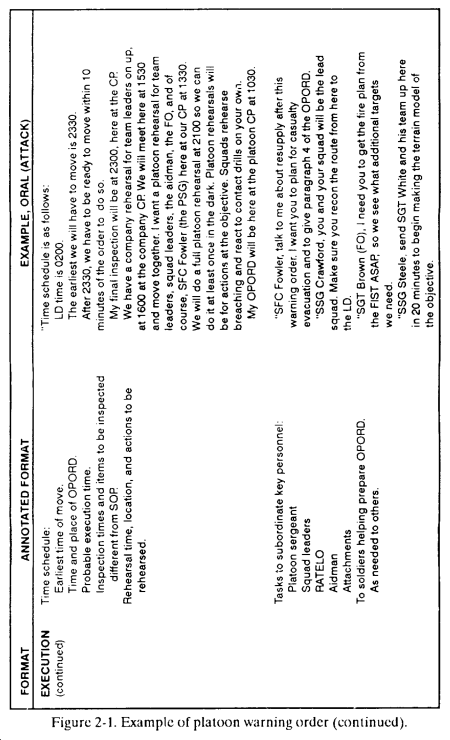

c. STEP 3. Make a Tentative Plan. The leader develops an estimate of the situation to use as the basis for his tentative plan. The estimate is the military decision making process. It consists of five steps: detailed mission analysis, situation analysis and course of action development, analysis of each course of action, comparison of each course of action, and decision. The decision represents the tentative plan. The leader updates the estimate continuously and refines his plan accordingly. He uses this plan as the start point for coordination, reconnaissance, task organization (if required), and movement instructions. He works through this problem solving sequence in as much detail as time available allows. As the basis of his estimate, the leader considers the factors of METT-T:
(1) Mission. The leader considers his mission as given to him by his commander. He analyzes it in light of the commander’s intent two command levels higher, and derives the essential tasks his unit must perform in order to accomplish the mission.
(2) Enemy. The leader considers the type, size, organization, tactics, and equipment of the enemy he expects to encounter. He identifies their greatest threat to his mission find their greatest vulnerability.
(3) Terrain.The leader considers the effect of terrain and weather on enemy and friendly forces using the guidelines below (OCOKA):
(a) Observation and fields of fire. The leader considers ground that allows him observation of the enemy throughout his area of operation. He considers fields of fire in terms of the characteristics of the weapons available to him; for example, maximum effective range, the requirement for grazing fire, and the arming range and time of flight for antiarmor weapons.
(b) Cover and concealment. The leader looks for terrain that will protect him from direct and indirect fires (cover) and from aerial and ground observation (concealment).
(c) Obstacles. In the attack, the leader considers the effect of restrictive terrain on his ability to maneuver. In the defense, he considers how he will tie in his obstacles to the terrain to disrupt, turn, fix, or block an enemy force and protect his own forces from enemy assault.
(d) Key terrain. Key terrain is any locality or area whose seizure or retention affords a marked advantage to either combatant. The leader considers key terrain in his selection of objectives, support positions, and routes in the offense, and on the positioning of his unit in the defense.
(e) Avenues of approach. An avenue of approach is an air or ground route of an attacking force of a given size leading to its objective or key terrain in its path. In the offense, the leader identifies the avenue of approach that affords him the greatest protection and places him at the enemy’s most vulnerable spot. In the defense, the leader positions his key weapons along the avenue of approach most likely to be used by the enemy.
(f) Weather. In considering the effects of weather, the leader is most interested in visibility and trafficability.
(4) Troops available. The leader considers the strength of subordinate units, the characteristics of his weapon systems, and the capabilities of attached elements as he assigns tasks to subordinate units.
(5) Time available. The leader refines his allocation of time based on the tentative plan and any changes to the situation.
d. STEP 4. Start Necessary Movement. The platoon may need to begin movement while the leader is still planning or forward reconnoitering. The platoon sergeant or a squad leader may bring the platoon forward, usually under the control of the company executive officer or first sergeant. This step could occur at any time during the troop-leading procedure.
e. STEP 5. Reconnoiter. If time allows, the leader makes a personal reconnaissance to verify his terrain analysis, adjust his plan, confirm the usability of routes, and time any critical movements. When time does not allow, the leader must make a map reconnaissance. The leader must consider the risk inherent in conducting reconnaissance forward of friendly lines. Sometimes the leader must rely on others (for example, scouts) to conduct the reconnaissance if the risk of contact with the enemy is high.
f. STEP 6. Complete the Plan. The leader completes his plan based on the reconnaissance and any changes in the situation. He should review his mission, as he received it from his commander, to ensure that his plan meets the requirements of the mission and stays within the framework of the commander’s intent.
g. STEP 7. Issue the Complete Order. Platoon and squad leaders normally issue oral operations orders.
(1) To aid subordinates in understanding the concept for the mission, leaders should issue the order within sight of the objective or on the defensive terrain. When this is not possible, they should use a terrain model or sketch.
(2) Leaders must ensure that subordinates understand the mission, the commander’s intent, the concept of the operation, and their assigned tasks. Leaders may require subordinates to repeat all of part of the order or demonstrate on the model or sketch, their understanding of the operation. They should also quiz their soldiers to ensure that all soldiers understand the mission. Chapter 5 provides a list of questions that leaders can ask to determine if the soldiers understand the mission.
h. STEP 8. Supervise. The leader supervises the unit’s preparation for combat by conducting rehearsals and inspections.
(1) Rehearsals. The leader uses rehearsals to–
- Practice essential tasks (improve performance).
- Reveal weaknesses or problems in the plan.
- Coordinate the actions of subordinate elements.
- Improve soldier understanding of the concept of the operation (foster confidence in soldiers).
(a) Rehearsals include the practice of having squad leaders brief their planned actions in execution sequence to the platoon leader.
(b) The leader should conduct rehearsals on terrain that resembles the actual ground, and in similar light conditions.
(c) The platoon may begin rehearsals of battle drills and other SOP items before the receipt of the operation order. Once the order has been issued, it can rehearse mission specific tasks.
(d) Some important tasks to rehearse include–
- Actions on the objective.
- Assaulting a trench, bunker, or building.
- Actions at the assault position.
- Breaching obstacles (mine and wire).
- Using special weapons or demolitions.
- Actions on unexpected enemy contact.
(2) Inspections. Squad leaders should conduct initial inspections shortly after receipt of the warning order. The platoon sergeant spot checks throughout the unit’s preparation for combat. The platoon leader and platoon sergeant make a final inspection. They should inspect–
- Weapons and ammunition.
- Uniforms and equipment.
- Mission-essential equipment.
- Soldier’s understanding of the mission and their specific responsibilities.
- Communications.
- Rations and water.
- Camouflage.
- Deficiencies noted during earlier inspections.
2-3. OPERATION ORDER FORMAT
An operation order (OPORD) is a directive issued by the leader to his subordinate leaders in order to effect the coordinated execution of a specific operation.
a. The leader briefs his OPORD orally from notes that follow the five-paragraph format below ( Figure 2-2 ).
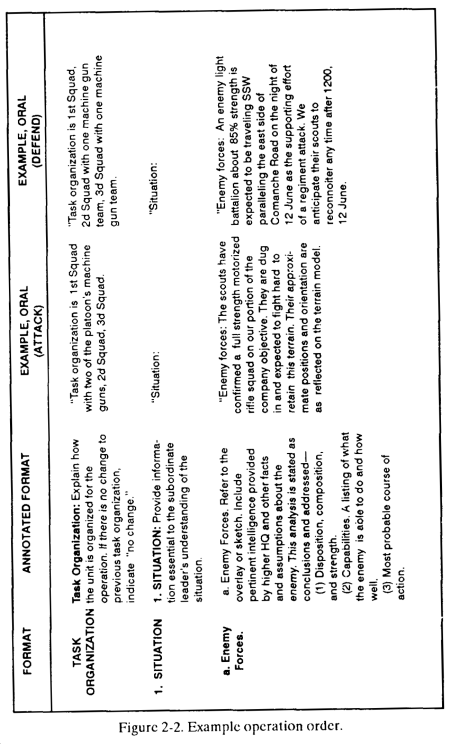
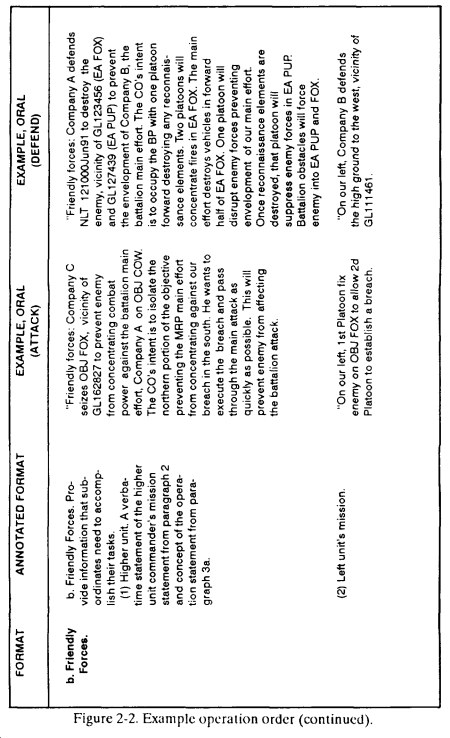
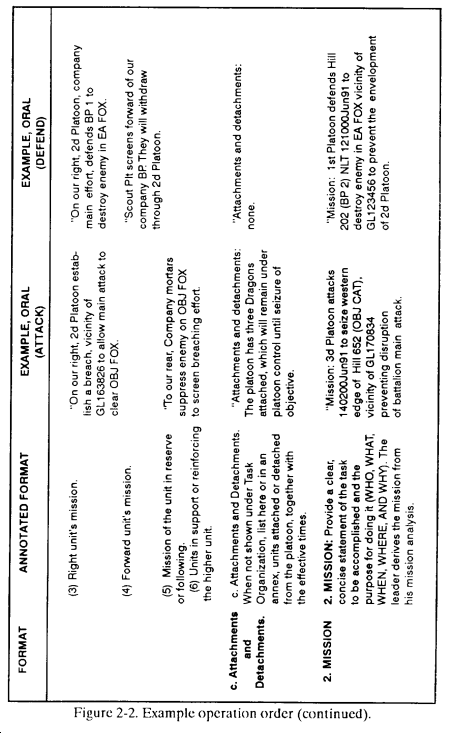


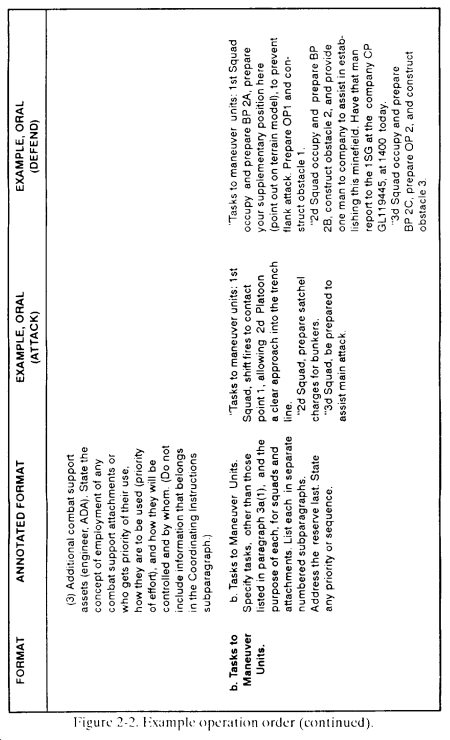
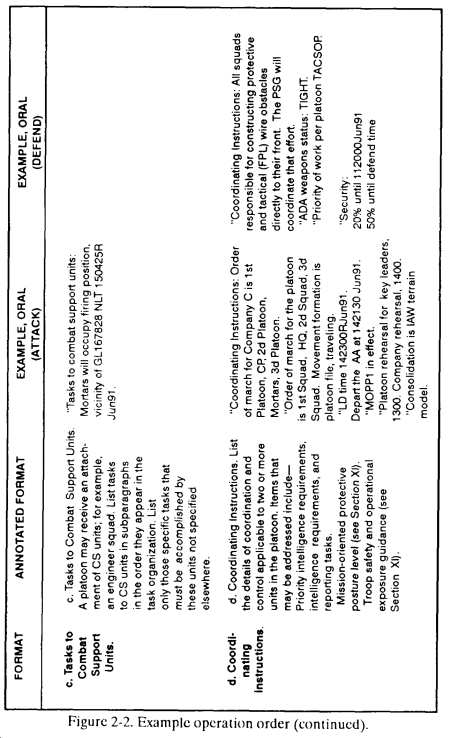

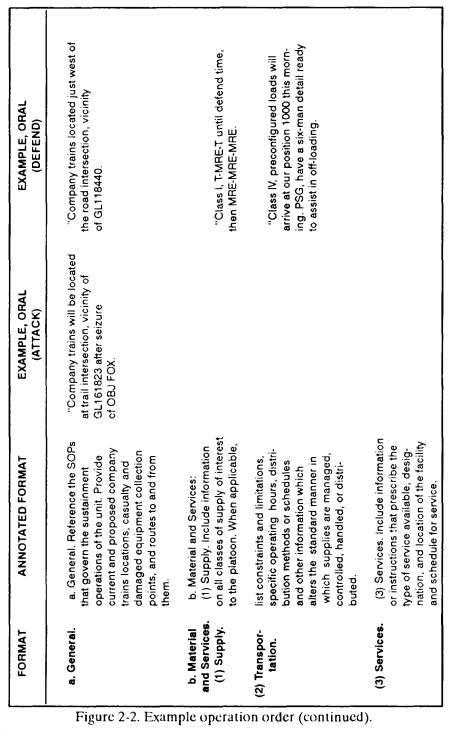


b. The leader uses a fragmentary order (FRAGO) to change an existing order. He normally uses the OPORD format, but addresses only those elements that have changed. The leader should make his instructions brief, simple, clear, and specific.
c. Annexes provide the instructions for conducting specific operations (such as air assault, boat and truck movement, stream crossings, establishing patrol bases, and airborne insertions), if they are so detailed that a platoon SOP is insufficient for a particular situation. The format is the same as the five-paragraph OPORD.
d. An operation overlay is a tracing of graphic control measures on a map. It shows boundaries, unit positions, routes, objectives, and other control measures. It helps to clarify the operation order. Platoons normally trace their overlays from the company operations map. Squad leaders transfer control measures on to their maps as needed. The subordinate’s need for higher unit graphics must be balanced against the risk of the enemy obtaining this information.
e. When possible, the leader uses the actual terrain or a terrain model to brief his OPORD. He may also use concept sketches–large, rough drawings of the objective areas–to show the flow of events and actions clearly.
(1) Concept sketch. The sketch shows the locations and positions of objectives, control measures, and key terrain in relation to each other. It is not necessarily drawn to scale.
(2) Terrain model. A terrain model is a three-dimensional scale model of the terrain (Figure 2-3). It is effective for briefing and discussing the actions on the objective. It may depict the entire mission area. However, for offense missions, priority should be given to building a model of the objective area.

(a) It should be built oriented to the ground (north on the model is north on the ground) and should show the main terrain features in the area.
(b) The next step after orienting the model to the ground is the construction of grid squares. The leader should identify the grid squares that the model will show. These ensure a more accurate model.
(c) The terrain model should depict key terrain, friendly control measures, and enemy dispositions.
(d) Materiel for constructing the model includes string, yarn (various colors), chalk (colored), 3x5 cards, target markers, or unit markers.
Section II. SECURITY
This section discusses techniques used by platoons and squads to provide security for themselves and for larger formations during movements and offensive and defensive operations.
2-4. SECURITY DURING MOVEMENT
Security during movement includes the actions that units take to secure themselves and the tasks given to units to provide security for a larger force.
a. Platoons and squads enhance their own security during movement through the use of covered and concealed terrain; the use of the appropriate movement formation and technique; the actions taken to secure danger areas during crossing; the enforcement of noise, light, and radiotelephone discipline; and the use of proper individual camouflage techniques.
(1) Terrain. In planning a movement, leaders consider the terrain from the aspect OCOKA as discussed in Section I. Leaders look for terrain that avoids obstacles, provides protection from direct and indirect fires and from ground and aerial observation, avoids key terrain that may be occupied by the enemy, allows freedom to maneuver, and avoids natural lines of drift or obvious terrain features. If key terrain cannot be avoided, leaders plan to reconnoiter it before moving through. When operating as an advance or flank guard for a larger force, platoons and squads may be tasked to occupy key terrain for a short time while the main body bypasses it.
(2) Formations and movement techniques. Formations and movement techniques provide security by–
- Positioning each soldier so that he can observe and fire into a specific sector that overlaps with other sectors.
- Placing a small element forward to allow the platoon to make contact with only the lead element and give the remainder of the platoon freedom to maneuver.
- Providing overwatch for a portion of the platoon.
In selecting formations and movement techniques leaders must consider other requirements such as speed and control as well as security. Section III provides a matrix to help leaders in determining the best formation and technique based on METT-T.
(3) Security at danger areas. Paragraph 2-11 describes actions taken by platoons and squads to secure danger areas before crossing them.
(4) Camouflage, noise, light, and radiotelephone discipline. Leaders must ensure that camouflage used by their soldiers is appropriate to the terrain and season. Platoon SOPs specify elements of noise, light, and radiotelephone discipline. (See Chapter 5 .)
b. Platoons and squads may operate as the advance, flank, or rear guard for larger units. They employ the same techniques described above to move as securely as possible. Section IV describes the techniques used by platoons executing a guard mission in a movement to contact.
c. During short halts, soldiers spread out and assume prone positions behind cover. They watch the same sectors that were assigned to them for the movement. Leaders establish OPs, and orient machine guns and antiarmor weapons along likely enemy approaches. Soldiers remain alert and keep movement to a minimum. During limited visibility, leaders incorporate the use of night vision devices.
d. During long halts, the platoon establishes a perimeter defense (See Chapter 1 ). The platoon leader ensures that the platoon halts on defensible terrain. He establishes the defense using the same considerations discussed in Section V.
e. For additional security during halts, the platoon leader may establish a squad-sized ambush. He must provide a specific location and instructions concerning the initiation and conduct of the ambush and the link-up of the squad with the platoon.
2-5. SECURITY IN THE OFFENSE
Security in the offense includes actions taken by platoons and squads to find the enemy, to avoid detection or prevent the detection of the larger body, and to protect the unit during the assault on the objective.
a. Movement to Contact. Platoons and squads execute guard or screening missions as part of a larger force in a movement to contact. (See Section III.)
b. Reconnaissance Patrols. Reconnaissance patrols are conducted before executing offensive operations to find the enemy and determine his strength and dispositions. Chapter 3 discusses techniques for platoons and squads conducting reconnaissance patrols.
c. Hasty and Deliberate Attacks. Platoons and squads use the same security techniques for movement discussed above while moving from assembly areas to the objective. The base-of-fire and maneuver elements of the platoon must provide their own security while executing their specific tasks.
(1) Base-of-fire element. The platoon sergeant or leader controlling the base-of-fire element should designate soldiers on the flanks of the position to provide observation and, if necessary, fires to the flanks while the element engages the enemy on the objective. The base-of-fire element also provides security to its rear.
(2) Maneuver element. The maneuver element must secure its own flanks and rear as it assaults across the objective. Platoon leaders should consider designating assaulting buddy teams to observe the flanks and rear. When clearing trenches, the platoon should be alert against local counterattacks along cleared portions of the trench behind the lead fire team. The base-of-fire element provides security for the maneuver element by engaging any counterattacking or reinforcing forces if it can do so without endangering the maneuver element with its own fires.
d. Consolidation. Platoons and squads move quickly to establish security during the consolidation of an objective. They do this by establishing OPs along likely approaches and by establishing overlapping sectors of fire to create all-round security. (See Section V.)
2-6. SECURITY IN THE DEFENSE
Security in the defense includes active and passive measures taken to avoid detection or deceive the enemy and to deny enemy reconnaissance elements accurate information on friendly positions.
a. Terrain. Leaders consider the terrain in terms of OCOKA as they plan for security in the defense. They look for terrain that will protect them from enemy observation and fires and, at the same time, provide observation and fires into the area where they intend to destroy the enemy or defeat his attack. When necessary leaders use defensive techniques, such as reverse slope or perimeter defense, to improve the security of the defensive position. Leaders plan protective obstacles to the flanks and rear of their positions and tie them in with supplementary fires. Leaders consider adjacent key terrain that threatens the security of their positions. They secure this terrain by posting OPs and by covering it with direct and indirect fires. Finally, leaders establish OPs along the most likely enemy approaches into the position or sector to provide early warning.
b. Observation Posts. Each platoon should post at least one OP. The platoon leader designates the general location for the OP and the routes to and from the OP. The squad leader establishing the OP selects the specific site. Section XII provides a detailed discussion of the techniques used by platoons and squads in establishing and manning OPs. When a platoon performs a screen mission for a larger force in a defense, it may establish squad-sized OPs that are well dispersed. The squads conduct patrolling missions between these OPs to establish the screen.
c. Patrols. Platoons should actively patrol the area to their front and flanks while in a defensive operation. These patrols should include observation of dead space, gaps between units, open flanks, and gaps or lanes in tactical and protective wire. Patrols may also be used to establish and relieve OPs. The platoon leader must ensure that all patrols not initiated by his higher headquarters are coordinated with them. Chapter 3 provides detailed discussion of patrolling techniques for platoons and squads.
d. Passive Measures. Platoons may be directed to cover specific areas of its sector with night vision devices, thermal sights, or early warning devices. These systems should be incorporated into the platoon sector sketch. Passive measures also include camouflage; movement control; and noise, light, and radiotelephone discipline.
e. Deceptive Measures. Deceptive measures includes actions that platoons and squads may take to mislead the enemy and induce him to do something counter to his interests. Platoons may employ deceptive measures for local security such as dummy positions or supplemental wire.
f. Deception Operations. Platoons may conduct deception operations as part of a larger force. These operations may include demonstrations, feints, displays, or ruses. In most instances platoons execute missions as normal but on a limited scale (feint), or to present a false picture to the enemy.
Section III. MOVEMENT
This section discusses formations, movement techniques, and actions during movement for infantry platoons and squads.
2-7. FIRE TEAM FORMATIONS
Formation are arrangements of elements and soldiers in relation to each other. Squads use formations for control flexibility and security. Leaders choose formations based on their analysis of the factors of METT-T. Figure 2-6, compares formations. Leaders are up front in formations. This allows the fire team leader to lead by example, “Follow me and do as I do.” All soldiers in the team must be able to see their leader.

a. Wedge. The wedge is the basic formation for the fire team. The interval between soldiers in the wedge formation is normally 10 meters. The wedge expands and contracts depending on the terrain. When rough terrain, poor visibility, or other factors make control of the wedge difficult, fire teams modify the wedge. The normal interval is reduced so that all team members can still see their team leader and the team leaders can still their squad leader. The sides of the wedge can contract to the point where the wedge resembles a single file. When moving in less rugged terrain, where control is easier, soldiers expand or resume their original positions. (Figure 2-4).
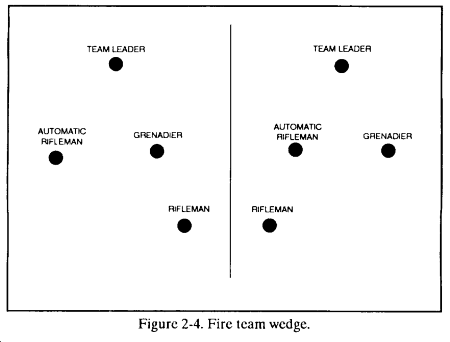
b. File. When the terrain precludes use of the wedge, fire teams use the file formation (Figure 2-5).
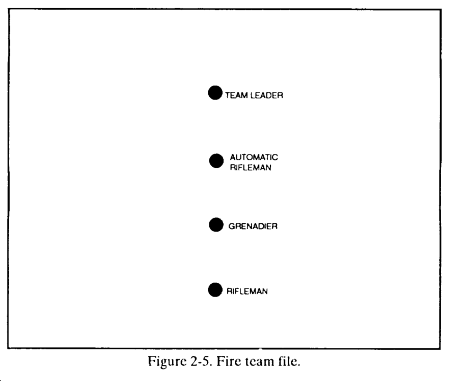
2-8. SQUAD FORMATIONS
Squad formations describe the relationships between fire teams in the squad. They include the squad column and squad line. A comparison of the formations is in Figure 2-10.
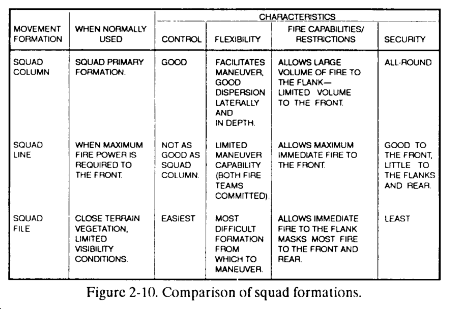
a. Squad Column. The squad column is the squad’s most common formation. It provides good dispersion laterally and in depth without sacrificing control, and facilitates maneuver. The lead fire team is the base fire team. When the squad moves independently or as the rear element of the platoon, the rifleman in the (rail fire team provides rear security (Figure 2-7).
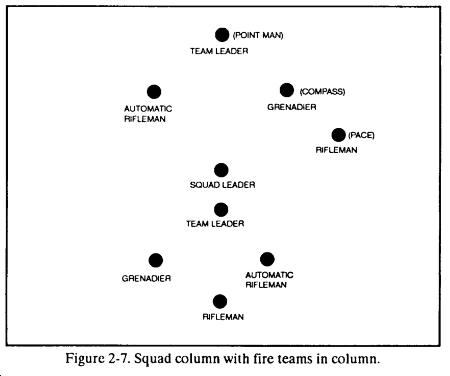
b. Squad Line. The squad line provides maximum firepower to the front (Figure 2-8). When a squad is acting as the base squad, the fire team on the right is the base fire team.
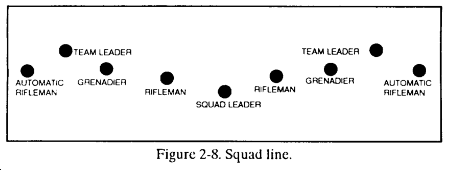
c. Squad File. When not traveling in a column or line, squads travel in file. The squad file has the same characteristics as the fire team file. If the squad leader desires to increase his control over the formation, exert greater morale presence by leading from the front, and be immediately available to make key decisions, he will move forward to the first or second position. Additional control over the rear of the formation can be provided by moving a team leader to the last position. (Figure 2-9.)
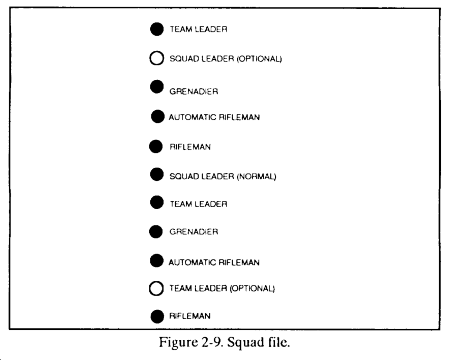
2-9. PLATOON FORMATIONS
Platoon formations include the platoon column, the platoon line (squads on line or in column), the platoon vee and the platoon wedge. The leader should weigh these carefully to select the best formation based on his mission and on METT-T analysis. A comparison of the formations is in Figure 2-17.

a. Platoon Column. This formation is the platoon’s primary movement formation (Figure 2-11). It provides good dispersion both laterally and in depth, and simplifies control. The lead squad is the base squad.
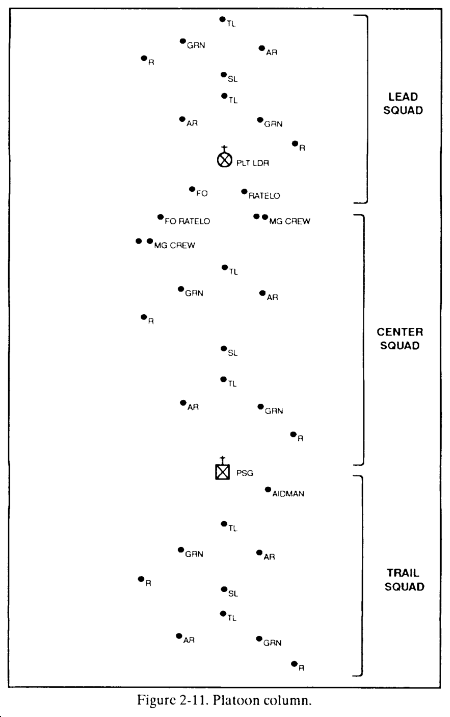
NOTE: METT-T will determine where crew-served weapons move in the formation. They normally move with the platoon leader so he can quickly establish a base of fire.
b. Platoon-Line, Squads-on-Line. This formation allows the delivery of maximum fire to the front but little fire to the flanks (Figure 2-12). This formation is hard to control, and it does not lend itself well to rapid movement. When two or more platoons are attacking, the company commander chooses one of them as the base platoon. The base platoon’s center squad is its base squad. When the platoon is not acting as the base platoon, its base squad is its flank squad nearest the base platoon. The machine guns can move with the platoon, or they can support by fire from a support position (not shown). This is the basic platoon assault formation.
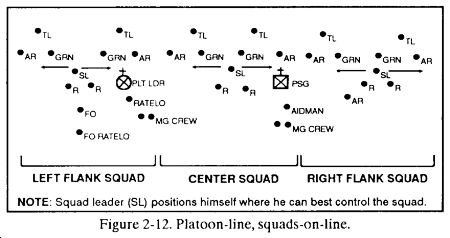
c. Platoon-Line, Squads-in-Column. The platoon leader can use this formation when he does not want to deploy all personnel on line, and when he wants the squads to react to unexpected contact (Figure 2-13). This formation is easier to control, and it lends itself better to rapid movement than the platoon-line or squads-on-line formation; however, it is harder to control than and does not facilitate rapid movement as well as a platoon column. When two or more platoons are moving, the company commander chooses one of them as the base platoon. The base platoon’s center squad is its base squad. When the platoon is not the base platoon, its base squad is its flank squad nearest the base platoon.
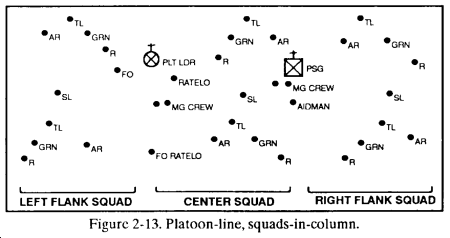
d. Platoon Vee. This formation has two squads up front to provide a heavy volume of fire on contact (Figure 2-14). It also has one squad in the rear that can either overwatch or trail the other squads. This formation is hard to control; movement is slow The platoon leader designates one of the front squads to be the platoon’s base squad.
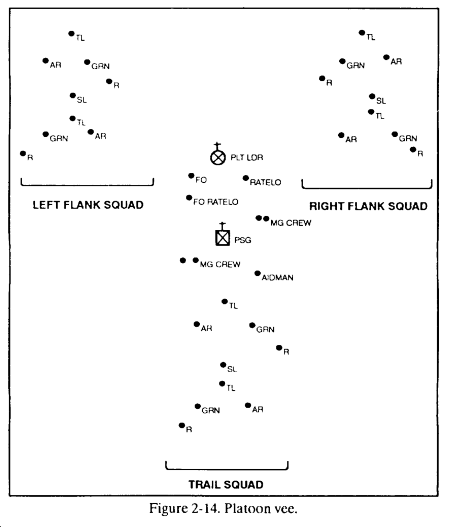
e. Platoon Wedge. This formation has two squads in the rear that can overwatch or trail the lead squad (Figure 2-15). It provides a large volume of fire to the front or flanks. It allows the platoon leader to make contact with a squad and still have one or two squads to maneuver. The lead squad is the base squad.

f. Platoon File. This formation may be set up in several methods. One method is to have three-squad files follow one another using one of the movement techniques. Another method is to have a single platoon file with a front security element (point) and flank security elements. This formation is used when visibility is poor due to terrain, vegetation, or light conditions. (Figure 2-16.) The distance between soldiers is less than normal to allow communication by passing messages up and down the file. The platoon file has the same characteristics as the fire team and squad files.
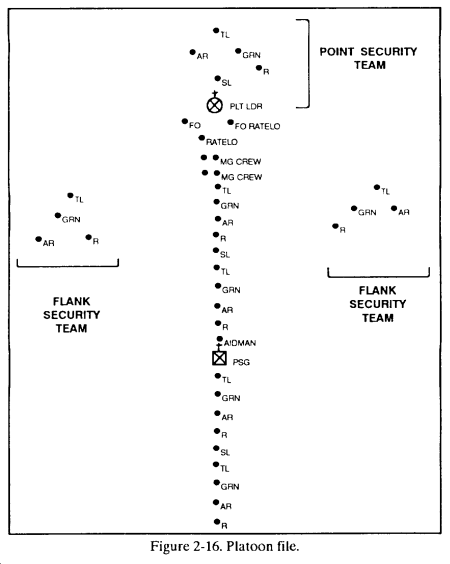
2-10. MOVEMENT TECHNIQUES
A movement technique is the manner a platoon uses to traverse terrain. There are three movement techniques: traveling, traveling overwatch, and bounding overwatch. The selection of a movement technique is based on the likelihood of enemy contact and the need for speed. Factors to consider for each technique are control, dispersion, speed, and security (Figure 2-18). Movement techniques are not fixed formations. They refer to the distances between soldiers, teams, and squads that vary based on mission, enemy, terrain, visibility, and any other factor that affects control. Soldiers must be able to see their fire team leader. The squad leader must be able to see his fire team leaders. The platoon leader should be able to see his lead squad leader. Leaders control movement with arm-and-hand signals. They use radios only when needed. Any of the three movement techniques (traveling, traveling overwatch, bounding overwatch) can be used with any formation.
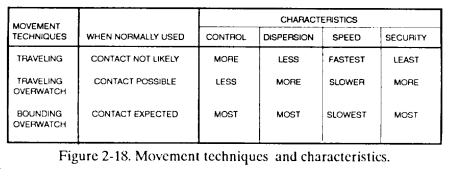
a. Techniques of Squad Movement. The platoon leader determines and directs which movement technique the squad will use.
(1) Traveling. Traveling is used when contact with the enemy is not likely and speed is needed (Figure 2-19).

(2) Traveling overwatch. Traveling overwatch is used when contact is possible (Figure 2-20). Attached weapons move near the squad leader and under his control so he can employ them quickly.
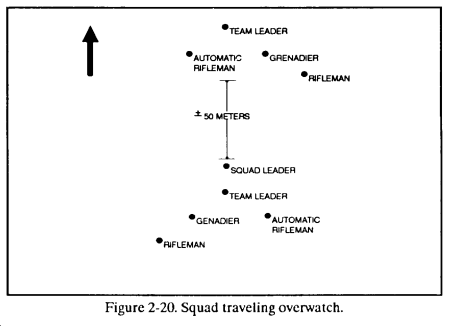
(3) Bounding overwatch. Bounding overwatch is used when contact is expected, when the squad leader feels the enemy is near (movement, noise, reflection, trash, fresh tracks, or even a hunch), or when a large open danger area must be crossed.
(a) The lead fire team overwatches first. Soldiers scan for enemy positions. The squad leader usually stays with the overwatch team. (Figure 2-21).
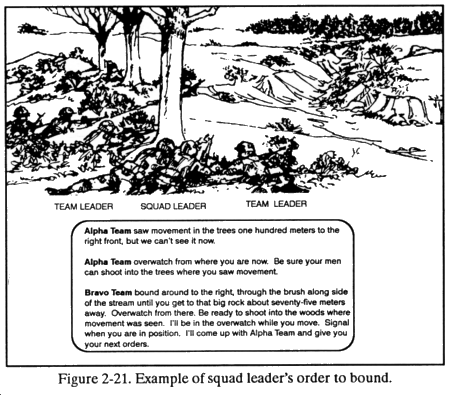
(b) The trail fire team bounds and signals the squad leader when his team completes its bound and is prepared to overwatch the movement of the other team.
(c) Both team leaders must know if successive or alternate bounds will be used and which team the squad leader will be with. The overwatching team leader must know the route and destination of the bounding team. The bounding team leader must know his team’s destination and route, possible enemy locations, and actions to take when he arrives there. He must also know where the overwatching team will be, and how he will receive his instructions. The cover and concealment on the bounding team’s route dictates how its soldiers move.
(d) Teams can bound successively or alternately. Successive bounds are easier to control; alternate bounds can be faster. (Figure 2-22.)
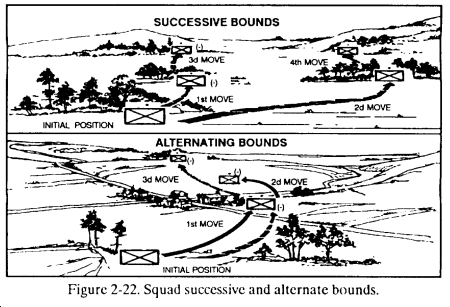
b. Techniques of Platoon Movement. The platoon leader determines and directs which movement technique the platoon will use.
(1) Traveling. Traveling is used when enemy contact is not likely and speed is needed (Figure 2-23).
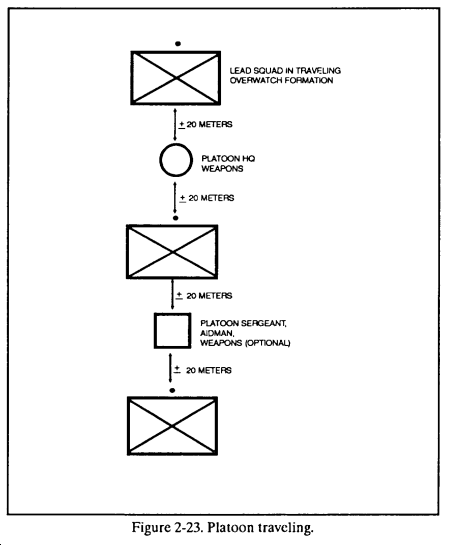
(2) Traveling overwatch. Traveling overwatch is used when contact is possible but speed is needed (Figure 2-24). The platoon leader moves where he can best control the platoon. The platoon sergeant travels with the trailing squad, though he is free to move throughout the formation to enforce security, noise and light discipline, and distances between squads. The lead squad uses traveling overwatch, and the trailing squads use traveling.
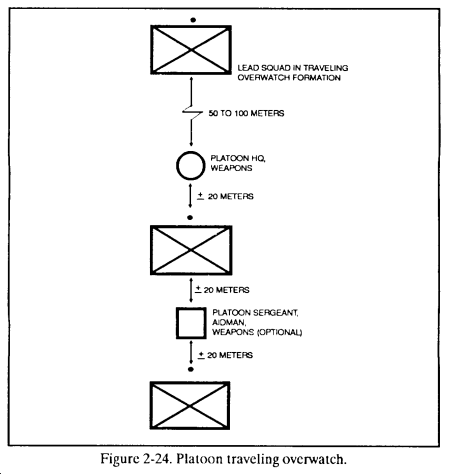
(3) Bounding overwatch. Bounding overwatch is used when contact is expected (Figure 2-25). Platoons conduct bounding overwatch using successive or alternate bounds.
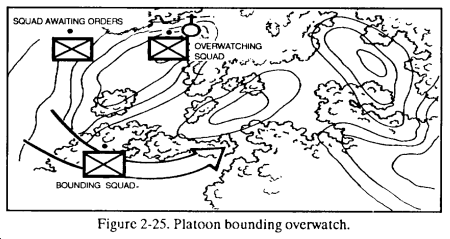
(a) One squad bounding. One squad bounds forward to a chosen position, then it becomes the overwatching element unless contact is made en route. The bounding squad can use either traveling overwatch, bounding overmatch, or individual movement techniques (low and high crawl, and short rushes by fire team or pairs).
(b) One squad overwatching. One squad overwatches the bounding squad from covered positions from which it can see and suppress likely enemy positions. Soldiers use sunning techniques to view their assigned sector. The platoon leader remains with the overmatching squad. Normally, the platoon’s machine guns are located with the overwatching squad also.
(c) One squad awaiting orders. One squad is uncommitted and ready for employment as directed by the platoon leader. The platoon sergeant and the leader of the squad awaiting orders position themselves close to the platoon leader.
(d) Considerations. When deciding where to have his bounding squad go, a platoon leader considers–
- The requirements of the mission.
- Where the enemy is likely to be.
- The routes to the next overwatch position.
- The ability of an overwatching element’s weapons to cover the bound.
- The responsiveness of the rest of the platoon.
- The fields of fire at the next overwatch position.
(e) Instructions. Before a bound, the platoon leader gives an order to his squad leaders from the overwatch position (Figure 2-26). He tells and shows them the following:
- The direction or location of the enemy (if known).
- The positions of the overwatching squad.
- The next overwatch position.
- The route of the bounding squad.
- What to do after the bounding squad reaches the next position.
- What signal the bounding squad will use to announce it is prepared to overwatch.
- How the squad will receive their next orders.
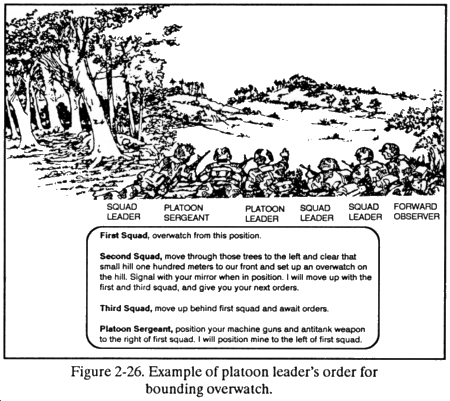
(f) Machine guns. The machine guns are normally employed in one of two ways:
- Attach both guns to the overwatch squad(s).
- One machine gun with the overwatch squad and the other with the bounding squad. This technique requires the guns to move between squads as they leave the overwatch to join the bounding squad.
c. Individual Movement Techniques. Individual movement techniques include the high and low crawl and short rushes (three to five seconds) from one covered position to another. (See FM 21-75 .)
d. Other Movement Situations. The platoon can use other formations for movement.
(1) Movement with armored vehicles. For a detailed discussion of working with armored vehicles, see Section IX.
(2) Movement by water. The platoon avoids crossing water obstacles when possible. Leaders should identify weak or nonswimmers and pair them with a good swimmer in their squad.
(a) When platoons or squads must move into, through, or out of rivers, lakes, streams, or other bodies of water, they treat the water obstacle as a danger area. While on the water, the platoon is exposed and vulnerable. To offset the disadvantages, the platoon–
- Moves during limited visibility.
- Disperses.
- Camouflages thoroughly.
- Moves near the shore to reduce the chances of detection.
(b) When moving in more than one boat, the platoon–
- Maintains tactical integrity and self-sufficiency.
- Cross loads key soldiers and equipment.
- Makes sure that the radio is with the leader.
(c) If boats are not available, several other techniques can be used such as–
- Swimming.
- Poncho rafts.
- Air mattresses.
- Waterproof bags.
- A 7/16-inch rope used as a semisubmersible one-rope bridge or safety line.
- Water wings (made from a set of trousers).
(3) Tactical marches. Platoons conduct two types of tactical marches with the company. They are foot marches and motor marches.
(a) Foot marches. See FM 21-18.
(b) Motor marches. The platoon conducts motor marches like any other tactical movement. Special requirements may include–
- Protection. Sandbagging the bottom of the truck to protect the soldiers from mines.
- Observation. Removing bows and canvas to allow 360-degree observation and rapid dismount.
- Inspection. Inspecting vehicle and driver to ensure they are ready. Checking fuel level and driver’s knowledge of the route, speed, and distance between vehicles.
- Loading. The platoon should load vehicles keeping fire team, squad, and platoon integrity. For example, fire teams and squads intact on the same vehicle and platoons in the same serial. Additionally, key leaders, weapons, and equipment should be cross loaded.
- Rehearsals. Rehearsing immediate action to enemy contact (near and far ambush, air attack) ensuring the driver knows what to do.
- Air guards. Posting air guards for each vehicle.
(4) Movement during limited visibility conditions. At night or when visibility is poor, a platoon must be able to function the same as during day. It must be able to control, navigate, maintain security, move, and stalk at night or during limited visibility.
(a) Control. When visibility is poor, the following methods aid in control:
-
Selected personnel use of night vision devices.
-
Leaders move closer to the front.
-
The platoon reduces speed.
-
Each soldier uses two small strips of luminous tape on the rear of his helmet to allow the soldier behind him to see.
-
Leaders reduce the interval between soldiers and between units to make sure they can see each other.
-
Leaders conduct headcounts at regular intervals and after each halt to ensure personnel accountability.
(b) Navigation. To assist in navigation during limited visibility, leaders use–
-
Terrain association (general direction of travel coupled with recognition of prominent map and ground features).
-
Dead reckoning (compass direction and specific distances or legs). At the end of each leg, leaders should verify their location.
-
Movement routes that parallel identifiable terrain features.
-
Guides or marked routes.
-
GSRs to vector units to the proper location.
-
Position-location devices.
(c) Security. For stealth and security in night moves, squads and platoons–
-
Designate a point man to maintain alertness, the lead team leader to navigate, and a pace man to count the distance traveled. Alternate compass and pace men are designated.
-
Allow no smoking, no lights, and no noise.
-
Use radio-listening silence.
-
Camouflage soldiers and equipment.
-
Use terrain to avoid detection by enemy surveillance or night vision devices.
-
Make frequent listening halts.
-
Mask the sounds of movement with artillery fires.
(d) Night walking. Proficiency in night walking is gained through practice. A soldier walking at night looks ahead, then slowly lifting his right foot, he cases it forward about 6 inches to the front of the left foot. While easing his foot forward and keeping his toes pointed downward, the soldier feels for twigs and trip wires. He slowly places his foot on the ground. Confident of solid, quiet footing, the soldier slowly moves his weight forward, hesitates, then repeats the process with the other foot. This technique is slow and time-consuming.
(e) Stalking. Soldiers stalk to get as close as they can to an enemy sentry, patrol, or base. This is best described as a slow, crouching night walk. The soldier watches the enemy continuously. When close to the enemy, the soldier squints to help conceal light reflected by his eyes. He breathes slowly through his nose. If the enemy looks in his direction, the soldier freezes. He takes advantage of the background to blend with shadows and to prevent glare or contrast. Soldiers move during distractions such as gusts of wind, vehicle movement, loud talking, or nearby weapons fire.
2-11. ACTIONS AT DANGER AREAS
A danger area is any place on a route where the leader’s estimate process tells him that his platoon might be exposed to enemy observation, fire, or both. Platoons try to avoid danger areas. If a platoon must cross a danger area, it does so with great caution and as quickly as possible.
a. Types of Danger Areas. The following are some examples of danger areas and crossing procedures.
(1) Open areas. Conceal the platoon on the near side and observe the area. Post security to give early warning. Send an element across to clear the far side. When cleared, cross the remainder of the platoon at the shortest exposed distance and as quickly as possible.
(2) Roads and trails. Cross roads or trails at or near a bend, a narrow spot, or on low ground.
(3) Villages. Pass villages on the downwind side and well away from them. Avoid animals, especially dogs, which might reveal the presence of the platoon.
(4) Enemy positions. Pass on the downwind side (the enemy might have scout dogs). Be alert for trip wires and warning devices.
(5) Minefields. Bypass minefields if at all possible–even if it requires changing the route by a great distance. Clear a path through minefields only if necessary.
(6) Streams. Select a narrow spot in the stream that offers concealment on both banks. Observe the far side carefully. Emplace near and far-side security for early warning. Clear the far side, then cross rapidly but quietly.
(7) Wire obstacles. Avoid wire obstacles (the enemy covers obstacles with observation and fire).
b. Crossing of Danger Areas. When the platoon crosses a danger area independently or as the lead element of a larger force, it must–
-
Designate near- and far-side rally points.
-
Secure the near side (right, left flanks, and rear security).
-
Reconnoiter and secure the far side.
-
Execute crossing the danger area.
(1) The platoon leader or squad leader decides how the unit will cross based on the time he has, the size of the unit, the size of the danger area, the fields of fire into the area, and the amount of security he can post. A small unit may cross all at once, in buddy teams, or one soldier at a time. A large unit normally crosses its elements one at a time. As each element crosses, it moves to an overwatch position or to the far-side rally point until told to continue movement.
(2) To maintain momentum, mailing platoons normally cross the danger area without conducting their own reconnaissance or establishing far-side security. The lead platoon conducts reconnaissance and maintains far-side security for the whole force.
NOTE: The secured area must be large enough to allow the full deployment of the remainder of the unit.
c. Crossing of linear Danger Areas (Platoon). The platoon crosses the danger area in the formation and location specified by the platoon leader. On the far side of the danger area, platoon personnel and equipment are accounted for. The platoon continues the mission. (Figure 2-27.)

(1) When the lead team signals “danger area” (relayed throughout the platoon), the platoon halts.
(2) The platoon leader moves forward, confirms the danger area, and determines what technique the platoon will use to cross. The platoon sergeant also moves forward to the platoon leader.
(3) The platoon leader informs all squad leaders of the situation and the near-side and far-side rally points.
(4) The platoon sergeant directs positioning of the near-side security (usually conducted by the trail squad). These two security teams may follow him forward when the platoon halts and a danger area signal is passed back.
(5) The platoon leader reconnoiters the danger area and selects the crossing point that provides the best cover and concealment.
(6) Near-side security observes to the flanks and overmatches the crossing.
(7) When the near-side security is in place, the platoon leader directs the far-side security team to cross the danger area.
(8) The far-side security team clears the far side.
(9) The far-side security team leader establishes an OP forward of the cleared area.
(10) The far-side security team signals to the squad leader that the area is clear. The squad leader relays the message to the platoon leader.
(11) The platoon leader selects the method the platoon will use to cross the danger area.
(12) The platoon quickly and quietly crosses the danger area.
(13) Once across the danger area, the main body begins moving slowly on the required azimuth.
(14) The near-side security element, controlled by the platoon sergeant, crosses the danger area where the platoon crossed. They may attempt to cover any tracks left by the platoon.
(15) The platoon sergeant ensures everyone crosses and sends up the report.
(16) The platoon leader ensures accountability and resumes movement at normal speed.
NOTE: The same principles stated above are used when crossing a smaller unit across a danger area.
d. Crossing of Large Open Areas. This is an area so large (hat the platoon cannot bypass due to the time to accomplish the mission (Figure 2-28). A combination of (raveling overwatch and bounding overwatch is used to cross the open area. The traveling overwatch technique is used to save time. At any point in the open area where contact may be expected or once the squad or platoon comes within range of small-arms fire of the far side (about 250 meters), the squad or platoon moves using the bounding overwatch technique. Once beyond the open area, the squad or platoon reforms and continues the mission.
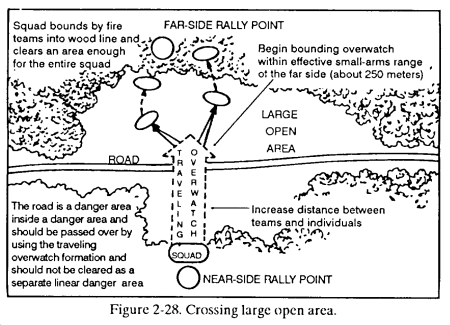
e. Crossing of Small Open Areas. This is an open area small enough so that it may be bypassed in the time allowed for the mission. Two techniques can be used:
(1) Detour bypass method. By the use of 90-degree turns to the right or left, the squad or platoon moves around the open area until the far side is reached, then continues the mission. The pace count of the offset and return legs is not added to the distance of the planned route.
(2) Contouring around the open area. The leader designates a rally point on the far side with the movement azimuth, decides which side of the open area to contour around (after considering the distance, terrain, cover and concealment), and moves around the open area. He uses the wood line and vegetation for cover and concealment. When the squad or platoon arrives at the rally point on the far side, the leader reassumes the azimuth to the objective area and continues the mission (Figure 2-29).

f. Enemy Contact at Danger Areas. If the platoon makes enemy contact in or around the danger area, see Figure 2-30 for contact on far side, Figure 2-31 for contact on a road or trail, or Figure 2-32 for contact on near side.
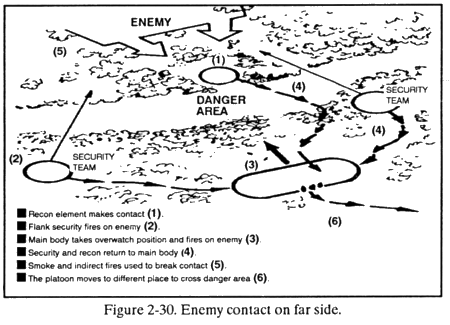
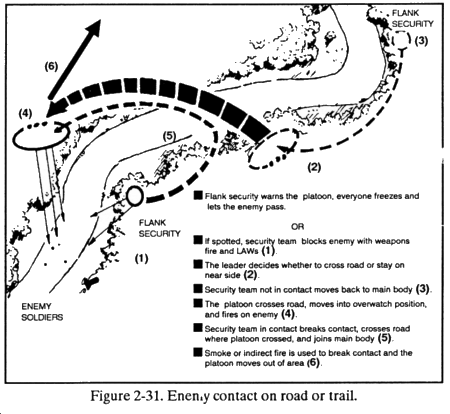

NOTE: Squads react to contact the same as platoons.
Section IV. OFFENSE
This section provides techniques and procedures for offensive missions. It includes movement to contact, deliberate attack, and consolidation and reorganization on the objective.
2-12. MOVEMENT TO CONTACT
Infantry units use two techniques for conducting a movement to contact–search and attack or approach march. The platoon leader selects the technique based on the expected enemy situation. Search and attack is used when the enemy is dispersed, when the enemy is expected to avoid contact or quickly disengage and withdraw, or to deny him movement in an area. The approach march may be used when the enemy is expected to deploy using relatively fixed offensive or defensive formations.
a. Search and Attack Technique. The search and attack technique involves the use of multiple squads and fire teams coordinating their actions to make contact with the enemy. Platoons attempt to find the enemy, and then fix and finish him. They combine patrolling techniques with the requirement to conduct hasty or deliberate attacks once the enemy has been found. Planning considerations include–
-
The factors of METT-T.
-
The requirement for decentralized execution. (The platoon leader coordinates the actions of squads.)
-
The requirement for mutual support. (The platoon leader must be able to respond to contact with his other squads not in contact.)
-
The length of operations. (The plan may need to address continuous operations.)
-
The soldier’s load. (Search and attack requires stealth.)
-
Resupply and MEDEVAC.
-
The positioning of key leaders and personnel.
-
The employment of key weapons.
-
The requirement for patrol bases.
-
The concept for entering the zone of action.
-
The concept for linkups. (All leaders must know how they will linkup once contact is made.)
b. Approach March Technique. The concept behind the approach march is to make contact with the smallest element, allowing the commander the flexibility of maneuvering or bypassing the enemy force. As part of a larger unit using the approach march technique, platoons may act as the advance, flank, or rear guard. They may also receive on-order missions as part of the main body.
(1) Advance guard. As the advance guard, the platoon finds the enemy and locates gaps, flanks, and weaknesses in his defense. The advance guard attempts to make contact on ground of its own choosing, to gain the advantage of surprise, and to develop the situation (either fight through or support the assault of all or part of the main body). The advance guard operates within the range of the main body’s indirect fire support weapons.
(a) One rifle squad leads the advance guard.
(b) The platoon uses appropriate formations and movement techniques. (See Figure 2-33.)
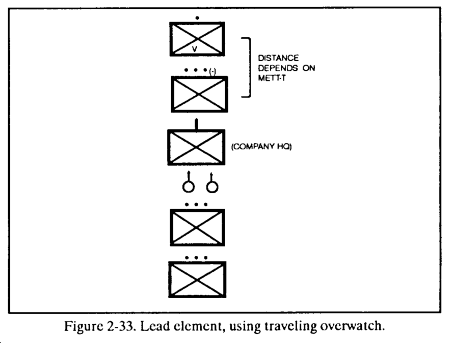
(c) The leader rotates the lead squad as necessary to keep soldier fresh.
(2) Flank or rear guard. The entire platoon may act as the flank or rear guard for a battalion conducting a movement to contact using this technique. The platoon–
-
Moves using the appropriate formation and movement technique. It must maintain the same momentum as the main body.
-
Provides early warning.
-
Destroys enemy reconnaissance units.
-
Prevents direct fires or observation of the main body.
(3) Main body. When moving as part of the main body, platoons may be tasked to assault, bypass, or fix an enemy force; or seize, secure, or clear an assigned area. The platoon may also be detailed to provide squads as flank guards, stay-behind ambushes, rear security, or additional security to the front. These squads may come under the direct control of the company commander. Platoons and squads use appropriate formations and movement techniques, assault techniques, and ambush techniques.
2-13. DELIBERATE ATTACK
Platoons and squads conduct deliberate attacks as part of a larger force.
a. Planning Considerations. The leader uses the troop-leading procedure and the estimate of the situation to develop his plan (see Section I).
(1) The platoon can expect to be a base-of-fire element or an assault element. If the platoon receives the mission to conduct a supporting attack for the company, or to attack a separate objective, the platoon leader should constitute a base-of-fire element and an assault element. The platoon leader’s decision to employ his squads depends on the ability to achieve suppressive fires against the objective, the need for firepower in the assault, and the requirement for a reserve to retain the freedom to maneuver. If the platoon is the company main effort, the platoon leader can retain less of his platoon as a reserve. If the platoon is the supporting effort, the platoon leader may require up to a squad as a reserve. The platoon leader may employ his squads in one of the following ways:
(a) Two squads and one or both machine guns as the base-of-fire element and one squad (with the remaining machine gun) as the assault element.
(b) One squad and one or both machine guns as the base-of-fire element and two squads (with the remaining machine gun) as the assault element.
(c) One squad and one or both machine guns as the base-of-fire element, one squad as the assault element, and one squad (with the remaining machine gun) to follow and support the assault element. This method generally supports the organization of the platoon for breaching obstacles during the assault.
(2) Additionally, if the company commander’s concept calls for decentralized execution, the platoon leader must consider his objective, a vulnerable flank or exploitable weakness, routes, movement and fire control measures, and formations and movement techniques. The platoon leader considers these along with the factors of METT-T and the commander’s intent to develop a scheme of maneuver and a fire support plan.
b. Movement to the Objective. Platoons and squads use the appropriate formations and movement techniques to avoid contact and achieve surprise (see Section III). The platoon must remain undetected. If detected early, the platoon concentrates direct and indirect fires, establishes a base of fire, and maneuvers to regain the initiative.
(1) Movement from the assembly area to the line of departure. The platoon moves forward from the assembly area under company control. When the platoon leader is already forward with the company commander, the platoon sergeant moves the platoon forward. Machine guns and antiarmor weapons can precede the rest of the platoon by moving to an overwatch position on or near the LD. Leaders time the move from the assembly area during reconnaissance or rehearsals to ensure that the lead squad crosses the LD on time and at the right place. The platoon attempts to cross the LD without halting in an attack position. If the platoon must halt in the attack position, it deploys into the initial attack formation, posts security, and takes care of last-minute coordination. Whether or not the platoon halts in the attack position, it must deploy into the attack formation and fix bayonets before crossing the LD.
(2) Movement from the line of departure to the assault position or support position. The platoon moves using the appropriate technique. If it has its own support and assault elements, it may move them together for security, or along separate routes to their respective positions, for speed. The base-of-fire element must be in place and ready before the assault element continues beyond the assault position.
(a) The platoon leader’s plan must address actions on chance contact. The lead squad executes the battle drill to react to contact (see Chapter 4, Battle Drill 2 ). The platoon leader makes an assessment and reports. The company commander may direct the platoon to fight through, fix, and bypass the enemy, or establish a hasty defense.
(b) If the platoon encounters an obstacle that it cannot bypass, it attempts a breach (see Section X and Chapter 4, Battle Drill 8 ).
(c) If the company concept calls for decentralized execution, the platoon leader must consider when to initiate his supporting fires.
-
Surprise. If the attack is not detected, the base-of-fire element may hold fires until the assault element approaches the assault position. This will enhance surprise. The base-of-fire element may initiate fires early to keep the enemy’s attention off the assault element as it moves to a flanking or rear position.
-
Suppression. The leader must consider the length of time needed to suppress the enemy position and destroy as many of his weapons and bunkers as possible before the assault.
(3) Movement from the assault position to the objective. The assault position is normally the last covered and concealed position before reaching the objective.
(a) As it passes through the assault position, the platoon deploys into its assault formation; that is, its squads and fire teams deploy to place the bulk of their firepower to the front as they assault the objective. A platoon sometimes must halt to complete its deployment and to ensure synchronization so that all squads assault at the designated time.
NOTE: Platoons should avoid halting in the assault position, because it is dangerous and may cause the loss of momentum.
(b) The assaulting squads move from the assault position and onto the objective. The platoon must be prepared to breach the enemy’s protective obstacles.
(c) As the platoon moves beyond the obstacle, supporting fires should begin lifting and shifting away from the objective. Both direct and indirect fires shift to suppress areas adjacent to the objective, to destroy enemy forces retreating, or to prevent enemy reinforcement oft he objective.
c. Assaulting the Objective. As the platoon or its assault element moves onto the objective, it must increase the volume and accuracy of fires. Squad leaders assign specific targets or objectives for their fire teams. Only when these discreet fires keep the enemy suppressed can the rest of the unit maneuver. As the assault element gets closer to the enemy, there is more emphasis on suppression and lesson maneuver. Ultimately, all but one fire team may be suppressing to allow that one fire team to break in to the enemy position. Throughout the assault, soldiers use proper individual movement techniques, and fire teams retain their basic shallow wedge formation. The platoon does not get “on-line” to sweep across the objective.
d. Consolidation and Reorganization. Once enemy resistance on the objective has ceased, the platoon must quickly take steps to consolidate and prepare to defend against a counterattack.
(1) Consolidation techniques. Platoons use either the clock technique or the terrain feature technique in consolidating on the objective.
NOTE: All-round security is critical. The enemy might counterattack from any direction. The platoon leader must evaluate the terrain thoroughly.
(a) Clock technique. In using this method, the platoon leader designates either a compass direction or the direction of attack as 12 o’clock. He then uses clock positions to identify the left and right boundaries for squads. The platoon leader positions key weapons along the most likely avenue of approach based on his assessment of the terrain. (See Figure 2-34.)
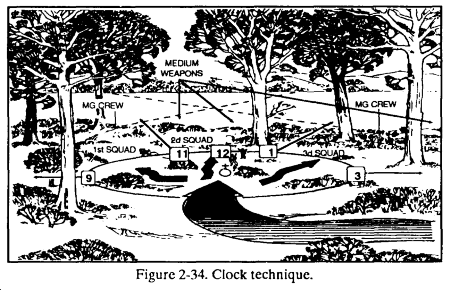
(b) Terrain feature technique. In a similar manner, the platoon leader identifies obvious terrain features as the left and right limits for squads. In both techniques, he ensures that squad sectors of fire overlap each other and provide mutual support for adjacent units. (Figure 2-35.)
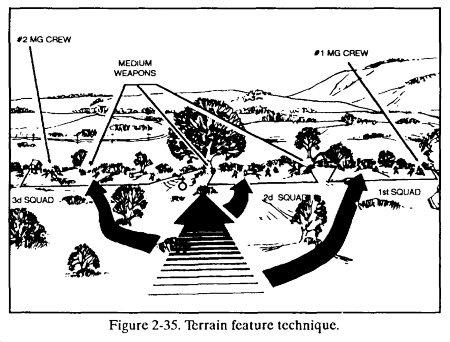
(2) Reorganization. Once platoons have consolidated on the objective, they begin to reorganize. Platoons reorganize to continue the attack. Reorganization involves–
-
Reestablishing command and control.
-
Remanning key weapons, redistributing ammunition and equipment.
-
Clearing the objective of casualties and EPWs
-
Assessing and reporting the platoon status of personnel, ammunition, supplies, and essential equipment.
2-14. ATTACKS DURING LIMITED VISIBILITY
Attacks during limited visibility achieve surprise, avoid heavy losses, cause panic in a weak and disorganized enemy, exploit success and maintain momentum, and keep pressure on the enemy. Limited visibility operations are one of the main missions of infantry forces. Whenever possible, US infantry will use limited visibility to conduct attacks.
a. Planning. The planning considerations for daylight attacks are the same as for limited visibility attacks. However, limited visibility attacks require additional control measures to prevent fratricide and keep the attack focused on the objective. Leaders may use boundaries, restrictive fire lines, and limits of advance to assist in control.
b. Reconnaissance. Reconnaissance is key to successful night attacks. It should be conducted during daylight down to the lowest level possible. The platoon should reconnoiter the routes on which they will move, the positions that they will occupy, and the assigned objective. The need for detailed information about the enemy must be balanced against the risk of being detected and the loss of surprise.
(1) The reconnaissance plan should also establish surveillance on the objective in case the enemy repositions units and weapons or prepares additional obstacles. Surveillance and security forces should also secure critical locations, such as assault and support positions, LD and PLD, routes, and RPs, to protect the platoon from enemy ambushes and spoiling attacks. These security forces may become part of the isolation element during the attack.
(2) When reconnaissance does not succeed due to lack of time, the platoon leader requests a delay in the attack time to allow for further reconnaissance. If this is not possible, an illuminated and supported attack should be considered. A night attack with marginal information of the enemy’s defense is risky and difficult to conduct.
c. Use of Guides. During limited visibility attacks, the platoon may use guides to provide better control while moving into the assault position and onto the probable line of deployment (PLD).
(1) The company may organize a patrol to place platoon guides from the LD to subsequent RPs, at the entrance to the assault positions and at points along the PDL.
(2) Guides must be fully briefed on the plan and on their specific duties. They must rehearse their actions, to include–
-
Reconnaissance of their assigned routes and release points.
-
Pick-up and release of their assigned units. They must be able to identify the leader of the element they will guide (or the lead soldier of that element). They must also know and rehearse recognition signals.
(3) Platoons must rehearse their actions in the same order of march and sequence that they intend to use during the attack in order to make the pick-up and release of guides go smoothly.
d. Fire Control Techniques. Fire control techniques for limited visibility include the following.
(1) Tracer fire. Leaders in the assault element fire all tracers; their soldiers fire where the leader’s tracers impact. The support element positions a machine gun on a tripod on the flank nearest the assault force. This weapon fires a burst of tracers every 15 seconds to indicate the near limit of the supporting fires. All other weapons in the support element keep their fires on the appropriate side of this tracer. The assault force signals to shift fires to the next position or to a set distance. If required, these rounds can be adjusted over the assault element to preclude fratricide.
(2) Luminous tape or chemical lights. Leaders mark assault personnel to prevent fratricide. The enemy must not be able to see the marking. Two techniques are to place tape on the back of the helmet or to use small infrared chemical lights (if the enemy has no NVDs). The support element must know where the lead assault element is. If the individual soldier markings do not suffice, large chemical lights (infrared or visible) are used. These lights are placed on the ground or thrown in front of the assault element. When clearing a trench line, soldiers may put chemical lights on a stick and move them with the lead element to ensure the support element shifts fires.
(3) Weapon control restrictions. To reduce the risk to the assault element, the leader may assign weapon control restrictions.
(a) The squad on the right in the assault might be given weapons free to the right flank because no friendly soldiers are there. However, weapons tight or hold on the left means that another friendly unit is located there.
(b) No automatic weapons will be fired by the assault force on the objective. This ensures that all automatic weapons are enemy.
(4) Other techniques. To increase control during the assault, the leader may use the following.
-
No flares, grenades, or smoke used on the objective.
-
Only certain personnel with NVDs can engage targets on the objective.
-
A magnetic azimuth for maintaining direction.
-
Mortar or artillery rounds to orient attacking units.
-
Guides.
-
A base squad or fire team to pace and guide others.
-
Reduced intervals between soldiers and squads.
-
Luminous tape on armbands or helmets.
e. Mortar, Artillery, and Antiarmor Fires. Mortar, artillery, and antiarmor fires are planned as in a daylight attack. They are not fired, however, unless the platoon is detected or is ready to assault. Some weapons may fire before the attack and maintain a pattern to deceive the enemy or to help cover noise made by the platoon’s movement. This is not done if it will disclose the attack.
(1) Indirect fire is hard to adjust when visibility is poor. If doubt exists as to the exact friendly locations, indirect fire is directed first at enemy positions beyond the objective and then moved onto the objective. Illuminating rounds that are fired to burn on the ground can be used to mark objectives. This helps the platoon orient on the objective but also may adversely affect NVDs.
(2) Smoke is planned to further reduce the enemy’s visibility, particularly if he has NVDs. The smoke is laid close to or on enemy positions so it does not restrict friendly movement or hinder the breaching of obstacles. Employing smoke on the objective during the assault may make it hard for assaulting soldiers to find enemy fighting positions. If enough thermal sights are available, smoke on the objective may provide a decisive advantage for a well-trained platoon.
(3) Illumination is always planned for limited visibility attacks, giving the leader the option of calling for it. Battalion commanders normally control the use of illumination but may authorize the company commander to do so. If the commander decides to use illumination, illumination should not be called for until the assault is initiated or the attack is detected. It should be placed on several locations over a wide area to confuse the enemy as to the exact place of the attack. Also, it should be placed beyond the objective to help assaulting soldiers see and fire at withdrawing or counterattacking enemy soldiers.
(4) Illumination may also be required if the enemy uses illumination to disrupt the effect of the NVDs. Once used, illumination must be continuous because attacking soldiers will have temporarily lost their normal night vision. Any interruption in illumination may also reduce the effect of suppressive fire when the attackers need it most. Squad leaders must not use hand flares before the commander has decided to illuminate the objective.
(5) Thermal sights (AN/TAS-5) may be employed strictly for observation if there are no targets for the Dragons to engage. Positioned outside the objective area, these sights can provide current information. They may be used to assist the support element in controlling their fires or to provide the assault element with reports of enemy movements on the objective.
(6) When only a few NVDs are available, they must be employed at the most critical locations. These locations can be with the key soldiers in the breach element, key leaders in the assault element, other members of the assault element and key leaders and weapons in the support element.
f. Consolidation and Reorganization. After seizing the objective, the platoon consolidates and reorganizes. Consolidation and reorganization are the same as for a daylight attack with the following exceptions:
(1) The consolidation plan should be as simple as possible. In reorganizing, the platoon should avoid changes to task organization.
(2) Squad positions should be closer to case control and to improve mutual support. Position distances should be adjusted as visibility improves.
(3) Locating and evacuating casualties and EPWs takes longer. EPWs may have to be moved to the rear of the objective and held there until visibility improves.
g. Communication. Communication at night calls for the leader to use different methods than during daylight. For instance, arm-and-hand signals used during the day might not be visible at night. Other types of signals are used to pass information, identify locations, control formations, or begin activity. The key to tactical communications is simplicity, understanding, and practice. Signals should be an integral part of the platoon SOP. They should be as simple as possible to avoid confusion. Leaders should also ensure that every soldier understands and practices each basic signal and its alternate if the need arises. A technique to assist leaders and the RATELO with communication at night is to attach a large patch of luminous tape to the handset, or carry it in their pockets. Leaders and the RATELO can write target numbers, call signs, frequencies, code words, checkpoints, and so forth on it with a black grease pencil. This is easy to read at night and quickly removed if needed.
(1) The most common signals relate to the senses–sound, feel, and sight. Audio signals include radio, telephones, messengers, and grating or clicking of objects together. Messengers should carry written messages to avoid confusion and misunderstanding. When this is not possible, leaders ensure that the messenger understands the message–have him repeat it word for word.
(2) Control at night involves some oral communication but spoken in a whisper. The radio and telephone might not be suitable at night. If either is used, the leader must be careful. Noise travels farther at night; including radio sounds, messages being passed, and the telephone ringing. These violate noise discipline and can be avoided or reduced by planned signals or clicks. Headphones reduce the amount of noise from telephones and radios. If headphones are not available, soldiers use the radio selector switch in the ON rather than SQUELCH ON position and adjust the volume so that only a faint rushing sound can be heard.
(3) Rocks and other objects can be used to send audible signals. They can be tapped or scraped together or against a tree or rifle stock to pass a message. These signals must be rehearsed. For each signal there must be a reply to show receipt of the signal. Other audible signals are whistles, bells, sirens, clackers or “crickets,” and horns. The device or method chosen depends on simplicity and security.
(4) Leaders can use a variety of visual signals as alternatives to audio signals. The signals can be active or passive. Visual signals must be noticeable and identifiable These signals can be used to identify a critical trail junction, to begin an attack, to mark caches, or to report that a danger area is clear. For example, white powder can be used to show direction at a confusing trail intersection. Star clusters can signal to lift or shift support fires for an attack or raid. Chemical lights can signal a unit cache. The exposed dial of a compass can signal all clear when crossing a danger area. The possibilities are endless, but the leader must ensure that each soldier understands every signal. Some signals are–
-
VS-17 panels.
-
Sticks showing direction.
-
Light-colored paint.
-
Tape.
-
Rock formations.
-
Markings in the ground.
-
Foot or talcum powder.
-
Luminous tape.
-
Flares.
-
Flashlights.
-
Illumination rounds (grenade launcher, mortar, artillery).
-
Chemical lights.
-
Infrared strobe lights.
-
AN/PVS-5 night vision device.
-
Burning fuel (saturated sand in a can).
-
Luminous compass dial.
(5) Wire is a means of maintaining communications during the attack. The wire net should link the squad leaders, platoon leaders, and the company commander. At times, a security patrol can lay the wire before the attack. If not, the wire can be laid as the units move. The laying of wire before an attack could lead to discovery of the attack if the wire is not properly hidden, or if it is laid too far in advance. The wire net can be used to communicate while moving.
(a) Platoon net. Wire is laid from the platoon RP to the squad RP and to each squad leader’s position on the PLD.
(b) Assault wire. Assault wire can be used as a guide from the company RP to the platoon and squad RPs.
(c) Radios. Squad radios can be used for backup communications.
h. Target Detection. The ability to detect targets at night depends on patience, alertness, attention to detail, and practice. Nature provides an endless array of patterns. However, man disturbs them or alters them so that they are detectable. Sensing the enemy at night requires leaders and soldiers to be patient, confident, and calm.
(1) Stealthy night movement and successful target engagement depend on knowing how the enemy attacks, defends, and uses terrain. Studying his techniques and established patterns helps in detecting targets.
(2) Patience and confidence are musts for effective target sensing at night. While moving through an area, soldiers must think “patterns.” They must look calmly and methodically through the area, not focusing on the surface alone but on patterns–noticing straight lines, strange patterns, and light variations.
(3) Soldiers must look for sentries or positions at the entrances to draws, overlooking bridges and obstacles and on the military crests of prominent terrain (the spots used for best observation). They look for supporting positions, keeping in mind range distances for supporting weapons, NVDs, and LOS needs. Then soldiers search for enemy positions and other signs of enemy activity.
Section V. DEFENSE
Paragraph 3b of the platoon SOP ( Chapter 5 ) provides a suggested sequence of tasks for establishing a defensive position. This section follows that sequence in describing techniques used in the planning and preparation phases of defensive operations.
2-15. CONDUCT OF THE DEFENSE
This paragraph provides a pattern of preparation, decision, and execution for platoons and squads. This pattern links the leader’s critical decision points to a standard sequence of actions that a platoon takes in defensive operations. (Figure 2-36.) The standard sequence of actions are–
-
Prepare for Combat.
-
Move to Defensive Positions.
-
Establish Defensive Positions.
-
Locate the Enemy.
-
Initiate Contact/Actions on Enemy Contact.
-
Fight the Defense.
-
Reorganize.
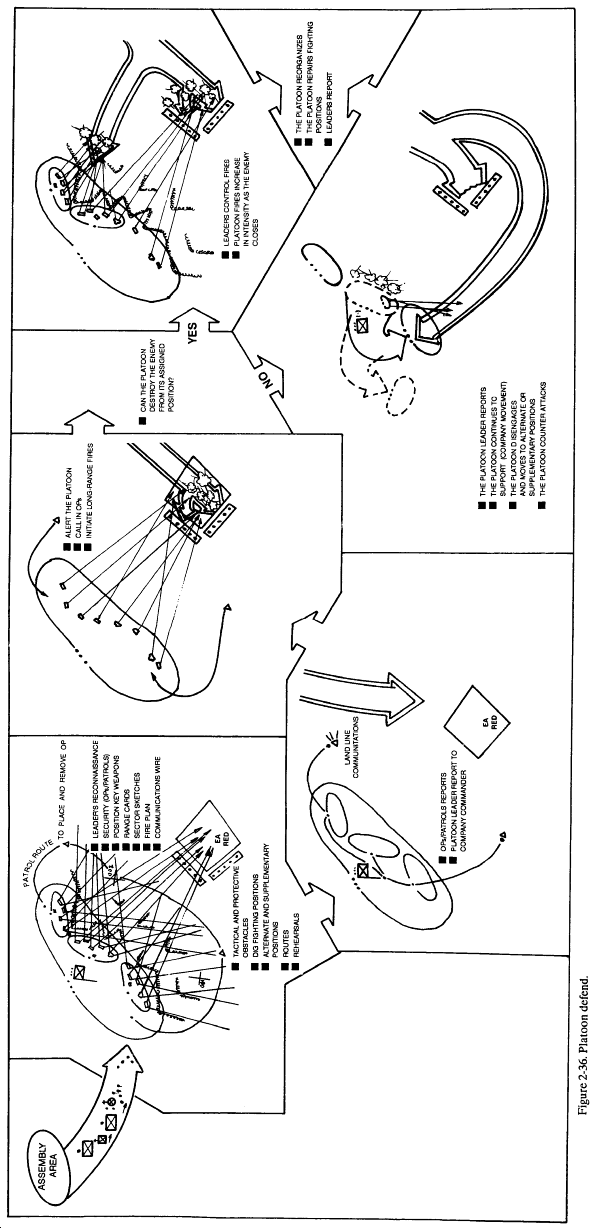
a. Prepare for Combat. The platoon leader receives the company warning or operation order.
(1) The platoon leader quickly issues a warning order.
(2) The platoon leader begins making a tentative plan based on his estimate of the situation and an analysis of METT-T.
(3) When possible the platoon leader (and squad leaders) reconnoiters the defensive position and the route(s) to it. The leader’s reconnaissance party should always include a security team (minimum of two soldiers). The leader’s reconnaissance–
(a) Maintains security.
(b) Checks for enemy positions, or signs of past enemy activities, obstacles, booby traps, and NBC contamination.
(c) Confirms/adjusts squad positions and sectors of fire from those in the tentative plan. (Normally the platoon leader assigns and adjusts machine guns and antiarmor positions.) The platoon leader revises his plan as necessary based on a further assessment of METT-T.
(d) As the reconnaissance party returns to the platoon, the platoon leader posts guides along the route to maintain security and help the platoon move into the position.
(4) Based on his reconnaissance, and any additional information, the platoon leader completes and issues his plan.
(5) All squad leaders check (the platoon sergeant spot checks) weapons, communications equipment and accessories for missing items (squad and individual) and serviceability.
(6) The platoon sergeant makes sure that the platoon has ammunition, food, water, and medical supplies on hand, in quantities prescribed by the platoon leader. (Squads and platoons should plan to prestock an additional basic load of ammunition on the defensive position.)
(7) All soldiers camouflage themselves and their equipment to blend with the terrain.
(8) The platoon rehearses critical tasks first.
(a) The platoon leader makes final inspection of weapons (test fires weapons, if possible), equipment (include communications checks), and personnel (include camouflage). The platoon sergeant closely monitors the soldiers’ load to ensure that standard items are packed in accordance with the platoon SOP and that it is not excessive.
(b) If an advance party is used, the platoon leader, platoon sergeant, and advance party leader (normally a squad leader) review advance party activities and redistribute equipment to the advance party (for example, tripods, stakes). (See Chapter 5 .)
(9) If not already moving, the platoon leader initiates the movement of his platoon.
b. Move to Defensive Positions. The platoon applies fundamentals of movement:
(1) Move on covered and concealed routes.
(2) Avoid likely ambush sites.
(3) Enforce camouflage, noise, and light discipline.
(4) Maintain all-round security, to include air guards.
(5) Use formations and movement techniques based on METT-T.
c. Establish Defensive Positions. The platoon halts short of the defensive position in a covered and concealed position, and establishes local security.
(1) The platoon leader and squad leaders and a security team (minimum of two soldiers) move forward to link up with the security team on the position.
(a) The squad leaders return to the platoon and move their squads forward.
(b) The platoon occupies the designated position. Guides control the movement of the platoon into position.
(2) As the platoon occupies its position, the platoon leader ensures that all tasks are performed in the stated priority of work. Additionally, the platoon leader–
-
Walks forward of positions, if possible to check camouflage and confirm dead space. The most important aspect of infantry fighting positions is that they cannot be observed by the enemy until it is too late.
-
Checks on wire and mine teams. The platoon leader ensures that protective wire is outside of hand-grenade range from the fighting positions and tactical wire lies along the friendly side of the final protective line (FPL).
-
Briefs the platoon sergeant on the logistics plan (include resupply and casualty evacuation routes).
-
Issues finalized platoon order and checks soldier knowledge and understanding. (All soldiers must be aware of friendly units forward of the position [for example, patrols, scouts] and their return routes. They must also know the signals or conditions to initiate, shift, fire final protective, and cease fires, and to reposition to alternate and supplementary positions.)
(3) The platoon improves the position continuously.
d. Locate the Enemy. The platoon establishes and maintains OPs and conducts security patrols as directed by the company commander. Patrols, OPs, and individual soldiers look and listen. They use night surveillance devices, binoculars, and PEWS to detect the enemy approach.
e. Action on Enemy Contact. Once the enemy is detected, the platoon leader–
-
Alerts the squad leaders, platoon sergeant, and his forward observer.
-
Reports the situation to the company commander.
-
Calls in OPs. (The squad leader or platoon leader may decide to leave the OPs in place if the soldiers manning them can provide effective flanking fires, their positions afford them adequate protection, and or their return will compromise the platoon’s position.)
-
Calls for and adjusts indirect fire when the enemy is at maximum range.
-
Initiates the long-range direct fires of his platoon on command from the company commander.
Leaders and individual soldiers return to their positions and prepare to fire on command from the platoon leader.
f. Fight the Defense. The platoon leader determines if the platoon can destroy the enemy from its assigned positions.
(1) If the answer is YES, the platoon continues to tight the defense.
(a) The platoon leader, or FO, continues to call for indirect fires as the enemy approaches. The platoon normally begins engaging the enemy at maximum effective range. It attempts to mass fires and initiate them simultaneously to achieve surprise. Long-range fires tied-in with obstacles should disrupt his formations; channelize him toward engagement areas; prevent, or severely limit his ability to observe the location of friendly positions; and destroy him as he attempts to breach tactical obstacles.
(b) Leaders control fires using standard commands, pyrotechnics, and other prearranged signals. The platoon increases the intensity of fires as the enemy closes within range of additional weapons. Squad leaders work to achieve a sustained rate of fire from their positions by having buddy teams fire their weapons so that both are not reloading them at the same time.
(c) In controlling and distributing fires, the platoon and squad leaders consider–
-
The range to the enemy.
-
Priority targets (what to fire at, when to fire, and why).
-
Nearest or most dangerous targets.
-
Shifting to concentrate fires on their own or as directed by higher headquarters.
-
Ability of the platoon to engage dismounted enemy with enfilading, grazing fires.
-
Ability of the platoon’s antiarmor weapon to achieve flank shots against enemy vehicles.
(d) As the enemy closes on the platoon’s protective wire, the platoon leader initiates final protective fires (FPF) (the following actions occur simultaneously):
-
Machine guns and automatic weapons fire along interlocking principle direction of fire (PDF), or final protective lines (FPL) as previously designated and planned. Other weapons fire at designated principle direction of fires. M203 grenade launchers engage enemy in dead space or against enemy attempts to breach protective wire.
-
The platoon continues to fight with Claymores and hand grenades.
-
If applicable, the platoon leader requests indirect final protective fires (FPF) if they have been assigned in support of his positions.
(e) The platoon continues to defend until the enemy is repelled, or the platoon is ordered to disengage.
(2) If the answer is NO, the platoon leader–
(a) Reports the situation to the company commander.
(b) Continues to engage the enemy or repositions the platoon (or squads of the platoon) only when directed by the company commander to–
-
Continue fires into the platoon sector (engagement area).
-
Occupy supplementary positions.
-
Reinforce other parts of the company.
-
Counterattack locally to retake lost fighting positions.
-
Withdraw from an untenable position using fire and movement to break contact. (The platoon leader does not move his platoon out of position if it will destroy the integrity of the company defense. All movements and actions to reposition squads and platoons must be thoroughly rehearsed.)
NOTE: In any movement out of a defensive position, the platoon MUST employ all direct and indirect fire means available to suppress the enemy long enough for the unit to move.
g. Consolidate and Reorganize.
(1) The platoon–
-
Reestablishes security.
-
Remans key weapons.
-
Provides first aid and prepares wounded soldiers for MEDEVAC.
-
Repairs damaged obstacles and replaces mines (Claymore) and booby traps.
-
Redistributes ammunition and supplies.
-
Relocates selected weapons to alternate positions if leaders believe that the enemy may have pinpointed them during the attack. Adjusts other positions to maintain mutual support.
-
Reestablishes communications.
-
Reoccupies and repairs positions, and prepares for renewed enemy attack.
(2) Squad and team leaders provide ammunition, casualty, and equipment (ACE) reports to the platoon leader.
(3) The platoon leader–
-
Reestablishes the platoon chain of command.
-
Consolidates squad ACE an d provides ACE report to the company commander.
(4) The platoon sergeant coordinates for resupply and supervises the execution of the casualty and EPW evacuation plan.
(5) The platoon continues to improve positions. The platoon quickly reestablishes OPs and resumes patrolling as directed.
2-16. SECURITY
In the defense, infantry platoons attempt to surprise the enemy and initiate contact in such a way that his plan is disrupted. To capitalize on the element of surprise, infantry in defensive positions must remain undetected. A compromised position will either be bypassed or assaulted with overwhelming odds. Infantry platoons must conceal the location and preparation of their positions. They do this through the use of camouflage techniques and a strict adherence to noise and light discipline. Platoons must also provide their own security from the arrival of the leader’s reconnaissance party through the execution of the defense. Platoons provide their own security through patrolling; the use of observation posts; and by detailing a percentage of the platoon to man hasty positions, while the remainder of the platoon prepares the defense. ( Chapter 3 provides detailed information on patrolling techniques. Section XII discusses techniques for establishing observation posts. Securing the position during preparation can be an SOP item.)
2-17. COMMAND POST AND COMMUNICATIONS
A platoon leader sets up his CP where he can best see and control his platoon. The FO and the platoon RATELO occupy the platoon CP with the platoon leader. If the leader cannot see and control all of the platoon from one place, he sets up the CP where he can see and control the main effort. He then sets up an alternate CP where the platoon sergeant can control the rest of the platoon. The aidman normally locates with the PSG. The alternate CP bunker, with overhead cover, may be large enough to hold additional ammunition and casualties. The EPW collection point is normally near the alternate CP Excess supplies, barrier material, equipment; and KIAs are camouflaged near the alternate CP The platoon CP ties into the company wire net with a field telephone (if in the TOE) and into the company radio net with a radio. The alternate CP ties into the platoon CP with wire. The platoon has its own platoon radio and wire nets. (Figure 2-37.)
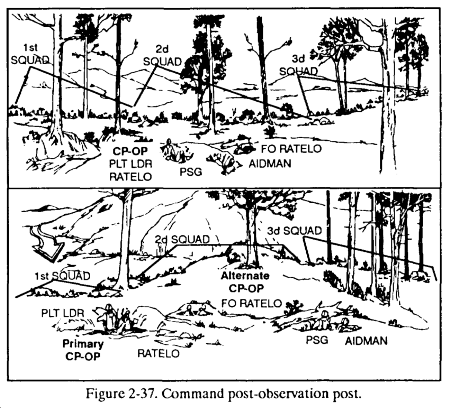
2-18. WEAPONS EMPLACEMENT
The success of the defense depends on the positioning of soldiers and weapons. To position their weapons effectively, all leaders must know the characteristics, capabilities, and limitations of their weapons, the effects of terrain, and the tactics used by the enemy. Leaders should position weapons where they have protection; avoid detection; and surprise the enemy with accurate, lethal fires. In order to position the weapon, the leader must know where he wants to destroy the enemy and what effect he wants the weapon to achieve. Additionally, the platoon leader must consider whether his primary threat will be armored vehicles or dismounted infantry. When the platoon must fight armored vehicles, the platoon leader positions antiarmor weapons along the most likely armored avenue of approach first. When the primary threat is from dismounted infantry, the the platoon leader should position his machine guns on the most likely dismounted avenue of approach first. The platoon leader must consider both mounted and dismounted avenues of approach. His plan should address both; one as a contingency of the other. Squad leaders position all other weapons to support these key weapons, cover dead space, and provide security.
a. Machine Guns. M60 (7.62-mm) and M249 (5.56-mm) machine guns are the platoon’s primary weapons against a dismounted enemy. They provide a high volume of lethal, accurate fires to break up enemy assaults. They also provide limited effects against lightly armored vehicles and cause vehicle crews to button-up and operate with reduced effectiveness. Leaders position machine guns to–
-
Concentrate fires where they want to kill the enemy.
-
Fire across the platoon front.
-
Cover obstacles by fire.
-
Tie-in with adjacent units.
(1) The following definitions apply to the employment of machine guns.
(a) Grazing fire. Grazing fire occurs when the center of the cone of fire dots not rise more than 1 meter (about waist high) above the ground. When firing over level or uniformly sloping terrain, a maximum of 600 meters of grazing fire can be obtained.
(b) Dead space. Dead space is an area within the maximum effective range of a weapon, surveillance device, or observer that cannot be covered by fire and observation from a given position because of intervening obstacles, the nature of the ground, the characteristics of the trajectory, or the limitations of the pointing capabilities of the systems. The platoon covers dead space with another direct fire weapon, M203 fire, indirect fires, or mines (command-detonated Claymores). Additionally, the platoon leader should attempt to tic-in obstacles (wire and mines) and fires to cover dead space. He may also position OPs to observe dead space for another position.
(c) Final protective line. A final protective line (FPL) is a predetermined line along which grazing fire is placed to stop an enemy assault. Where terrain allows, the platoon leader assigns a machine gun an FPL. Once in position, one soldier from the machine gun team walks the FPL to identify both dead space and grazing fire along its length. (Figure 2-38.)
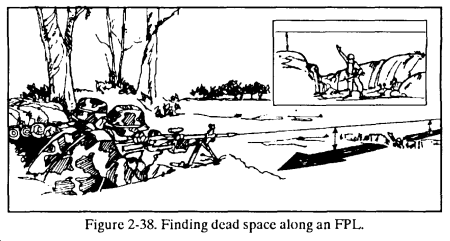
(d) Principle direction of fire. A principle direction of fire (PDF) is a priority direction of fire assigned to cover an area which provides good fields of fire or has a likely avenue of approach. It is also used to provide mutual support to an adjacent unit. Guns are laid on the PDF if an FPL cannot be assigned due to terrain. If a PDF is assigned and other targets are not being engaged, guns are laid on the PDF.
(2) Each gun is given a primary and secondary sector of fire. Their sectors of fire should overlap each other and those of adjacent platoons. A gunner fires in his secondary sector only if there are no targets in his primary sector, or when ordered to do so. Each gun’s primary sector includes an FPL or a PDF The gun is laid on the FPL or PDF unless engaging other targets. When FPFs are called for, the gunner shifts to and engages on the FPL or PDF
b. Antiarmor Weapons. The MAW is normally the antiarmor weapon that supports a rifle squad or platoon. In some units these weapons are organic to the platoon. At times, the platoon may be supported by TOWs. During planning, the leader considers the enemy vehicle threat, then positions antiarmor weapons accordingly to cover armor avenues of approach (Figure 2-39). He also considers the fields of fire, the tracking time, and the minimum arming ranges of each weapon. The platoon leader selects a primary position and a sector of fire for each antiarmor weapon. He also picks supplementary positions for them. The antiarmor leader selects alternate positions. Each position should allow flank fire and have cover and concealment. The leader can integrate the MAW thermal sight into his limited visibility security and observation plan.
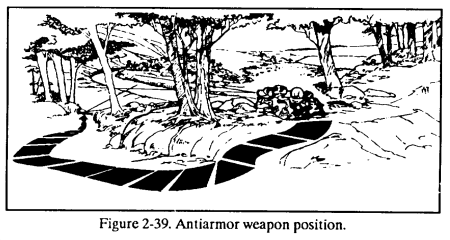
c. Grenade Launchers. The M203 is the squad leader’s indirect fire weapon. He positions it to cover dead space in the squad’s sector, especially the dead space for the machine guns. The M203 gunner is also assigned a sector to cover with rifle fire. The high-explosive, dual-purpose (HEDP) round is very effective against lightly armored vehicles such as the BMP-1 and the BTR.
d. Rifles. The leader assigns positions and sectors of fire to each rifleman in the squad. Normally, he positions the riflemen to support the machine guns and antiarmor weapons. They are also positioned to cover obstacles, provide security, cover gaps between units, or provide observation.
2-19. RANGE CARDS
A range card is a record of the tiring data required to engage predetermined targets within a sector of fire during good and limited visibility. Every direct-fire weapon gunner must prepare a range card ( DA Form 5517-R , Standard Range Card). Two copies of the range card are prepared. One copy stays at the position and the other is sent to platoon headquarters. Range cards are prepared for primary, alternate, and supplementary positions. Range cards are prepared immediately up arrival in a position, regardless of the length of stay, and updated as necessary. The range card is prepared in accordance with the FM for the specific weapon. The range card has two sections–a sector sketch section and a data section. A blank form for local reporduction on 8 1/2-by 11-inch paper is at the back of this manual General preparation instructions are as follows See Figure 2-40 for examples of completed DA Form 5517-R for a machine gun and Dragon.
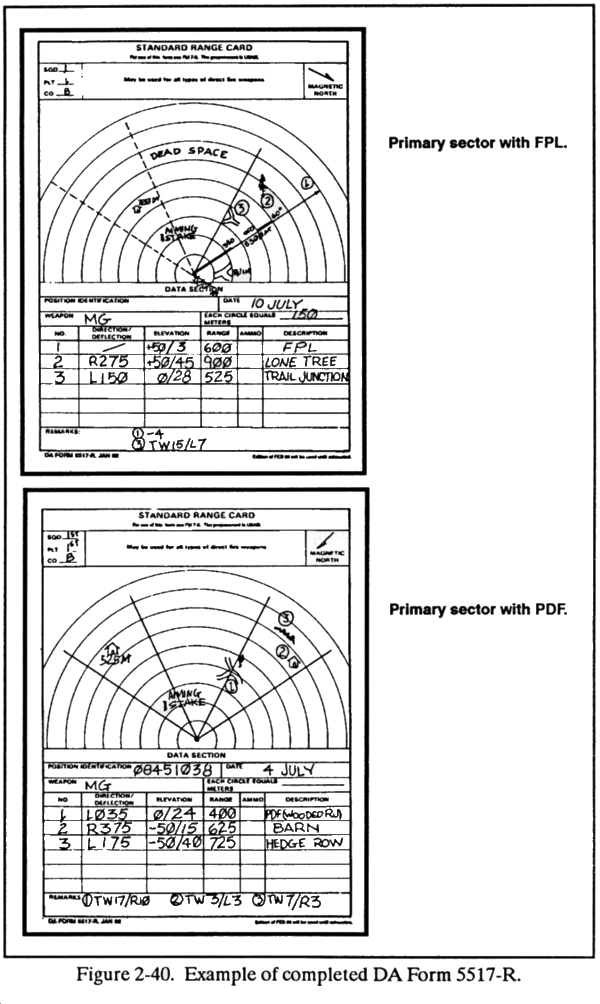
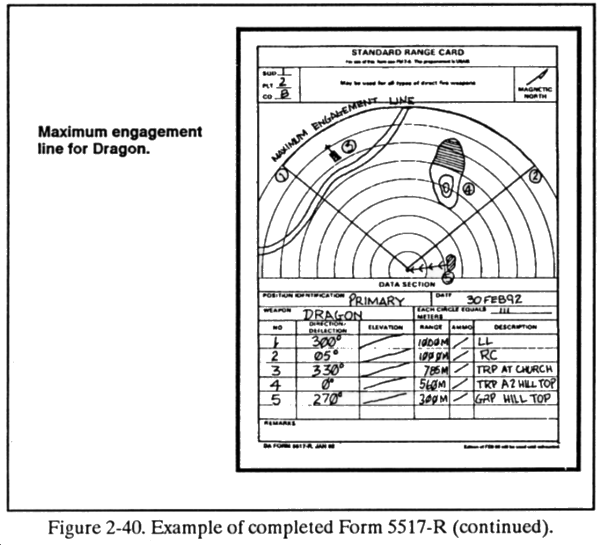
a. The marginal information at the top of the card is listed as follows.
(1) SQD, PLT CO. The squad, platoon, and company designations are listed. Units higher than company are not listed.
(2) MAGNETIC NORTH. The range card is oriented with the terrain and the direction of magnetic north arrow is drawn.
b. The gunner’s sector of fire is drawn in the sector sketch section. It is not drawn to scale, but the data referring to the targets must be accurate.
(1) The weapon symbol is drawn in the center of the small circle.
(2) Left and right limits are drawn from the position. A circled “L” and “R” are placed at the end of the appropriate limit lines.
(3) The value of each circle is determined by using a terrain feature farthest from the position that is within the weapon’s capability. The distance to the terrain is determined and rounded off to the next even hundredth, if necessary. The maximum number of circles that will divide evenly into the distance is determined and divided. The result is the value for each circle. The terrain feature is then drawn on the appropriate circle.
(4) All TRPs and reference points are drawn in the sector. They are numbered consecutively and circled.
(5) Dead space is drawn in the sector.
(6) A maximum engagement line is drawn on range cards for antiarmor weapons.
(7) The weapon reference point is numbered last. The location is given a six-digit grid coordinate. When there is no terrain feature to be designated, the location is shown as an eight-digit grid coordinate.
c. The data section is filled in as follows.
(1) POSITION IDENTIFICATION. The position is identified as primary alternate, or supplementary.
(2) DATE. The date and time the range card was completed is entered.
(3) WEAPON. The weapon block indicates the weapons used.
(4) EACH CIRCLE EQUALS ______ METERS. Write in the distance in meters between circles.
(5) NO. Starting with left and right limits TRPs and reference points are listed in numerical order.
(6) DIRECTION/DEFLECTION. The direction is listed in degrees. The deflection is listed in mils.
(7) ELEVATION. The elevation is listed in mils.
(8) RANGE. The distance in meters from the position [to the left and right limits and TRPs and reference points.
(9) AMMO. The type of ammunition used is listed.
(10) DESCRIPTION. The name of the object is listed for example, farmhouse, wood line, hilltop.
(11) REMARKS. The weapon reference point data and any additional information is listed.
2-20. TYPES OF POSITIONS
Defensive positions may be classified as primary, alternate, or supplementary. All positions should provide observation and fields of fire within the weapon’s or platoon’s assigned sector. They should take advantage of natural cover and concealment even before soldiers begin to camouflage them. Soldiers improve their ability to reposition by using covered routes, communications trenches; by employing smoke; or by planning and rehearsing the repositioning by fire and maneuver. (Figure 2-41.)
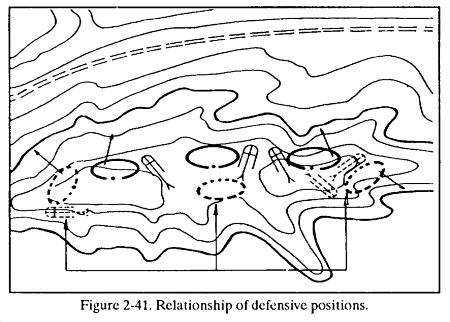
a. Primary. A primary position provides soldier, weapon crew, or unit the best mean to accomplish the assigned mission.
b. Alternate. Alternate positions allow soldiers, weapon crews, or units to cover the same sector of fire covered from the primary position. Soldiers occupy alternate positions when the primary position becomes untenable or unsuitable for carrying out their tasks. Soldiers may occupy alternate positions before an attack to rest and or perform maintenance, or to add the element of surprise to their defense
c. Supplementary. Supplementary positions provide the best means to accomplish a task that cannot be accomplished from the primary or alternate positions. Platoon leaders normally locate supplementary positions to cover additional enemy avenues of approach and to protect the flanks and rear of the platoon position.
2-21. SQUAD POSITIONS
As a guideline, a squad can physically occupy a front of about 100 meters. From this position, it can defend 200 to 250 meters of frontage. The frontage distance between two-man fighting positions should be about 20 meters (allowing for a “lazy W” configuration on the ground; this would put fighting positions about 25 meters apart physically). Every position should be observed and supported by the fires of at least two other positions. One-man fighting positions may be located closer together to occupy the same platoon frontage. The distance between fighting positions depends on the leader’s analysis of the factors of METT-T. In determining the best distance between fighting positions, the squad leader must consider–
-
The requirement to cover the squad’s assigned sector by fire.
-
The need for security; that is, prevent infiltrations of the squad position.
-
The requirement to prevent the enemy from using hand grenades effectively to assault adjacent positions, should he gain a fighting position.
2-22. PLATOON POSITIONS
The platoon leader assigns primary positions and sectors of fire to his machine guns and antiarmor weapons. He must personally check the lay of each weapon. He assigns primary positions and sectors of fire to his squads. The squad leader normally assigns the alternate positions for the squad and has them approved by the platoon leader. Each squad’s sector must cover its own sector of fire and overlap into that of the adjacent squad. Flank squad sectors should overlap those of adjacent platoons. The platoon leader also assigns supplementary positions if required. The platoon leader may choose to position his squads in depth to gain or enhance mutual support.
2-23. SECTOR SKETCHES
Leaders prepare sector sketches based on their defensive plan. They use the range card for each crew-served weapon (prepared by the gunners).
a. Squad Sector Sketch. Each squad leader prepares a sector sketch to help him plan his defense and to help him control fire (Figure 2-42). The squad leader prepares two copies of the sector sketch. He gives one copy to the platoon leader and keeps the second copy at his position. The SOP should state how soon after occupying the position the leader must forward the sketch. The sketch shows the following:
-
Squad and platoon identification.
-
Date/time group.
-
Magnetic north.
-
The main terrain features in his sector of fire and the ranges to them.
-
Each primary fighting position.
-
Alternate and supplementary positions.
-
The primary and secondary sectors of fire of each position.
-
Maximum engagement line.
-
Machine gun FPLs or PDF.
-
Dragon positions with sectors of fire.
-
The type of weapon in each position.
-
Observation posts and the squad leader’s position.
-
Dead space to include coverage by grenade launchers.
-
Location of NVDs.
-
Obstacles, mines, and booby traps.

b. Platoon Sector Sketch. The platoon leader check range cards and squad sector sketches If he finds gaps or other flaws in his fire plan, he adjusts the weapons or sectors as needed. If he finds any dead space, he takes steps 10 cover it with mines, grenade launcher fire, or indirect fire. He then makes two copies of his platoon sector sketch tone for his use; the other for the company commander) (Figure 2-43). His sketch shows the following:
-
Squad sectors of fire.
-
Machine gun and antiarmor weapon positions and their sectors of fires, to include FPLs and PDFs of the automatic rifles/machine guns and TRPs for the antiarmor weapons.
-
Maximum engagement lines for antiarmor weapons.
-
Mines (Claymores) and obstacles.
-
Indirect fire planned in the platoon’s sector of fire (targets and FPF).
-
OPs and patrol routes, if any.
-
Platoon CP
-
Platoon/company identification.
-
Date/time group.
-
Magnetic north.
-
Location of casualty collection point.
-
Location of NVDs/thermal sights that are part of the limited visibility security plan.
-
Adjustments during limited visibility to maintain coverage of assigned TRPs.

2-24. FIRE CONTROL MEASURES
Normally, antiarmor fires (except LAWs) are part of the battalion or company fire plan. One leader controls all antiarmor weapons firing from a single position or into a single engagement area. Platoon leaders normally control the fires of machine guns. Squad leaders and team leaders control, automatic rifles, grenade launchers, and rifle fire. Platoon and squad leaders use the following fire control measures to ensure the proper concentration and distribution of fires.
a. Sectors. Leaders use sectors of fire to assign responsibility and ensure distribution of fires across the platoon and squad front. Sectors should always overlap with adjacent sectors.
b. Engagement Areas. Leaders use engagement areas to concentrate all available fires into an area where they intend to kill the enemy. When conducting ambushes, units refer to the engagement areas as a KILL ZONE.
c. Fire Patterns. These include front, cross, and depth fires. These patterns describe the relationship between the weapons and the targets. The intent is to ensure that weapons do not waste ammunition firing on the same target, while other targets remain unengaged.
d. Engagement Priorities. These designate the priority for engaging key targets to include leaders, RATELOs crew-served weapons, and engineers. The following is an example of a engagement priority.
(1) MAW gunners fire–
-
At the most threatening armored vehicle.
-
At armor in the kill zone or primary sector.
-
At armor in the secondary sector.
-
At armored vehicles beyond 200 meters.
(2) Machine gun gunners fire–
-
The FPL or PDF, if signaled to do so.
-
At groups of five or more in the primary sector (from farthest to closest).
-
At crew-served automatic weapons.
-
At groups of five or more in the secondary sector.
-
At unarmored vehicles.
(3) Automatic riflemen fire–
-
Along the FPL, if signaled to do so.
-
At groups of five or more in the primary sector (closest to farthest).
-
At soldiers in the primary sector.
(4) Grenadiers fire–
-
At light armored vehicles in sector.
-
At groups of three or more in sector.
-
At groups of three or more in secondary sector.
-
At individual soldiers in sector, using M16 rifles.
-
At dead space in sector (if occupied by the enemy).
-
At other targets as directed by squad or team leader (illumination or smoke on order).
(5) Riflemen fire–
-
In their primary and secondary sectors.
-
Nearest to farthest, starting on flank and working toward the center –
-
At leaders.
-
At RATELOs.
-
At individual soldiers.
(6) LAW gunners fire–
-
In two-soldier volleys on direction of the team or squad leaders.
-
At nearby threatening vehicle.
e. Rate of Fire. Some weapon system FMs specify rates of fire by name–others do not. The doctrinal terms should be used when possible; others are addressed by SOP.
2-25. PRIORITY OF WORK
The platoon’s priority of work is a list of tasks that the leader uses to control what gets done by whom and in what order in the preparation of the defense. These tasks are normally prescribed in the SOP. An example of priority of work tasks by duty position is in Chapter 5. The leader adjusts the priority of work based on his consideration of the factors of METT-T and on his and the higher commander’s intent. The platoon’s normal priority of work is–
-
Establish local security
-
Position antiarmor weapons, machine guns, and squads and assign sectors of fire.
-
Position other assets attached to the platoon.
-
Establish the CP and wire communications.
-
Designate FPLs and FPFs.
-
Clear fields of fire and prepare range cards and sector sketches.
-
Coordinate with adjacent units–left, right, forward, and to the rear.
-
Prepare primary fighting positions.
-
Emplace obstacles and mines.
-
Mark or improve marking for TRPs and other fire control measures.
-
Improve primary fighting positions such as overhead cover.
-
Prepare alternate positions, then supplementary positions.
-
Establish a sleep and rest plan.
-
Reconnoiter routes.
-
Rehearse engagements, disengagements, and any counterattack plans.
-
Adjust positions or control measures as required.
-
Stockpile ammunition, food, and water.
-
Dig trenches to connect positions.
-
Continue to improve positions.
2-26. COORDINATION
Coordination between adjacent platoons/squads is normally from left to right and from front to rear. Information exchanged includes the following:
-
Location(s) of leaders.
-
Location of primary, alternate, and supplementary positions and sectors of fire of machine guns, antiarmor weapons, and subunits.
-
Route to alternate and supplementary positions.
-
Location of dead space between platoons and squads and how to cover it.
-
Location of OPs and withdrawal routes back to the platoon’s or squad’s position.
-
Location and types of obstacles and how to cover them.
-
Patrols to be conducted to include their size, type, limes of departure and return, and routes.
-
Location, activities, and presage plan for scouts and other units forward of the platoon’s position.
-
Signals for fire and cease fire and any other signals that may be observed.
-
Engagement and disengagement criteria.
2-27. FIGHTING POSITIONS
This paragraph discusses techniques for the construction of infantry fighting positions. Infantrymen use hasty; one-, two-, and three-soldier; machine gun; medium and light antitank; and 90-mm recoilless rifle positions. Soldiers must construct fighting positions that protect them and allow them to fire into their assigned sectors.
a. Protection. Fighting positions protect soldiers by providing cover through sturdy construction, and by providing concealment through positioning and proper camouflage. The enemy must not be able to identify the position until it is too late and he has been effectively engaged. When possible, soldiers should site positions in nonobvious places, behind natural cover, and in an easy to camouflage location. The most important step in preparing fighting position is to make sure that it cannot be seen. In constructing fighting positions, soldiers should always–
-
Dig the positions armpit deep.
-
Fill sandbags about 75 percent full.
-
Revet excavations in sandy soil.
-
Check stabilization of wall bases.
-
Inspect and test the position daily, after heavy rain, and after receiving direct or indirect fires.
-
Maintain, repair, and improve positions as required.
-
Use proper materiel. Use it correctly.
NOTE: In sandy soil, vehicles should not be driven within 6 feet of the positions.
b. Siting to Engage the Enemy. Soldiers must be able to engage the enemy within their assigned sectors of fire. They should be able to fire out to the maximum effective range of their weapons with maximum grazing fire and minimal dead space. Soldiers and leaders must be able to identify the best location for their positions that meet this criteria. Leaders must also ensure that fighting positions provide interlocking fires. This allows them to cover the platoon’s sector from multiple positions and provides a basis for final protective fires.
c. Prepare by Stages. Leaders must ensure that their soldiers understand when and how to prepare fighting positions based on the situation. Soldiers normally prepare hasty fighting positions everytime the platoon halts (except for short security halts), and only half of the platoon digs in while the other half maintains security. Soldiers prepare positions in stages and require a leader to inspect the position before moving on to the next stage. See the following example.
EXAMPLE
STAGE 1. The leader checks the fields of fire from the prone position and has the soldier emplace sector stakes (Figure 2-44).
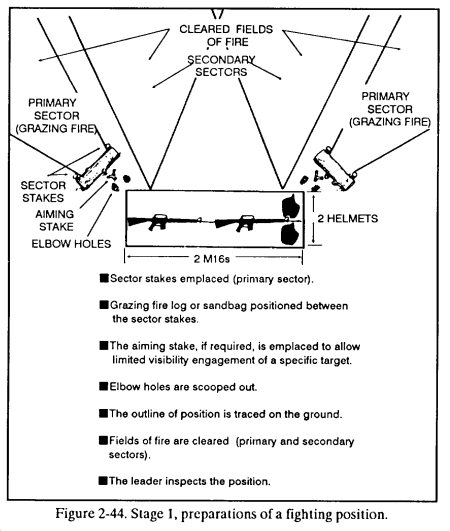
STAGE 2. The retaining walls for the parapets are prepared at this stage. These ensure that there is at least one helmet distance from the edge of the hole to the beginning of the front, flank, and rear cover (Figure 2-45).
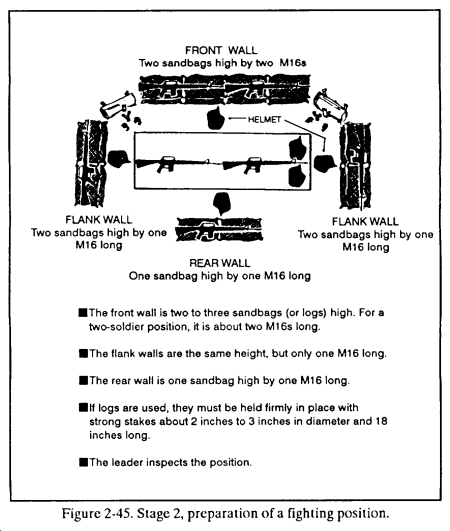
STAGE 3. During stage 3, the position is dug and the dirt is thrown forward of the parapet retaining walls and then packed down hard (Figure 2-46).
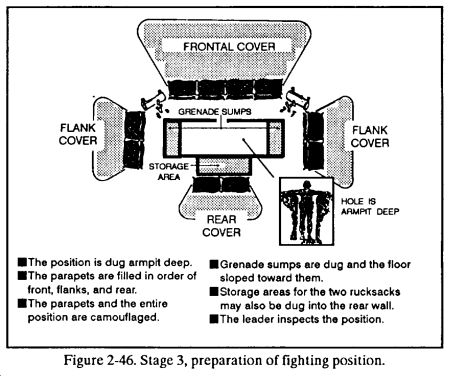
STAGE 4. The overhead cover is prepared (Figure 2-47). Camouflage should blend with surrounding terrain. At a distance of 35 meters, the position should not be detectable.
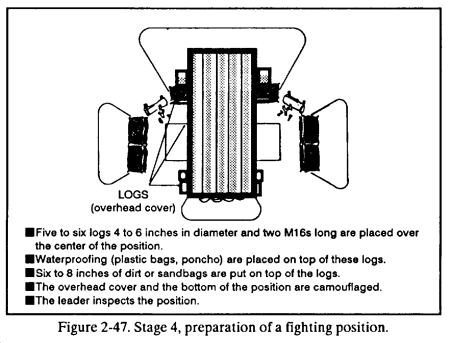
d. Types of Fighting Positions. There are many different types of fighting positions. The number of personnel, types of weapons, the time available, and the terrain are the main factors that dictate the type of position.
(1) Hasty fighting position. Soldiers prepare this type of position when there is little or no time to prepare fighting positions (Figure 2-48). They locate it behind whatever cover is available. It should give frontal protection from direct fire while allowing fire to the front and oblique. A hasty position may consist simply of a rucksack placed beside a tree or large rock. For protection from indirect fire, a hasty fighting position should be in a small depression or hole at least 18 inches deep. The term hasty position does not mean there is no digging. Even if there are only a few minutes, a prone shelter can be scraped out or dug to provide some protection. This type of position is we suited for ambushes or for protection of overwatching element during raids and attacks. Hasty positions can also be the first step in construction of more elaborate positions.
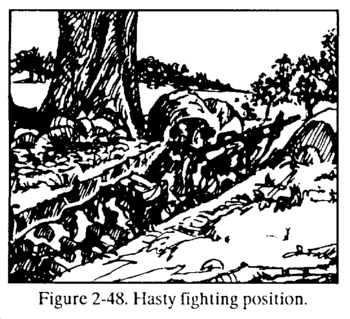
(2) One-soldier fighting position. This type of position allows choices in the use of cover; the hole only needs to be large enough for one soldier and his gear. It does not have the security of a two-soldier position. The one-soldier fighting position must allow a soldier to fire to the front or to the oblique from behind frontal cover. (Figure 2-49.)
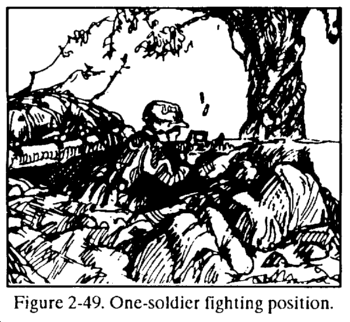
(3) Two-soldier fighting position. A two-soldier fighting position can be prepared in close terrain. It can be used where grazing fire and mutual support extend no farther than to an adjacent position. It can be used to cover dead space just in front of the position. One or both ends of the hole are extended around the sides of the frontal cover. Changing a hole this way lets both soldiers see better and have greater sectors of fire to the front. Also, during rest or eating periods, one soldier can watch the entire sector while the other sleeps or eats. If they receive fire from their front, they can move back to gain the protection of the frontal cover. By moving about 1 meter, the soldiers can continue to find and hit targets to the front during lulls in enemy fire. This type of position requires more digging and is harder to camouflage. It is also a better target for enemy hand grenades (Figure 2-50.)

(4) Three-soldier fighting position. A three-soldier position has several advantages over the other types of positions. There is a leader in each position, which makes command and control easier. It supports continuous, secure operations better than other positions. One soldier can provide security; one can do priority work; and one can rest, eat, or perform maintenance. This allows the priority of work to be completed more quickly than in a one-soldier or two-soldier position. It allows the platoon to maintain combat power and security without either shifting personnel or leaving positions unmanned. It provides 360-degree observation and fire. It is more difficult for the enemy to destroy this type position. To do so, the enemy must kill or suppress three soldiers.
(a) When using three-soldier positions, the leader must consider the following.
-
Either the distance between positions must be increased or the size of the squad’s sector reduced. The choice depends mainly on visibility and fields of fire.
-
Because the squad leader is in a fighting position that will most likely be engaged during the battle, he cannot exert personal control over the other two positions. The squad leader keeps control over the battle by–
-
Clearly communicating plans and intent to his squad to include control measures and fire plans.
-
Using prearranged signals like flares, whistles, or tracers.
-
Positioning key weapons in his fighting position.
-
Placing his fighting position so that it covers key or decisive terrain.
-
Placing his fighting position where his team might be able to act as a reserve.
(b) The three-soldier emplacement is the T-position. This basic design can be changed by adding or deleting berms, changing the orientation of the T, or shifting the position of the third soldier to form an L instead of a T. (Figure 2-51.)
-
The first layout of the position is oriented to fire on expected enemy avenues of approach from any direction(s).
-
Berms are added based on METT-T factors. They cannot block observation or fire into assigned primary or alternate sectors. Berms should be designed to support overhead constructions.
-
Logs of sufficient diameter (4 to 6 inches) or long pickets are used to support overhead cover for the position. They are placed a minimum of 1 foot back from the edge of the hole, or one-fourth the depth of the hole, whichever is greater.
-
The position is completed when natural camouflage materials are added to hide the position and strengthen it.

(5) Machine gun position. The primary sector of fire is usually to the oblique so that the gun can fire across the platoon’s front. The tripod is used on the side that covers the primary sector of fire. The biped legs are used on the side that covers the secondary sector of fire. When changing from primary to secondary sectors, the gunner moves only the machine gun. Occasionally, a sector of fire that allows firing directly to the front is assigned, but this can reduce the frontal cover for the crew when firing to the oblique. (Figure 2-52.)
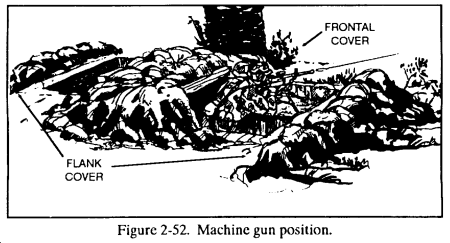
(a) After the platoon leader positions the machine gun, he marks the position of the tripod legs and the limits of the sectors of fire. The crew then traces the outline of the hole and the frontal cover (if it must be improved).
(b) The crew digs the firing platforms first to lessen. their exposure in case they have to fire before they complete the position. The platforms must not be so low that the gun cannot be traversed across its entire sector of fire. This reduces the profile of the gunner when he is firing and reduces the height of the frontal cover.
(c) After digging the firing platforms, the crew digs the hole. They first place the dirt where frontal cover is needed. They dig the hole deep enough to protect them and still let the gunner fire the gun with comfort, usually about armpit deep. When the frontal cover is high and thick enough the crew uses the rest of the dirt to build flank and rear cover.
(d) Trench-shaped grenade sumps are dug at various points so that either soldier can kick a grenade into one if needed.
(e) In some positions, a machine gun might not have a secondary sector of fire; so, only half of the position is dug.
(f) Overhead cover for a machine gun position is built the same as for a two-soldier position.
(g) When there is a three-soldier crew for a machine gun, the ammunition bearer digs a one-soldier fighting position to the flank. From his position, the ammunition bearer can see and fire to the front and to the oblique. Usually, the ammunition bearer is on the same side as the FPL or PDF. This allows him to see and fire his rifle into the machine gun’s secondary sector, and to see the gunner and assistant gunner. The ammunition bearer’s position is connected to the gun position by a crawl trench.
(6) Dragon position. The Dragon can be employed from hasty or completed positions. (Figure 2-53.) However, some-changes are required.
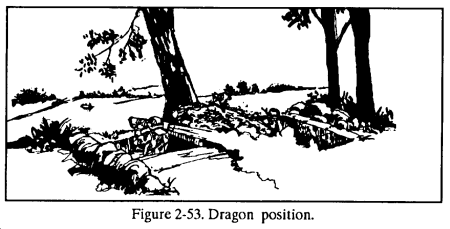
DANGER _____________________________________________________________
Dragon backblast and muzzle blast must be considered to avoid injuring personnel. When a Dragon is fired from a completed position, the muzzle end of the launcher must extend 6 inches beyond the front of the hole. The rear of the launcher must extend out over the rear of the hole.
(a) As the missile leaves the launcher, the stabilizing fins unfold. During firing, the gunner must keep the weapon at least 6 inches above the ground to allow room for the fins. The hole is only waist deep to allow the gunner to move while tracking a target. Because of the height of the Dragon gunner above ground level, the frontal cover should be high enough to hide his head and, if possible, the backblast of the Dragon. A hole is dug in front of the position for the bipod legs.
(b) There will be times when the Dragon can be fired only in one direction. The position is adjusted to have cover and concealment from all other directions.
(c) When the Dragon is fired in only one direction, it should be to the oblique. This protects the position from frontal fire and allows engagement of the target from the flank. Both ends of the launcher must extend out over the edges of the hole.
(d) Overhead cover must be built on the flanks. Cover must be large enough for the gunner, the tracker, and the missiles. Overhead cover that allows fire from underneath it can be built if the backblast area is clear. However, overhead cover must be well camouflaged.
(e) Selecting and preparing alternate positions for a Dragon have a high priority since the Dragon is an important weapon and is easy to detect. When preparing an alternate position, a covered route to it should be selected and improved so the gunner can move to it under fire.
(7) 90-mm recoilless rifle and ranger antiarmor weapon system position. Positions for the 90-mm RCLR and the 84-mm RAAWS are built like Dragon positions, except they are larger. Since two soldiers are needed to operate the weapons, the hole must be a slightly longer if the gunner must fire to the right side of the frontal cover. The assistant gunner can then work from the right side of the weapon (Figure 2-54). (Alternate positions, similar to the Dragon may be prepared.)

DANGER ______________________________________________________________
When the LAW, AT4, 90-mm RCLR, OR Flash is used from an infantry fighting position, care must be taken to ensure that no injuries result. SOLDIERS MUST BE CLEAR OF THE BACKBLAST AREA. No other fighting positions are located in the backblast area. The gunner must ensure there is nothing (walls, trees, or other objects) to the rear of the weapon to deflect the backblast.
(8) Light antitank weapon, AT4, and Flash positions. The LAW, the AT4, and the Flash can be fired from infantry fighting positions. If the LAW, AT4, or Flash is to be fired from a two-soldier position, the gunner must ensure that the other soldier is not in the backblast area. The front edge of a fighting position is a good elbow rest to help the gunner steady the weapon and to gain accuracy. The LAW or Flash gunner leans against the front or side wall of the hole for greater stability when firing. When firing the AT4, the gunner leans against the rear wall–his elbows are not supported. (Figure 2-55.)
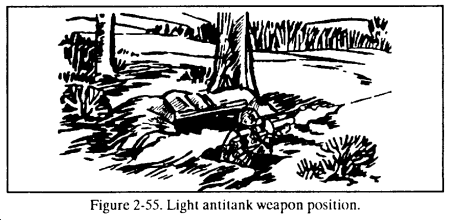
e. Trenches. When there is time and help, trenches should be dug to connect fighting positions so soldiers can move by covered routes. The depth of a trench depends on the type of help and equipment available. Without engineer help, crawl trenches (about 3 feet deep by 2 feet wide) are usually dug. The trench should zigzag so the enemy will not be able to fire down a long section of it (Figure 2-56).
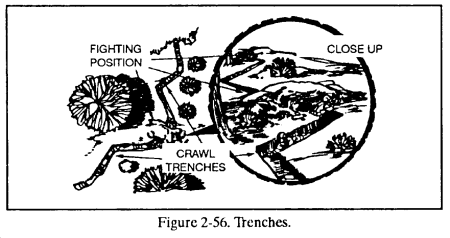
Section VI. OTHER OPERATIONS
Other tactical operations include retrograde (withdrawal, delay, and retirement and special operations (linkup, stay-behind, relief in place, and passage of lines). Squads or platoons conduct these operations as part of a larger force. A retrograde operation is an organized movement to the rear or away from the enemy.
2-28. WITHDRAWAL
In a withdrawal, a unit disengages from the enemy and repositions for another mission. Units withdraw either not under pressure or under pressure.
a. Methods of disengagement. Platoons have the basic methods of disengaging from the enemy. They can thin their lines, or they can move out by either fire team or squad.
(1) Disengagement by thinning the lines. Squad and team leaders begin the disengagement by directing soldiers to move rearward in buddy teams. Each buddy team covers the move of the other as they move back in turn (Figure 2-57). Smoke must be used to provide concealment if the soldiers are moving across open areas.
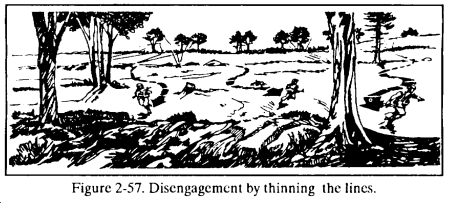
(2) Disengagement by fire teams. If enemy fire is so light that thinning the lines is not needed or if after having moved back far enough, thinning the lines is no longer needed squads can move back by fire teams. One team fires while the other one moves, alternating roles (Figure 2-58).
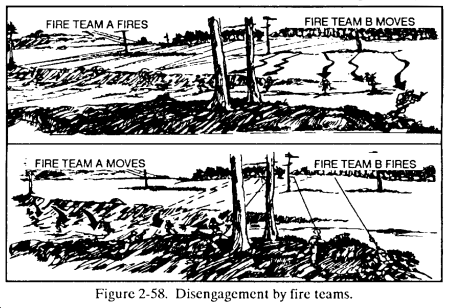
(3) Disengagement by squads. If enemy fire is so light that maneuver by fire teams is not needed or if squads have moved back to a point where it is no longer needed to move back by fire teams or by thinning the lines, the platoon moves back by squads. The platoon leader has each squad move back in turn, covered by the fire of the others (Figure 2-59).

b. Withdrawal not under pressure. In this type of withdrawal, platoons normally serve as the detachment left in contact (DLIC) or as part of the DLIC. (Figure 2-60). As the DLIC, the platoon performs the following.
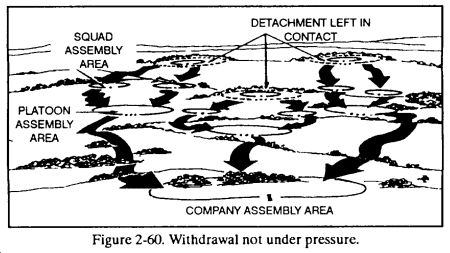
(1) Repositions squads and weapons to cover the company’s withdrawal (Figure 2-61).

(2) Repositions a squad in each of the other platoon positions to cover the most dangerous avenue of approach into the position.
(3) Continues the normal operating patterns of the company.
(4) Covers the company withdrawal by fire if the company is attacked during withdrawal.
(5) Withdraws once the company is at its next position.
c. Withdrawal under pressure. If it is not possible to prepare and position the security force, the platoon conducts a fighting withdrawal. The platoon disengages from the enemy by maneuvering to the rear. Soldiers, fire teams, or squads not in contact are withdrawn first so they can provide suppressive fires to allow the soldier, team, or squad in contact to withdraw. (Figure 2-62.)

2-29. DELAY
In a delay, the platoon forces the enemy to slow its movement by forcing him to repeatedly deploy for the attack. Before the enemy assault, the delaying force withdraws to new positions.
a. The squads and platoons disengage from the enemy as described in a withdrawal under pressure. Once disengaged, a platoon moves directly to its next position and defends again.
b. The squads and platoons slow the advance of the enemy by shaking his morale, causing casualties and equipment losses. It can employ–
-
Ambushes.
-
Snipers.
-
Obstacles.
-
Minefields (to include phony minefields).
-
Artillery and mortar fire.
2-30. RETIREMENT
Platoons and squads retire as members of larger units using standard movement techniques. A force that is not engaged with the enemy moves to the rear in an organized manner. Retirements usually involve tactical road marches.
2-31. LINKUP
A linkup is a meeting of friendly ground forces. Linkups depend on control, detailed planning, and stealth. Linkup procedure begins as the unit moves to the linkup point. The steps of this procedure are:
a. If using radio communications, the platoon reports its location using phase lines, checkpoints, or other control measures.
b. The first squad at the site stops and sets up a linkup rally point about 300 meters from the linkup point.
c. The first squad sends a security team to find the exact location of the linkup point.
d. The security team clears the immediate area around the linkup point. It then marks the linkup point with the coordinated recognition signal. The team moves to a covered and concealed position and observes the linkup point and immediate area around it.
e. The next unit approaching the site repeats steps one through three When its security team arrives at the site and spots the coordinated linkup point recognition signal, it gives the far recognition signal.
f. The first security team responds, and the second team advances to the first team’s location. The teams exchange near recognition signals.
g. If entire units must link up, the second team returns to its unit’s rally point and brings the unit forward to the linkup point. The first security team guides the entire second unit to the linkup rally point. Both teams are integrated into the security perimeter.
h. When more than two units use the same linkup point, the first unit leaves a security team at the linkup point. They repeat the linkup procedure as other units arrive.
2-32. STAY-BEHIND OPERATIONS
Stay-behind operations can be used as a part of defensive or delay missions. In the defense once the enemy’s combat units have passed, his weakest point (CS and CSS units) can be attacked.
a. Types. The two types of stay-behind operations are unplanned and deliberate.
(1) Unplanned. An unplanned stay-behind operation is one in which a platoon finds itself cut off from other friendly elements for an indefinite time without specific planning or targets.
(2) Deliberate. A deliberate stay-behind operation is one in which a platoon plans to operate in an enemy-controlled area as a separate and cohesive element for a certain amount of time, or until a specified event occurs. This requires extensive planning. Squads and platoons conduct this type of stay-behind operation only as part of larger units.
b. Planning. The troop-leading procedure applies to stay-behind operations. Planners must pay strict attention to the following:
(1) Task organization. The stay-behind unit includes only the soldiers and equipment needed for the mission. It needs only minimal logistics support and can provide its own security. It must be able (to hide easily and move through restrictive terrain.
(2) Reconnaissance. This is most important in a stay-behind operation. Reporting tasks and information requirements can include suitable sites for patrol bases, OPs, caches, water sources, dismounted and mounted avenues of approach, kill zones, engagement areas, and covered and concealed approach routes.
(3) Combat service support. Because the stay-behind unit will not be in physical contact with its supporting unit, supplies of rations, ammunition, radio batteries, water, and medical supplies are cached. Provisions for casualty and EPW evacuation depend on the company and battalion plans.
(4) Deception plan. Most stay-behind operations are setup covertly. The enemy must be mislead during this effort to cause him to act in a manner favorable to the unit’s plan of action. COMSEC is a special concern; radio transmissions must be brief and encoded.
(5) Concept of the operation. Units usually operate in small groups in their own areas. The actual concept, however, depends on the commander’s intent.
2-33. RELIEF IN PLACE
A relief in place is an operation in which a platoon is replaced in combat by another platoon. The incoming platoon assumes responsibility for the combat mission and the assigned sector or zone of action of the outgoing platoon. Normally platoons conduct reliefs in place as part of a larger unit.
a. Coordination. Platoon responsibility is usually limited to the detailed coordination between key personnel and their counterparts. Leaders must coordinate the following items as a minimum.
(1) Reconnaissance. Leaders must reconnoiter different routes into and out of the position; assembly areas; logistics points; primary, alternate, and supplementary positions; obstacles; immediate terrain; and when possible, patrol routes and OP locations.
(2) Plans and tasks. The outgoing leader must provide copies of the platoon sector sketch, fire plan, range cards for all weapons, barrier plan, minefield records, counterattack plans, and plans for any other tasks that the platoon may have been tasked to perform as a part of the defense.
(3) Relief plan. Both leaders must know which method and sequence of relief has been prescribed in the higher unit order, and how they will execute the plan. They must–
-
Know if their platoons will execute the relief by squads or as a complete platoon (method). Platoons may also execute the relief by occupying adjacent terrain, or terrain in depth rather than by relieving soldiers in position.
-
Know the order of relief for platoons within the company (sequence); include the relief of OPs by patrol.
-
Coordinate the use of guides, signals, challenge and password, and passage of responsibility for the mission and control of the platoon (normally when the majority of the incoming platoon is in place).
(4) Exchange of equipment. Leaders coordinate the exchange of tripods for crew-served weapons, phones or switchboards, and emplaced munitions (if included in the relief order). Platoons do not exchange radios or molar equipment (if attached).
(5) Exchange of supplies. Leaders identify numbers and types of supplies to be left behind and their location, to include: sensors, construction materiel, wire, and any supplies that might slow down the movement of the outgoing platoon.
b. Execution. During the execution both platoon leaders should collocate at the outgoing unit’s CP. The leader of the outgoing platoon remains responsible for the defense of the area until the majority of the incoming platoon is in position. If the enemy attacks during the relief, the leader who has responsibility for the position at the time is in control. The other leader assists with assets under his control as directed Squad leaders physically walk soldiers to positions and trade them out on a one-for-one basis. They allow time for outgoing soldiers to brief their reliefs on their positions, range cards, and other pertinent information. All leaders report completion of their portion of the relief as soon as possible.
Section VII. FIRE SUPPORT
Infantry platoons plan indirect fires to suppress, isolate, obscure, neutralize, destroy, deceive, or disrupt enemy forces. The fire planning process is used to plan indirect fires in support of offensive and defensive operations. Normally, battalions and companies conduct fire support planning and send a target list to the platoons. Platoon leaders and their FOs review the indirect fire plan to determine the need for additional targets in their area of responsibility. If a need exists for additional targets, the platoon leader requests those targets be included in the company fire plan through fire support channels. The platoon leader, however, does not wait to receive the company fire plan. He begins fire planning as soon as possible and integrates his fire plan into the company fire plan through fire support channels.
2-32. OFFENSIVE FIRE SUPPORT PLANNING
The offensive fire support plan is developed at the same time as the scheme of maneuver. The FO integrates the indirect fires, based on the platoon leader’s guidance, to support the platoon’s maneuver throughout the operation.
a. Fires are planned to support all phases of the attack. Fires are planned in front of, on, and behind the objective. Fires planned in front and on the objective support the approach, deployment, and assault of the attacking force. Fires planned beyond the objective support the consolidation and disrupt reinforcing and counterattacking forces. Fires are planned on all known or suspected enemy locations. Indirect fires are also planned on likely avenues of approach or on prominent terrain features.
b. The platoon uses smoke or white phosphorus to screen itself when moving across danger areas, when breaching obstacles, or to obscure known or suspected enemy positions.
2-33. DEFENSIVE FIRE SUPPORT PLANNING
The platoon leader and the FO plan indirect fire to support the defensive scheme of maneuver. Fire support considerations at platoon and squad level include final protective fires (FPF) and effect of smoke and illumination on defending forces.
a. Fires are planned on all likely enemy positions and on areas the enemy may use in the attack, such as OPs, support positions, avenues of approach, assault positions, dead space, flanks, and defiles. Fires are also planned in front of, on top of, and behind friendly positions to stop likely penetrations or to support a counterattack.
b. Final protective fire is a barrier of fire planned on the most dangerous enemy avenue of approach to provide immediate close protection for defending soldiers. The purpose of an FPF is to support the defeat of the enemy’s close assault against a defensive position. Therefore, it must be integrated with the platoon direct fire plan and obstacle plan. Once called for, FPFs are fired continuously. For this reason, the company commander often retains the control of FPFs. FPFs must not be called for until the enemy is in close assault of the defensive position. All platoon weapons fire along their final protective line or principle direction of fire while the FPF is being fired.
c. Defending units use smoke sparingly. Most often defending platoons use smoke to screen their movement out of a position.
d. Illumination provides artificial lighting to the defending force. Illumination should be employed on top of or behind the attacking force instead of on top of the defending force. Platoons use flares, M203 illumination rounds, and mortar and artillery illumination rounds. Flares provide early warning of the enemy approach and help to pin point his location. Grenade launcher illumination rounds provide flexible and immediate illumination, while mortars and artillery provide sustained illumination. The company commander normally retains the control of illumination in the defense.
2-34. TECHNIQUES OF INDIRECT FIRE CONTROL
The positioning of the FO and the proper procedures used to call for fire is critical in order to receive immediate indirect fire.
a. Forward Observer Positioning. The platoon leader and FO should always be together during execution This ensures close synchronization of the scheme of maneuver and plan of fire support. The platoon leader is responsible for both, but concentrates on maneuver and direct fires. The FO is the platoon leader’s principle assistant in managing indirect fires. They eat, sleep, and fight together. Each has separate requirements to communicate with higher headquarters, but will do so almost always from the same location. The platoon leaders and FO identify primary and alternate positions to ensure continuous observation during limited visibility conditions. The FO verifies and rehearses FM radio communications as the tactical situation permits. Squad leaders may be designated to observe targets and call for fire, or they can be designated as an alternate FO to the platoon FO.
(1) The platoon leader must ensure that the FO knows the overall concept of the operation to include the following:
(a) The location and description of the targets to engage.
(b) The terminal effects required (destroy, delay, disrupt, suppress) and the purpose.
(c) The communication means, radio net, call signs, and fire direction center to use.
(d) When or under what circumstances to engage targets.
(e) The relative priority of targets.
(f) The method of engagement and method of control to be used in the call for fire.
(2) If the platoon leader and the FO cannot see the targets and trigger lines or TRPs under the visibility conditions expected at the time the target is to be fired, they immediately notify the company. The company commander and fire support team (FIST) evaluate the situation and notify higher headquarters. The planning headquarters ten plans a new target at a location that meets the commander’s purpose for fire support.
b. Call for Fire. A call for fire is a message prepared by an observer. It has all the information needed to deliver indirect fires on the target. Any soldier in the platoon can request indirect fire support by use of the call for fire.
(1) Calls for fire must include–
(a) Observer identification and warning order.
-
Adjust fire.
-
Fire for effect.
-
Suppress.
-
Immediate suppression (target identification).
(b) Target location methods.
-
Grid.
-
Polar.
-
Shift from a known point.
(c) Target description. Give a brief description of the target using the acronym “SNAP.”
-
Size/shape.
-
Nature/nomenclature.
-
Activity.
-
Protection/posture.
(2) A call for fire may also include the following information (optional elements):
(a) Method of engagement. The method of engagement consists of the type of adjustments, danger close, trajectory, ammunition, and distribution.
(b) Method of fire and control.
-
At my command.
-
Cannot observe.
-
Time on target.
-
Continuous illumination.
-
Coordinated illumination.
-
Cease loading.
-
Check firing.
-
Continuous fire.
-
Repeat.
(c) Refinement and end of mission.
-
Correct any adjustments.
-
Record as target.
-
Report battle damage assessment.
(3) Examples of call for fire follow:
(a) Grid.
-
“_____ this is _____ adjust fire/fire for effect, over.”
-
“Grid _____, over. “
-
“(Target description) _____, over.”
NOTE 1. Determine a six-digit grid for the target.
NOTE 2. Determine a grid direction to the target and send after the call for fire but before any subsequent corrections.
(b) Polar.
-
“_____ this is _____ adjust fire/fire for effect, polar, over.”
-
“Direction _____, Distance _____, Up/Down _____ over.”
-
“(Target description) _____, over.”
NOTE 1. Determine the grid direction to the target.
NOTE 2. Determine a distance from the observer to the target.
NOTE 3. Determine if any significant vertical interval exists.
NOTE 4. Fire direction center must have OP location.
(c) Shift from a known point.
-
“_____ this is _____ adjust fire/fire for effect, shift (target number/registration point number), over.”
-
“Direction _____, Right/Left _____, Add/Drop _____, Up/Down _____, over.”
-
“(Target description) _____, over.”
NOTE 1. Determine the grid direction to the target.
NOTE 2. Determine a lateral shift to the target from the known point.
NOTE 3. Determine the range shift from the known point to the target.
NOTE 4. Fire direction center must have known point location and target number.
Section VIII. COMBAT SERVICE SUPPORT
CSS operations at platoon level area vital part of infantry operations. They consist of logistical and personnel functions. CSS is integrated into the tactical planning process from the starting phases of operations. Well-planned and executed CSS is a large part of mission accomplishment and success of combat operations. Like CS, CSS is a combat multiplier. Soldiers well supplied with food, water, ammunition, shelter, and medical care are more successful in accomplishing their missions than those who are not.
2-35. PLANNING OF COMBAT SERVICE SUPPORT
The company headquarters plans, coordinates, and executes CSS functions for the company. The platoon leader is responsible for CSS, just as he is for everything that relates to his platoon. He constantly stays abreast of the platoon’s CSS status and, along with the platoon sergeant, plans and executes CSS. The platoon sergeant, however, carries the bulk of this load. He consolidates information from the squad leaders, requests support from the XO or 1SG, and assigns responsibilities to squads. Squad leaders plan and implement CSS operations for their squads, and they can delegate some functions to their team leaders. SOPs address additional responsibilities and duties in detail. They should standardize as many of the routine and recurring CSS operations as possible.
2-36. RESUPPLY OPERATIONS
Squad leaders must know the supply status for each member of the squad. As materials and supplies are used, squad leaders request resupply through the platoon sergeant. Platoon and squad SOPs should establish levels of depletion for specified items of supply (for example, water, ammunition). All soldiers and leaders should report supply status once that level is reached. The platoon sergeant combines requests from all squads and forwards them to the 1SG or XO. There is no administrative/logistic net for the platoon. Logistics reports, when required, are sent on to the commander. Most resupply requests take a lot of time to transmit–line numbers should be used to save time. When operating on a nonsecure net, the platoon sergeant should encode all requests. The request is filled then or during the next resupply operation, depending on urgency. One of the most critical resupply functions is water. Even in cold areas, all personnel must drink at least two quarts of water a day to maintain efficiency. Water can be resupplied either by collecting and filling empty canteens or by distributing water cans to the platoons.
a. When water is not scarce, leaders must urge soldiers to drink water even when not thirsty. This is due to the body’s thirst mechanism, which does not keep pace with the loss of water through normal daily activity. The rate at which dehydration occurs will depend on the weather conditions and the level of physical exertion.
b. If water is in short supply, soldiers must use water sparingly for hygiene purposes. When in short supply, water should not be used to heat MREs. Water used for coffee or tea may also be counterproductive because both increase the flow of urine. However, soups are an efficient means of providing both water and nutrition when water is scarce, particularly in cold weather when heated food is desirable. A centralized heating point can be used to conserve water yet provide warmed MREs.
c. In most environments, water is available from natural sources. Soldiers should be trained to find, treat (chemically or using field expedients), and use natural water sources. The use of iodine tablets is the most common and easiest method to treat water. (Iodine tablets that are not uniformly grey in color or no longer have a firm consistency should not be used.) (See FM 21-10 and FM 21-76 for more information.)
2-37. RESUPPLY TECHNIQUES
Platoon resupply is mainly a “push” system. The platoon receives a standard package of supplies based on past usage factors and planning estimates. The following discusses the three platoon and squad resupply techniques. Whatever resupply technique they select, leaders must ensure security. This involves security at the resupply point and rotating personnel to ensure continuous manning of crew-served weapons and OPs, leader availability, and unit preparedness in case of enemy attack. Platoons use backhauling to remove residue, casualties, damaged equipment, or excess ammunition to the rear. During each resupply operation, the platoon must plan for backhauling of excess items. Backhauling can be by manpack, vehicles or aircraft. Effective backhauling lessens the platoon’s need to bury, camouflage, or otherwise dispose of unneeded material.
a. In-Position Technique. The company brings forward supplies, equipment, or both to individual fighting positions (Figure 2-63). This technique–
-
Is used when an immediate need exits.
-
Is used to resupply single classes of supply during contact or when Contact is imminent.
-
Enables leaders to keep squad members in their fighting positions.
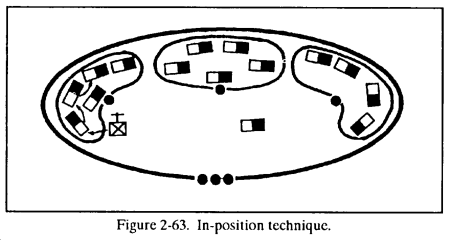
NOTE: If vehicles cannot move near platoon positions, platoon members may need to help the resupply personnel move supplies and equipment forward.
b. Service Station Technique. To use this technique, soldiers must leave their fighting positions (Figure 2-64). Selected soldiers move to a company resupply point to the rear of the platoon position, conduct resupply, and return to their fighting position. This technique is used when contact is not likely, and for one or several classes of supplies.

NOTE: The platoon order should state the sequence for moving squads or portions of squads out of position. Companies may vary the technique by establishing a resupply point for each platoon and moving the supplies to that point.
c. Pre-Position Technique. In this technique, the company prepositions supplies and equipment along a route to or at a platoon’s destination. The company then directs the platoons to the sites. Though this method is used often during defensive operations to position supplies and equipment in subsequent BPs (Figure 2-65), it can be equally effective in other operations as a cache. A cache is a pre-positioned and concealed supply point that–
-
Can be set up for a specific mission or contingency.
-
Can be used effectively by platoons and squads to reduce the soldier’s load.
-
Can be either above or below ground.
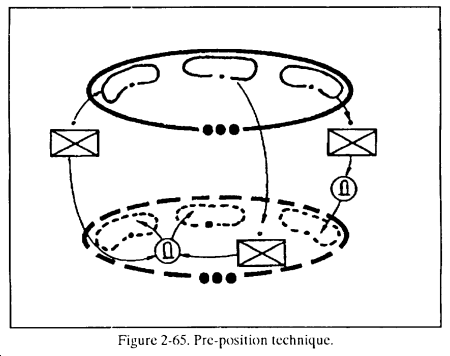
NOTE: An above-ground cache is easier to use but more likely to be found by the enemy, civilities, or animals.
2-38. AERIAL RESUPPLY
Aerial resupply is often used to get supplies and equipment to the platoon. Rotary-wing aircraft are usually more precise in delivering supplies than fixed-wing aircraft Rotary-wing aircraft deliver supplies and equipment to an LZ. Fixed-wing aircraft deliver to DZs. The platoon must secure the LZ or DZ. This helps protect the aircraft and ensure that the platoon receives the supplies. The platoon leaders uses the estimate process to find the best way to move to and secure the LZ or DZ, and to receive the supplies.
2-39. MAINTENANCE
Proper maintenance is the key to keeping equipment and materiel in good condition. It includes inspecting, testing, servicing, repairing, requisitioning, recovering and evacuating.
a. The platoon leader is responsible for the maintenance practices within his unit. He must coordinate his platoon’s maintenance efforts with the XO to ensure that the platoon is acting IAW the company maintenance effort. The platoon sergeant coordinates and supervises the platoon’s maintenance efforts. The squad leader is responsible for the maintenance of his squad’s equipment.
b. Platoon communications equipment that needs repair is turned in to the company communications chief. Platoon weapons and other equipment are recovered to the platoon or the company collection points during battle, or turned in to the supply sergeant during resupply operations.
c. All soldiers must understand how to maintain their individual and squad weapons and equipment IAW the related technical manuals. The platoon leader, platoon sergeant, and squad leaders must understand maintenance for each piece of equipment in the platoon. The platoon SOP should specify maintenance periods (at least once a day in the field) and standards for equipment and who inspects which items (usually the squad leader, with spot-checks by the platoon sergeant and platoon leader).
2-40. TRANSPORTATION
Since the infantry platoon leader has no organic transportation, he requests transportation support through the first sergeant or XO. They in turn, request it from the battalion S4 or S3 Air if it involves helicopters. Whenever possible, rucksacks and excess equipment should be transported by vehicle, unless there is a specific reason not to.
2-41. SOLDIER’S LOAD
The soldier’s load is a main concern of the leader. How much is carried, how far, and in what configuration are important mission considerations. Leaders must learn to prepare for the most likely contingencies based on available intelligence–they cannot be prepared for all possible operations. See FM 7-10 and FM 21-18 for detailed discussions on load planning, calculating, and management techniques used to assist leaders and soldiers in organizing tactical loads to ensure safety and combat effectiveness are discussed in Chapter 5.
2-42. PERSONNEL SERVICE SUPPORT
The main platoon combat personnel service support functions are strength accounting and casualty reporting. The platoon leader and NCOs are also responsible for handling EPWs and for the programs to counter the impact of stress and continuous operations. Platoon leaders coordinate personnel service support provided by the battalion S1, PAC, and chaplain through the company headquarters.
a. Strength Accounting. Leaders in the platoon use battle rosters to keep up-to-date records of their soldiers. They provide strength figures to the company at specific intervals. During combat, they provide hasty strength reports upon request or when important strength changes occur.
b. Casualty Reporting. During lulls in the battle, platoons give by-name or roster number (SOP dependent) casualty information to the company headquarters. Soldiers with direct knowledge of an incident must complete a DA Form 1155 (Figure 2-66). This form is used to report KIAs who were not recovered and missing or captured soldiers. DA Form 1156 is used to report those soldiers who have been killed and recovered and soldiers who have been wounded (Figure 2-67). The platoon leader or platoon sergeant reviews these forms for accuracy, then forwards them to the company headquarters.


c. Services. Services include mail, financial matters, awards and decorations, leaves and passes, command information, religious activities, legal assistance, welfare, rest and relaxation, and any other services related to the welfare and morale of the soldiers. Many services are standard procedure. The platoon leader must ensure that these services are available to the platoon. The first sergeant requests services for the platoon.
d. Enemy Prisoners of War. Soldiers must handle EPWs IAW international law and treat them humanely; they must not abuse them physically or mentally. EPWs must be allowed to keep their personal protective equipment. The senior officer or NCO present is responsible for their care. If a platoon cannot evacuate EPWs in a reasonable time, they must give EPWs food, water, and first aid. Soldiers should not give EPWs comfort items such as cigarettes or candy.
(1) EPWs who receive favors and those who are mistreated make poor interrogation subjects. Use the five S’s in handling EPW.
(a) Search the EPW. One soldier should guard the EPW while another searches. The soldier searching should not get between the EPW and the guard. Position the EPW spread-eagled against a tree or wall or have him get on the ground in a push-up position with his knees touching the ground. Search him and search all his gear and clothing. Take his weapons and papers, except identification papers. Give the EPW a written receipt for any personal property and documents taken.
(b) Segregate all EPWs into groups of males and females and subgroups of officers, NCOs, enlisted soldiers, civilians, and politicians. This keeps the leaders from promoting escape efforts. Keep groups segregated as they move to the rear.
(c) Silence EPWs. Do not let EPWs talk to each other. This keeps them from planning an escape and from cautioning each other on security. Report anything an EPW says or tries to say to another EPW.
(d) Speed EPWs to the rear. Platoons turn EPWs over to the company where they are assembled and moved to the rear for questioning by qualified intelligence soldiers.
(e) Safeguard EPWs when taking them to the rear. Make sure they arrive safely. Watch out for escape attempts. Do not let them bunch up, spread too far out, or start diversions, such as fist fights, that create a chance for escape. At the same time, do not allow anyone to abuse them.
(2) If an EPW is wounded and cannot be evacuated through normal channels, he is treated by an aidman and evacuated through medical channels. The EPW must be guarded by other than medical soldiers.
(3) Before evacuating an EPW, tag him with a minimal EPW tag and equipment/document tag (Figures 2-68 and 2-69) or a complete tag (Figures 2-70). The tag should be perforated into three parts and made of durable material. It should measure about 10 centimeters by 10 centimeters for each part. It should be pierced at the top and bottom, and reinforced for security for ease of attachment. (See STANAG 2044.)

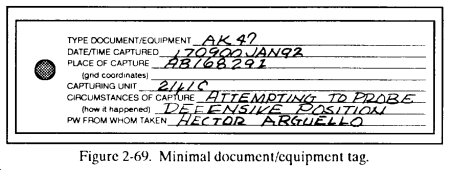
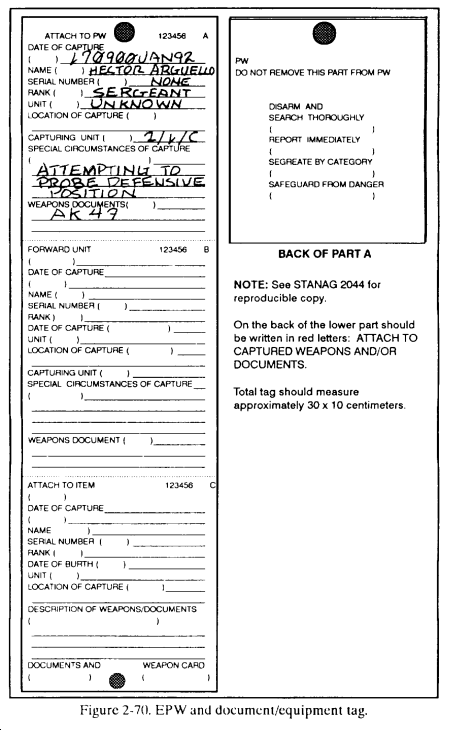
e. Captured Enemy Documents. Enemy documents are a valuable source of information; they must be processed as quickly as possible. Documents can be official or personal. When a platoon captures documents in the custody of an EPW, the platoon leader or the senior leader at the capture site is responsible for preliminary screening and for reporting the capture of enemy documents to his next higher leader. That leader is responsible for ensuring that the documents are properly tagged. The leader ensures that the documents accompany the EPW to the point of turnover to the company.
f. Captured Enemy Equipment and Associated Technical Documents. Equipment and documents (operator’s manuals, TMs, and so on) are a valuable source of information. They must be kept together and guarded throughout the capture and evacuation process to prevent looting, misuse, or destruction. Equipment and documents must be tagged. Captured enemy medical equipment and supplies will not be used on US casualties. It should be turned in for use on wounded EPWs.
2-43. HEALTH SERVICES SUPPORT
Platoon health services support consists of the prevention, treatment, and evacuation of casualties. Prevention is emphasized; soldiers can lose their combat effectiveness because of nonbattle injuries or disease. Understanding and applying the principles of field hygiene and sanitation, preventing weather-related injuries, and considering the soldier’s overall condition can eliminate many casualties. (See FMs 21-10 and 21-11.)
a. The SOP should address casualty evacuation procedures in detail. It must clearly state that personal protective equipment remains with and is evacuated with the casualty. The casualty’s weapon and equipment is retained by the platoon, redistributed as appropriate (ammunition, food, water, special equipment) or evacuated to the field trains by backhaul at the next LOGPAC. Machine guns, M203s, and other special weapons are never evacuated but are reassigned to their soldiers.
(1) The platoon SOP must include the following:
-
Duties and responsibilities of key personnel in planning and executing casualty evacuation.
-
Priorities of evacuation.
-
Provisions for retrieving and safeguarding weapons, ammunition, and equipment.
(2) Paragraph 4 of the OPORD must provide the following:
-
Location of casualty collection points (battalion, company, platoon).
-
Procedures and responsibilities for medical evacuation.
-
Planned use of nonmedical transportation assets for evacuation.
-
Procedures for treating and evacuating EPWs and civilian casualties.
-
Communication nets for evacuation requests.
-
A time when the evacuation mission will begin and the nonmedical soldiers can aid in collection and evacuation. This prevents combat power from being diverted from the mission.
b. Leaders must be prepared to treat and evacuate casualties. They must understand the plan for casualty evacuation and immediately begin to execute it once casualties occur. The platoon aidman is trained to assess, to triage, and to begin treatment of casualties. If he becomes a casualty, both the the combat lifesavers and the leaders in the platoon must be prepared m evaluate, treat. and evacuate casualties. Treatment of serious casualties means stabilizing the soldier until he can be evacuated to the battalion aid station The company and battalion casualty evacuation plans should assume responsibility for the casualties as far forward as possible. Ambulances (ground and air) should pick up the casualties as far forward as possible and the tactical situation permits. Any vehicles in the AO can be used to transport casualties.
c. At least one soldier in each squad must be trained as a combat lifesaver to help the aidman treat and evacuate casualties The lifesavers are part of the platoon aid and litter team(s). They provide initial treatment until medical personnel car treat casualties, but only after their primary infantry duties are complete. They can also help in triage, treatment, or both for soldiers after medical personnel arrive, if the tactical and medical situations allow. The platoon sergeant supervises this effort.
d. Treatment of casualties normally’ begins at the conclusion of the engagement, during the reorganization of the platoon. Casualties are treated where they fall (or under nearby cover and concealment) by the casualty himself, a buddy, an aidman, or a combat lifesaver. They are then evacuated by improvised or lightweight litters to the platoon casualty collection point. This point is chosen by the platoon leader in the OPORD or by the platoon sergeant as needed on site. When selecting the evacuation point, the leader must consider cover and concealment, security, space in which to treat casualties, route access, and air access. KIA are not collected in or near the casualty collection or evacuation points. As the casualties are collected, they are triaged (sorted) and separated for treatment. The goal is to accomplish the greatest good for the greatest number. The casualty treatment categories are immediate, delayed, minimal, and expectant.
(1) Immediate–to save Life or limb.
(a) Airway obstruction.
(b) Respiratory and cardiorespiratory failure (cardiorespiratory failure is not considered an “immediate” condition on the battlefield; it is classified as expectant).
(c) Massive external bleeding.
(d) Shock.
(e) Sucking chest wound, if respiratory distress is evident.
(f) Second or third degree burns of the face and neck, or perineum (musing shock or respiratory distress).
(g) After casualty with life- or limb-threatening conditions has been initially treated, no further treatment will be given until other “immediate” casualties have been treated.
(2) Delayed–Less Risk by Treatment Being Delayed.
(a) Open chest wound.
(b) Penetrating abdomen wound.
(c) Severe eye injury.
(d) Avascular limb without apparent blood supply.
(e) Other open wounds.
(f) Fractures.
(g) Second and third degree burns not involving the face and neck or perineum.
(3) Minimal–Can Be Self Aid or Buddy Aid. Patients in this category are not evacuated to a medical treatment facility.
(a) Minor lacerations.
(b) Contusions.
(c) Sprains.
(d) Minor combat stress problems.
(e) Partial thickness burns (under 20 percent).
(4) Expectant–Little Hope of Recovery. This category should be used only if resources are limited.
(a) Massive head injury with signs of impending death.
(b) Burns on more than 85 percent of the body surface area.
NOTE: Casualties with minor injuries can assist with recording treatment, emergency care, and defense of the area.
e. The platoon can use any of several evacuation methods. (See FM 8-10-4.)
(1) Dedicated medical evacuation assets can evacuate the casualties directly to the BAS from the point of injury or planned patient-collection points.
NOTE: If casualties are evacuated by MEDEVAC, they are taken to the medical facility that can give the proper level of care to the most serious casualty onboard, usually at least the medical clearing station in the brigade support area.
(2) The casualties can be moved by vehicle or litter to the company casualty collection point for evacuation. The OPORD should state how and when this should be done. Medical platoon ambulances attached to the company then move the casualties to the rear.
(3) The platoon sergeant can direct platoon aid and litter teams to carry the casualties to the rear.
(4) Casualties with minor wounds can either walk by themselves or help carry the more seriously wounded soldiers.
(5) In rough terrain (or on patrols), casualties can be evacuated to the BAS by aid and litter teams, carried until transportation can reach the platoon or cached and picked up later.
(6) Dead soldiers should be evacuated by backhaul on supply vehicles–not in ambulances or MEDEVAC helicopters.
f. The information in Figure 2-71 is essential in the format shown when requesting MEDEVAC.
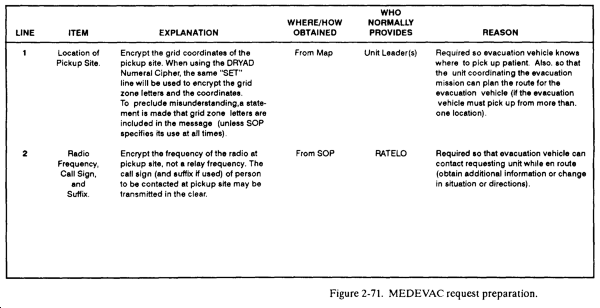
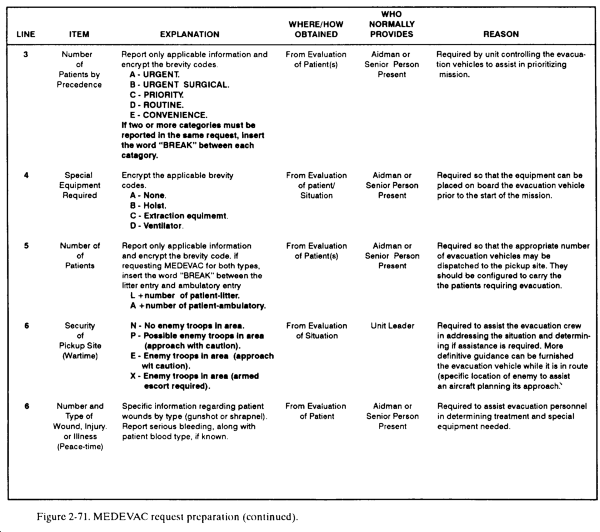
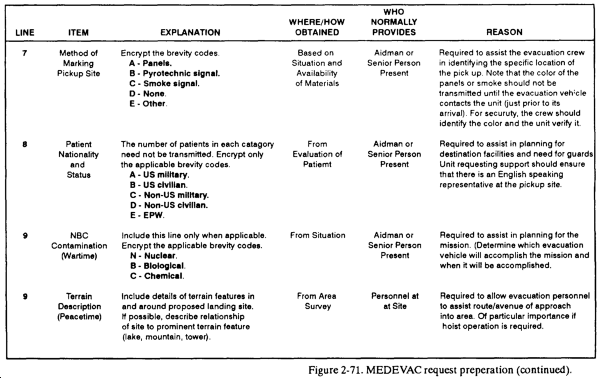
Section IX. ARMORED VEHICLE SUPPORT
Armored and mechanized forces often support infantry units in combat operations. The fundamentals and principles stated previously in this manual for tactical operations still apply. This section discusses tactics and techniques used by infantry units working with armored vehicles. It is based on an infantry platoon working with an armored vehicle platoon or two-vehicle section. (Figures 2-72 and 2-73.)
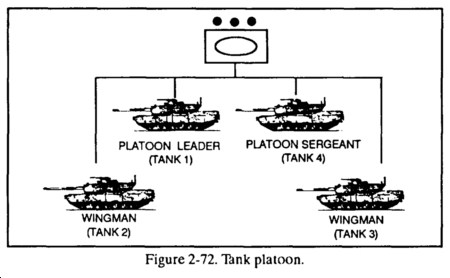
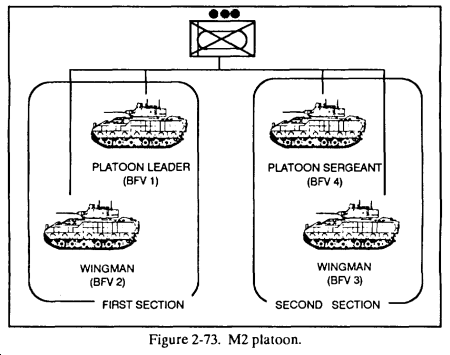
2-44. COMBINED OPERATIONS WITH ARMORED VEHICLES
Leaders must know what heavy and light forces can do for each other. In operations in which light forces predominate, airborne, air assault, or other light infantry lead the combined arms attack, all other arms support the infantry.
a. Infantrymen help heavy forces by finding and breaching or marking antitank obstacles. Infantry provides security for armored vehicles. They detect and destroy or suppress antitank weapons. They designate targets for tanks to destroy by main gun fire and continue to assist by spotting the impact of tank rounds for the gunner.
b. Heavy forces help infantry by leading them in open terrain and providing them a protected, fast moving assault weapons system. They suppress and destroy enemy weapons, bunkers, and tanks by fire and maneuver. They also provide transport when the enemy situation permits.
2-45. CONSIDERATIONS
Commanders use the estimate of the situation to determine the mix of armored and infantry forces, and the command relationship (attached or OPCON).
a. Tanks. Tank platoons use the wingman concept; the platoon leader’s tank and his wingman, and the platoon sergeant’s tank with his wingman. They operate as a four-vehicle platoon. (Figure 2-72) The TOE for a tank platoon does not break the organization down any further than the platoon. However, tanks and infantry must work closely. In most operations where they work together, infantrymen must establish direct contact with individual tanks. They will not have time to designate target or direct fires through the platoon chain of command. Infantrymen and tankers must know how to communicate by radio, phone, and visual signals.
b. Mechanized Infantry. Mechanized infantry combines the protection, firepower, and mobility of armored forces, with the close combat capability of infantry forces. Infantry adds security and close combat capability to mechanized forces while gaining from their mobility and firepower. Infantry may work together with mechanized forces or may operate in synchronization with them to clear a way through obstacles before an armored attack, hold a strongpoint while mechanized infantry maneuvers around it, or conduct MOUT missions. (Figure 2-73.)
2-46. COMMUNICATING WITH TANKS
Before an operation, infantry and tank platoon leaders must coordinate communications means and signals. This should include the use of radios; phones; and visual signals such as arm-and-hand, panel, lights, flags, and pyrotechnics. Most tanks (except the M1) have an external phone on the rear for infantrymen to use. On the M1, the infantryman can run communication wire to the tank commander through the turret. This wire can be hooked into the tank’s communication system. Leaders must be confident that tanks and infantry will be able to move and shoot without confusion.
2-47. INFANTRY RIDING ON ARMORED VEHICLES
Soldiers ride on the outside of armored vehicles routinely. So long as tanks and infantry are moving in the same direction and contact is not likely, soldiers should always ride on tanks.
a. Guidelines for Riding on all Armored Vehicles. The following must be considered before soldiers mount or ride on an armored vehicle.
(1) When mounting an armored vehicle, soldiers must always approach the vehicle from the front to get permission from the vehicle commander to mount. They then mount the side of the vehicle away from the coaxial machine gun and in view of the driver.
(2) If the vehicle has a stabilization system, squad leaders ensure it is OFF before giving the okay for the vehicle to move.
(3) The infantry must dismount as soon as possible when tanks come under fire or when targets appear that require the tank gunner to traverse the turret quickly to fire.
(4) All soldiers must be alert for obstacles that can cause the tank to turn suddenly and for trees that can knock riders off the tank.
b. Guidelines for Riding on Specific Armored Vehicles. The following information applies to specific vehicles.
(1) M1. The M1 tank is not designed to carry riders easily. Riders must NOT move to the rear deck. Engine operating temperatures make this area unsafe for riders. (Figure 2-74.)
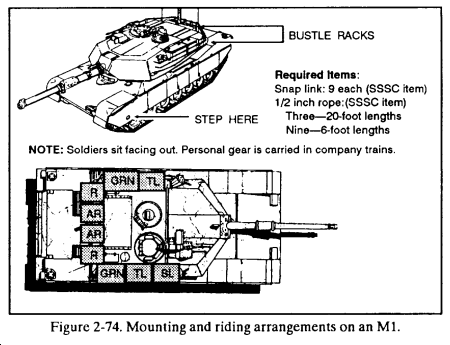
(a) One infantry squad can ride on the turret. The soldiers must mount in such a way that their legs cannot become entangled between the turret and the hull by an unexpected turret movement. Rope may be used as a field-expedient infantry rail to provide secure handholds.
(b) Everyone must be to the rear of the smoke grenade launchers. This automatically keeps everyone clear of the coaxial machine gun and laser range finder.
(c) The infantry must always be prepared for sudden turret movement.
(d) Leaders should caution solders about sitting on the turret blowout panels, because 250 pounds of pressure will prevent the panels from working properly. If there is an explosion in the ammunition rack, these panels blow outward to lessen the blast effect in the crew compartment.
(e) If enemy contact is made, the tank should stop in a covered and concealed position, and allow the infantry time to dismount and move away from the tank. This action needs to be practiced before movement.
(f) The infantry should not ride with anything more than their battle gear. Personal gear should be transported elsewhere.
(2) M60. The procedures for mounting infantry on M60-series tanks (Figure 2-75) are as follows:
(a) One infantry squad can ride on the turret or on the back deck clear of the turret. Tine problem of sudden turret movement is not as great as with Ml-series tanks, but the soldiers must still be prepared for it.
(b) Everyone must be to the rear of smoke grenade launchers.
(b) Everyone must be to the rear of smoke grenade launchers.
(c) If enemy contact is made, the tank should stop in a covered and concealed position, and allow the infantry time to dismount and move away from the tank. This action needs to be practiced before movement.
(d) Even on the M60-series, there is not enough room for the infantry to ride with anything more than battle gear.

Section X. OBSTACLES
An obstacle is any natural or man-made obstruction that turns, frees, disrupts, or blocks the movement of a force. The platoon must know how to employ obstacles and how to breach and clear obstacles. See FM 5-34 and FM 5-102 for additional information concerning obstacles.
2-48. EMPLOYING OBSTACLES
Obstacles are used in all operations, but are most useful in the defense. Obstacles are normally constructed by engineers with help from the platoon. There will be times when the unit must build obstacles without engineer help. In such cases, the leader should seek engineer advice on the technical aspects. Leaders must always consider what materials are needed and how long the obstacle will take to construct.
In the offense, the platoon/squad uses obstacles to–
-
Aid in flank security.
-
Limit enemy counterattack.
-
Isolate objectives.
-
Cut off enemy reinforcement or routes of withdrawal.
In the defense, the platoon/squad uses obstacles to–
-
Slow the enemy’s advance to give the platoon/squad more time to mass fires on him.
-
Protect defending units.
-
Canalize the enemy into places where he can more easily be engaged.
-
Separate the enemy’s tanks from his infantry.
-
Strengthen areas that are lightly defended.
a. Functions. Obstacles perform one of four tactical functions–disrupt, turn, fix, or block.
(1) Disrupt. These obstacles are used to disrupt assault formations, attacking the low-level command and control while the attacker is under direct fire.
(2) Turn. Turning obstacles move and manipulate the enemy to the force’s advantage by enticing or forcing him to move in a desired direction, by splitting his formation, by canalizing him, or by exposing his flank.
(3) Fix. Fixing obstacles slow and hold the enemy in a specific area so that he can be killed with fires, or the obstacles generate the time necessary for the force to break contact and disengage.
(4) Block. Blocking obstacles are complex, employed in depth, and integrated with fires to prevent the enemy from proceeding along a certain avenue of approach. Blocking obstacles serve as a limit, beyond which the enemy will not be allowed to go.
b. Principles of Employment. When employing obstacles, the leader considers the following principles.
(1) Support the tactical plan. Obstacles supplement combat power, decrease the mobility of the enemy, and provide security for the platoon. While considering enemy avenues of approach, he also considers his own movement requirements, such as routes for resupply, withdrawal, counterattacks, patrols, and observation posts.
(2) Tie in. He ties in his reinforcing obstacles with existing obstacles. He must also tie in the obstacle plan with his plans for fire support.
(3) Covered by observation and fire. He ensures that all obstacles are covered by observation and fire. This reduces the enemy’s ability to remove or breach the obstacles and increases the possibilities of placing fire on the enemy when he encounters the obstacles.
(4) Constructed in depth. He emplaces obstacles so that each new obstacle encountered by the enemy attrites the enemy force and causes a desired and controlled reaction. Proper use of obstacles in depth wears the enemy down and significantly increases the overall desired effect.
(5) Employed for surprise. An obvious pattern of obstacles would divulge locations of units and weapons. Friendly forces must avoid readily discernible, repetitive patterns.
2-49. TYPES OF OBSTACLES
There are two types of obstacles–existing and reinforcing.
a. Existing Obstacles. Existing obstacles are those natural or cultural restrictions to movement that are part of the terrain when battle planning begins. The location and characteristics of natural or cultural obstacles have a direct relationship to the plan of operations and the positioning of forces. Existing obstacles should be easily converted into more effective obstacles, they should be in defilade from enemy observation, they should be where friendly observation and fires can prevent enemy breaching, and they should be difficult to bypass. Existing obstacles include the following.
(1) Steep slopes. Varying degrees of incline are required to stop different types of vehicles. Tanks can negotiate slopes as steep as 60 percent. Craters, mines, abatis, and induced landslides increase the obstacle value of slopes.
(2) Escarpments. Vertical (or near-vertical) cuts and walls over 1 1/2 meters high cannot be crossed by vehicles without some type of breach. Thick rock walls, railroad embankments, and steep fills along highways are examples of escarpments.
(3) Ravines, gullies, and ditches. Generally, ravines, gullies, and ditches are obstacles to wheeled vehicles. If over 5 meters wide, these obstacles are usually effective against tracked vehicles.
(4) Rivers, streams, and canals. The major obstacle value of rivers streams, and canals is that they must be crossed by special means deepwater fording or surface or aerial means. The ease of crossing by deepwater fording and surface means is determined by the width and depth of the water obstacle, the water velocity, and the condition of the banks and bottom.
(5) Swamps and marshes. Swamps and marshes, where firm ground is lacking or is a meter or so below water level, are effective obstacles against all types of vehicles. They also severely restrict the mobility of infantry.
(6) Snow. Even on otherwise trafficable terrain, snow 1 meter deep becomes a major obstacle to personnel and vehicles.
(7) Trees. Heavy stands of trees that are 8 inches or more in diameter, spaced less than 20 feet apart, will eventually build up into an obstacle if tracked vehicles attempt to push them over and force their way through.
(8) Built-up area. The obstacle value of a built-up area depends on its size, location, and construction. The natural obstacle value of built-up areas can be increased by cratering streets; demolishing walls; overturning or derailing street or railroad cars; and constructing roadblocks from steel rails, beams, and rubble. When reinforced with mines and barbed wire, such obstacles protect against armored, mechanized, and infantry forces.
b. Reinforcing Obstacles. Reinforcing obstacles are those specifically constructed, emplaced, or detonated to tic together, strengthen, and extend existing obstacles. Careful evaluation of the terrain, to determine its existing obstructing or canalizing effect, is required to achieve maximum use of reinforcing obstacles. Installation time and manpower are usually the two most important factors. Infantry soldiers provide the most readily available source of manpower. Reinforcing obstacles include the following.
(1) Road craters. Road craters are effective obstacles on roads or trails if the areas on the flanks of the crater are tied into steep slopes or mined areas.
(2) Abatis. An abatis is an obstacle created by cutting down trees so that their tops are crisscrossed and pointing toward the expected enemy direction. It is most effective for stopping vehicles in a forest. This obstacle may be reinforced with mines and booby traps.
(3) Ditches. Ditches across roads and trails are effective obstacles. Large ditches in open areas require engineer equipment.
(4) Log hurdles. Log hurdles act as “speed bumps” on roads. They are easily installed and are most effective when used in conjunction with other obstacles.
(5) Log cribs. A log crib is constructed of logs, dirt, and rocks. The logs are used to make rectangular or triangular cribs, which are filled with dirt and rock. These are used to block narrow roads and defiles. Unless substantially built, log cribs will not stop tanks.
(6) Log posts. Log posts embedded in the road and employed in depth can effectively stop tracked vehicles. If they are not high enough to be pushed out of the way, posts can cause a tracked vehicle to throw a track if it tries to climb over. If employed with wire and mines, they can also slow infantry.
(7) Rubble. Rubble from selected masonry structures and buildings in a built-up area will limit movement through an area and provide fortified fighting positions.
(8) Wire entanglements. Wire entanglements impede the movement of infantry and, in some cases, tracked and wheeled vehicles. The materials used in constructing wire entanglements are relatively lightweight (compared to other obstacles) and inexpensive, considering the protection they afford.
(a) Triple standard concertina fence. The most common wire entanglement a platoon or squad may build is the triple standard concertina fence. It is built of either barbed wire concertina or barbed tape concertina. There is no difference in building methods. (Figure 2-76.) The material and labor requirements for a 300-meter triple standard concertina fence are–
-
Long pickets–160
-
Short pickets–4
-
Barbed wire, 400-meter reels–3
-
Rolls of concertina–59
-
Staples–317
-
Man-hours to erect–30
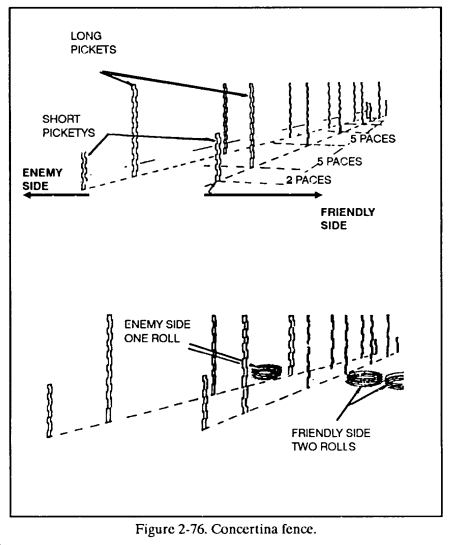
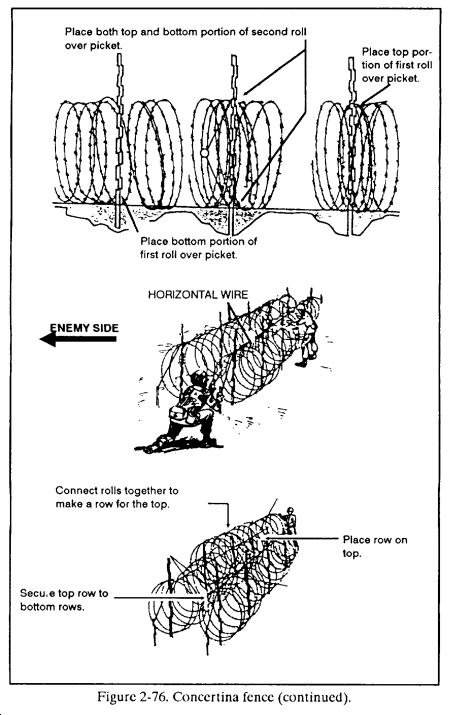
First lay out and install pickets from left to right (facing the enemy). Put the long pickets five paces apart, and the short (anchor) pickets two paces from the end of the long pickets. The enemy and friendly picket rows are offset and are placed 3 feet apart. Now layout rolls of concertina. Place a roll in front of the third picket on the enemy side, and two rolls to the rear of the third picket on the friendly side. Repeat this step every fourth picket thereafter. Install the front row concertina and horizontal wire. Place the concertina over the pickets. Install the rear row of concertina and horizontal wire. Install the top row of concertina and join the rear horizontal wire.
(b) Concertina roadblock. The concertina roadblock is placed across roadways and designed to block wheeled or tracked vehicles. The roadblock is constructed of 11 concertina rolls or coils placed together, about 10 meters in depth, reinforced with long pickets five paces apart. The rolls or coils should not be tautly bound, thus allowing them to be dragged and tangled around axles, or tank road wheels and sprockets. Additionally, wire is placed horizontally on top of the concertina rolls or coils. (Figure 2-77.)
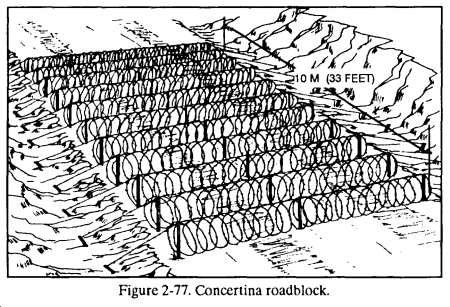
NOTE: Place three long pickets five paces apart per coil and place horizontal wire of top of coil.
(c) Tanglefoot. Tanglefoot is used where concealment is essential and to prevent the enemy from crawling between fences and in front of emplacements. The obstacle should be employed in a minimum width of 32 feet. The pickets should be placed at irregular intervals of 2 1/2 feet to 10 feet, and the height of the barbed wire should vary between 9 to 30 inches. Tanglefoot should be sited in scrub, if possible, using bushes as supports for part of the wire. On open ground, short pickets should be used.
(9) Mines. Mines are one of the most effective tank and personnel killers on the battlefield. Minefield that an infantry platoon or squad most commonly emplace are the hasty protective, point, and phony.
(a) Hasty protective minefield. In the defense, platoons and squads lay hasty protective minefields to supplement weapons, prevent surprise, and give early warning of enemy advance. A platoon can install hasty protective minefields, but only with permission from the company commander. Hasty protective minefield are reported to the company commander and recorded on DA From 1355-1-R. The leader puts the minefield across likely avenues of approach, within range of and covered by his organic weapons. If time permits, the mines should be buried to increase effectiveness, but they may be laid on top of the ground in a random pattern. The minefield should be recorded before the mines are armed. The leader installing the minefield should warn adjacent platoons and tell the company commander of the minefield’s location. When the platoon leaves the area (except when forced to withdraw by the enemy), it must remove the minefield or transfer the responsibility for the minefield to the relieving platoon leader. Only metallic mines are used in hasty protective minefields. Booby traps are not used in hasty protective minefields; they delay removal of the mines. The employing platoon must make sure that the minefield can be kept under observation and covered by fire at all times. The following example describes how to lay a hasty protective minefield.
EXAMPLE
After requesting and receiving permission to lay the minefield, the platoon leader and squad leaders reconnoiter to determine exactly where to place the mines. The leaders find a need to use antitank mines to block enemy vehicles at the bridge and the ford. The leaders decide that antipersonnel mines are needed to protect the antitank mines and to cover the likely avenues of approach of enemy infantry (Figure 2-78).
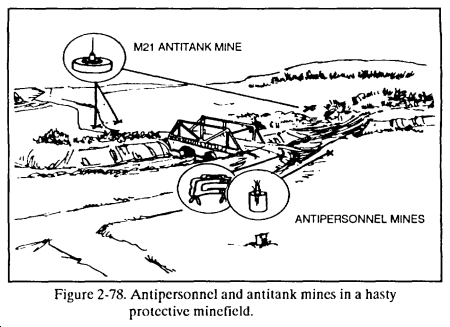
While the soldiers are placing the mines, the platoon leader finds an easily identifiable reference point in front of the platoon’s position. The platoon leader records the minefield using a reference point (Figure 2-79). The row of mines closest to the enemy is designated A and the succeeding rows are B, C, and so on.

The ends of a row are shown by two markers. They are labeled with the letter of the row and number 1 for the right end of the row and number 2 for the left end of the row. The rows are numbered from right to left, facing the enemy. The marker can be a steel picket or wooden stake with a nail or a can attached so that it can be found with a metallic mine detector.
From the concrete post, the platoon leader measures the magnetic azimuth in degrees and paces the distance to a point between 15 and 25 paces to the right of the first mine on the friendly side of the minefield. (Figure 2-80.) This point, B-1, marks the beginning of the second row.

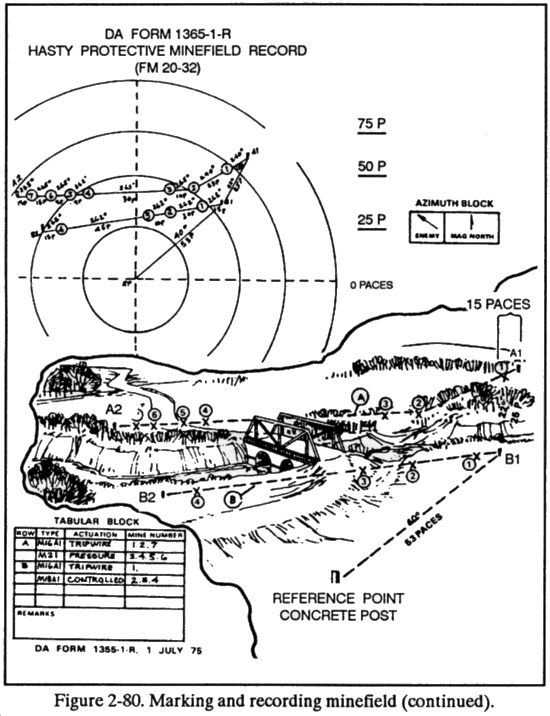
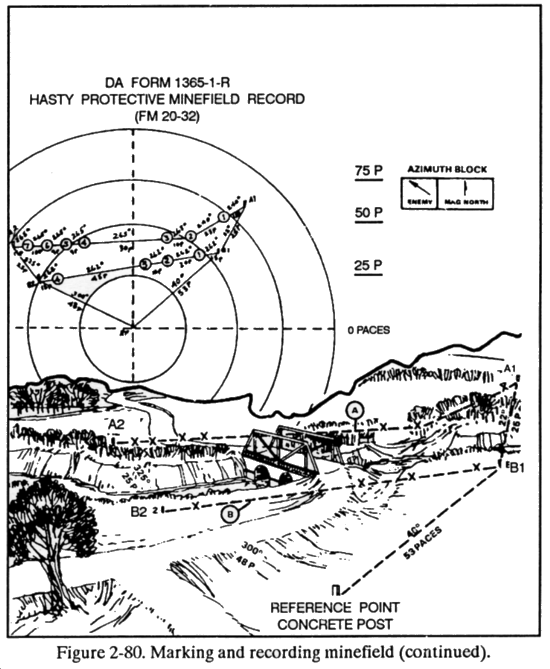
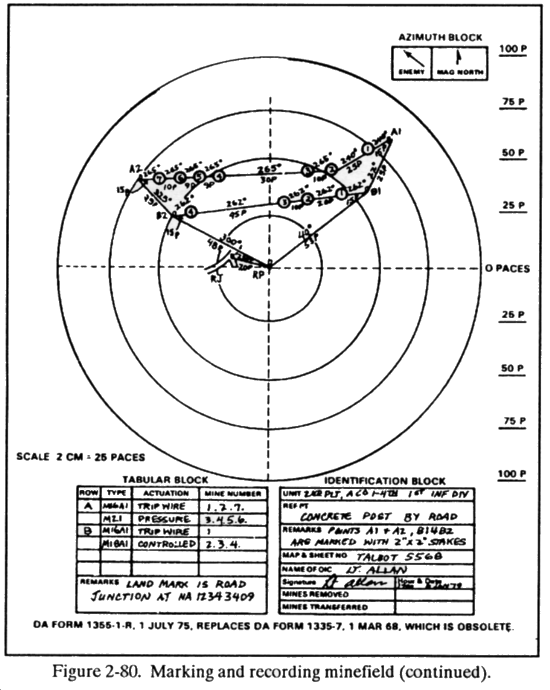
The platoon leader places a marker at B-1 and records the azimuth and distance from the concrete post to B-1 on DA Form 1355-1-R.
Next, from B-1 the platoon leader measures the azimuth and distance to a point 15 to 25 paces from the first mine in row A. He places a marker at this point and records it as A-1. The platoon leader then measures the distance and azimuth from A-1 to the first mine in row A and records the location of the mine. He then measures the distance and azimuth from the first mine to the second, and so on until all mine locations have been recorded as shown. The platoon lealder gives each mine a number to identify it in the tabular block of DA Form 1355-1-R. When the last mine location in row A is recorded, the platoon leader measures an azimuth and distance from the last mine to another arbitrary point between 15 and 25 paces beyond the last mine. He places a marker here and calls it A-2. The platoon leader follows the same procedure with row B.
When the platoon leader finishes recording and marking the rows, he measures the distance and azimuth from the reference point to B-2 to A-2, and records them. If antitank mines are being used, it is recommended that they be used at the A-2/B-2 markers, because their large size facilitates retrieval.
The platoon leader now ties in the reference point with a permanent landmark that he found on the map. He measures the distance and the azimuth from this landmark to the reference point. The landmark might be used to help others locate the minefield should it be abandoned. Finally, he completes the form by filling in the tabular and identification blocks.
While the platoon leader is tying in the landmark, the soldiers arm the mines nearest the enemy first (row A). The platoon leader reports that the minefield is completed and keeps DA Form 1355-1-R. If the minefield is transferred to another platoon, the gaining platoon leader signs and dates the mines transferred block and accepts the form from the previous leader. When the minefield is removed, the form is destroyed. If the minefield is left unattended or abandoned unexpectedly, the form must be forwarded to the company commander. The company commander forwards it to battalion to be transferred to more permanent records.
When retrieving the mines, the soldiers start at the reference point and move to B-1, using the azimuth and distances as recorded. They then move from B-1 to the first mine in row B. However, if B-1 is destroyed, they move from the reference point to B-2 using that azimuth and distance. They will now have to shoot the back azimuth from B-2 to the last mine. The stakes at A-1, B-1, A-2, and B-2 are necessary because it is safer to find a stake when traversing long distances than to find a live mine.
(b) Point minefields. Point minefield disorganize enemy forces and hinder their use of key areas. Point minefield are of irregular size and shape, and include all types of antitank and antipersonnel mines, and antihandling devices. They should be used to add to the effect of existing and reinforcing obstacles, or to rapidly block an enemy counterattack along a flank avenue of approach.
(c) Phony minefields. Phony minefields, used to degrade enemy mobility and preserve friendly mobility, are used to simulate live minefields and deceive the enemy. They are used when lack of time, personnel, or material prevents use of actual mines. Phony minefield may be used as gaps in live minefields. To be effective, a phony minefield must look like a live minefield by either burying metallic objects or making the ground look as though objects are buried.
2-50. ENEMY OBSTACLES
Platoons bypass and breach enemy obstacles. The decision to bypass or breach is based on the mission, the situation, and the assets available.
a. Bypassing. Obstacles are bypassed if at all possible. When bypassing an obstacle, the leader reports its type and location to higher head quarters. The leader must be alert for enemy contact when bypassing, because the enemy normally covers the bypass routes by fire.
b. Breaching. A breach is the employment of any means available to break through or secure a passage through an enemy obstacle. There are four types of breaches:
1. In-stride.
3. Assault.
2. Deliberate.
4. Covert.
2-51. BREACHING AND CLEARING OBSTACLES
Leaders must know the techniques used to overcome reinforced obstacles. Some obstacles may not restrict infantry units, but will restrict vehicular movement. The platoon may have to clear obstacles to help vehicles go forward. The platoon may not be able to keep the enemy from knowing that it is going to breach, but may keep the enemy from knowing where and when it will breach. The platoon breaches different obstacles using different techniques, types of equipment, and explosives. Equipment and explosives may include rocket-propelled line charges, mine detectors, bangalore torpedoes, grappling hooks, direct fire weapons, and hand-emplaced explosives. Platoons breach all obstacles using the same fundamentals (SOSR):
- Suppress the enemy to allow the breach element to create a breach.
- Obscure the breach site from enemy observation.
- Secure the breach site, execute the breach, and secure the far side.
- Reduce the obstacle to facilitate movement of follow-on forces.
a. Minefields. The objective of a minefield breach is to clear a path or lane through a mined area for friendly forces to continue their mission. The selection of lane locations should take advantage of cover and concealment, overwatching fires, and the commander’s scheme of maneuver. Breaching a minefield where it is first encountered before considering other possible sites is not recommended.
DANGER ________________________________________________________
Chemical mines are not blown in place.
(1) Step 1. Suppress the Enemy. The enemy covering the obstacle must be suppressed.
(2) Step 2. Obscure with Smoke. Smoke is used to obscure the obstacle area and conceal friendly soldiers.
(3) Step 3. Probe and Mark Mines. A footpath or lane is probed and the mines are marked. The preferred way to clear a lane through a minefield is to use a rocket-propelled line charge or bangalore torpedo. (Figure 2-81.) The only way to clear a minefield without special equipment is to probe with a pointed nonmetallic object. One squad probes while the platoon (-) overmatches. (Figure 2-82.)

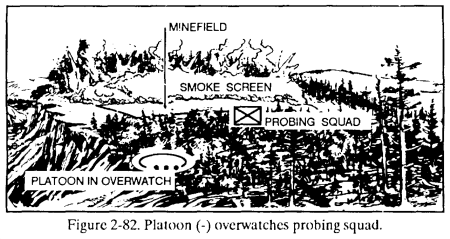
(a) The squad probing the footpath or lane through the minefield uses two probers–one in front, clearing a lane wide enough to crawl through and one prober clearing 10 meters behind and slightly to one side so that their lanes overlap.
(b) Two other soldiers crawl along behind to secure the probers, to carry additional supplies, or to take a prober’s job if one becomes a casualty. The probers should be rotated often to keep them from getting fired or careless, or both. (Figure 2-83.)
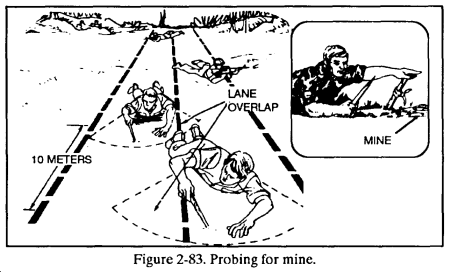
(c) The probers wear their protective vests, Kevlar helmets, and carry their NBC masks. They roll up their sleeves and remove rings and watches. LBE, rucksacks, weapons, and other metallic equipment are carried by other members of the breach force. They stay close to the ground in a prone position. They use sight and touch to detect trip wires, fuzes, or pressure prongs. The probers look and feel forward. They use a slender, nonmetallic object to probe every 2 inches across a 1-meter front. They push probe gently into ground at an angle less than 45 degrees.
DANGER ___________________________________________________________
When intelligence indicates the probability of magnetically-influenced fuzes, soldiers must not wear metallic items.
NOTE: If in a contaminated environment, probers must maintain protective posture.
(d) If the probe meets resistance and does not go into the ground freely, the prober picks the soil away with the tip of the probe and removes the loose dirt by hand. If it is a mine, they remove enough soil to see what type of mine it is. They mark its location without attempting to remove or disarm the mine.
DANGER __________________________________________________
If the probe is pushed straight down, its tip can detonate a pressure fuze.
NOTE: If a soldier is injured in a minefield, all other soldiers freeze. The nearest soldier probes his way to the injured soldier, applies first aid, and carries him out-carefully moving back through the probed lane.
(4) Step 4. Secure the Far Side. As soon as the breaching element has probed a lane, it or another element secures the far side. Infantry forces should secure the far side of an obstacle as quickly as possible. This helps keep the enemy from attacking or placing fires on the breach site. When breaching an obstacle for vehicles, if the infantry can bypass on foot, leaders should designate an element to bypass the obstacle and secure the far side while breaching effort is on-going. That element should have machine guns; light and or medium antiarmor weapons; and a map, compass, and a pair of binoculars or a thermal sight to call for and adjust fires.
(5) Step 5. Reduce the obstacles. Marked mines are destroyed with explosives or grappling hooks. Metallic mines must be destroyed before moving soldiers through the lane.
(6) Step 6. Mark Cleared Lane. The squad marks the cleared lane.
(7) Step 7. Move Unit Through the Obstacle. The leader moves the unit through the obstacle.
b. Tank Ditches. SOSR is applied in breaching tank ditches. Infantry can reduce tank ditches by bringing down the sides of the ditch with D-handled shovels, helmets, or explosives. An armored combat earth mover, tank with blades, or combat engineer vehicle should be used to reduce the obstacle quickly. (Figure 2-84)
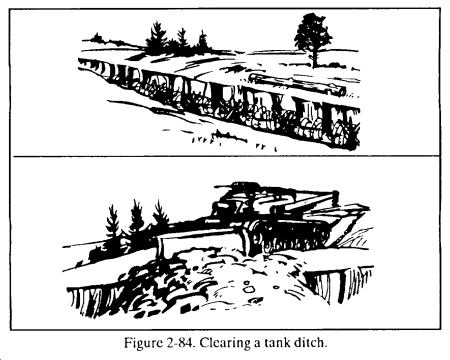
c. Craters. SOSR is applied. A crater is reduced using the same steps as a tank ditch.
d. Wire. SOSR is applied. If vehicles are available, they should be used to pull wire entanglements off assault paths, detonating antipersonnel mines in the process. Another method is for soldiers to prepare and emplace material over the wire to make an assault footpath. The assaulting unit must first clear the wire of antipersonnel mines before laying material onto the wire. Another method is to cut through the wire obstacle as described below, after suppressing the enemy and obscuring their visibility.
(1) Clear a Lane Through the Wire. Wire cutters, bangalore torpedoes, or explosives are used to remove the wire. The clearing squad checks for and marks mines and booby traps. one squad breaches while the platoon (-) overwatches. Tank fire (HEP), combat engineer vehicle fire, and massed indirect and direct fire can help breach the wire, if available.
(2) Secure the Far Side. As soon as the clearing squad has cleared a lane, it secures the far side.
(3) Reduce the Obstacle. Marked mines are destroyed with explosives or grappling hooks.
(4) Mark Cleared Lane. The cleared lane is marked.
Section XI. NUCLEAR, BIOLOGICAL,
AND
CHEMICAL OPERATIONS
Nuclear, biological, and chemical weapons cause casualties, destroy or disable equipment, restrict the use of terrain, and disrupt operations. They are used separately or in combination with conventional weapons. The platoon must be able to fight on an NBC-contaminated battlefield. Soldiers must train to standard on NBC tasks IAW STP 21-1-SMCT, STP 21-24-SMCT; FM 3-100; AR 350-42; and DA Pam 350-38.
2-52. OPERATING IN A NUCLEAR ENVIRONMENT
Information about possible enemy use of nuclear weapons is forwarded to companies and smaller units through the chain of command by the quickest and most secure means. The communication to these units need contain only–
-
A proword signaling that the message is a nuclear strike warning.
-
A brief message, IAW SOP, that directs the unit either to take specific protective actions or to evacuate the area.
a. Alarm for Nuclear Hazard. As soon as a soldier using a monitoring device detects a nuclear hazard, he should warn others. The alarm must be passed swiftly throughout the platoon.
(1) FALLOUT is the standard (shouted) alarm. It is also used when the platoon moves into an area contaminated by residual radiation.
(2) ALL CLEAR is used to signal that the danger no longer exists. This signal is first given by the company commander or a platoon leader and then repeated by each soldier when he hears it.
b. Nuclear Protective Measures. Many basic infantry skills and tasks contribute to the squad’s/platoon’s nuclear preparedness.
(1) A soldier protects himself against many nuclear effects by taking cover in a fighting position, culvert, or ditch, or behind a hill In most cases, a fighting position with overhead cover provides the best protection.
(2) Soldiers react to an unexpected nuclear attack.
c. Procedures Following a Nuclear Detonation. The following actions should be taken automatically and without order right after the shock wave from a nuclear detonation passes.
(1) Leaders.
-
Reestablish the chain of command and communication.
-
Reestablish security and report to higher headquarters–situation reports and initial NBC 1 report.
(2) Soldiers.
-
Check for injuries and give emergency first aid.
-
Check radios for proper operations and reestablish communications if required.
-
Give an immediate status report to higher.
-
Take actions to repair fighting positions.
-
Start continuous monitoring with radiacmeters.
-
Continue the mission.
d. Radiological Monitoring. Radiological monitoring is the detection (presence and intensity) of residual radiation by the use of radiacmeters. Monitoring is essential down to squad level to prevent overexposure to radiation. The IM-174 or AN/VDR-2 series radiacmeters are the instruments used for area monitoring and survey. The IM-93 or DT236 dosimeters are the instruments used to measure total dose radiation received by soldiers. The two types of monitoring techniques are periodic and continuous. Platoons will return to periodic monitoring when ordered by higher or when the radiacmeter reading falls below 1 cGy per hour.
(1) Periodic monitoring is frequent checks of the platoon area for radiation. During periodic monitoring, the platoon takes a reading with the IM-174 at least once each hour. SOPs may require more frequent readings and detailed information when monitoring.
(2) Continuous monitoring is the continuous surveillance for radiation in the unit area or position. The platoon begins monitoring when–
-
A nuclear detonation is observed or reported.
-
An NBC-3 nuclear report is received from higher headquarters.
-
A dose rate of 1 centigray (cGy) per hour is recorded during periodic monitoring. Centigray (cGy) is a unit of absorbed dose of radiation formerly called a rad.
-
Ordered by higher.
2-53. OPERATING IN A CHEMICAL AND BIOLOGICAL ENVIRONMENT
Threat forces have both chemical and biological weapons that can be used separately, together, or with nuclear and conventional weapons. Regardless of how these weapons are used, the platoon must be able to survive to be able to continue its combat mission.
a. Characteristics of Chemical Agents. Chemical agents are used to cause casualties, degrade performance, slow maneuver, restrict terrain, and disrupt support. They can cover large areas and may be placed on a target as a vapor, liquid, or aerosol. Chemical agents can be disseminated by artillery, mortars, rockets, missiles, aircraft spray, bombs, and landmines. See Figure 2-85 for additional information on characteristics of chemical weapons.

b. Characteristics of Biological Agents. Biological agents are disease-producing germs. These agents may be dispersed as aerosols by generators, explosives, bomblets, missiles, and aircraft. Harmful germs may also be spread by the release of infected insects, such as flies, mosquitos, fleas, and ticks.
c. Alarms for Chemical Hazard or Attack. Soldiers must immediately stop breathing, mask, and give vocal or visual signals when chemical agent symptoms are displayed or when the M8A1 alarm sounds.
(1) Standard alarms include the vocal signal GAS, prescribed arm-and-hand signals, automatic chemical-agent alarms, rapid and continuous beating on any metal object that produces a loud noise, a succession of short blasts on a vehicle horn or any other similar device, or a broken warbling siren sound (for example, 10 seconds on, 10 seconds off). (Figure 2-86.)

(2) The vocal ALL CLEAR signals that the danger no longer exists. It is given by leaders (company commander or platoon leader) after prescribed unmasking procedures have been completed.
d. Protective Measures in Chemical and Biological Warfare. An attack can occur without warning. Soldiers must know exactly what to do and how to do it without hesitation. Their lives depend on it.
(1) Chemical attack. A soldier’s main protection against a chemical attack is his protective mask. The mask protects against inhaling chemical agents. If an attack is imminent or if chemicals have already been employed, soldiers should mask when–
-
Chemical alarms or detection kits signal the presence of chemical agents.
-
Any artillery, mortar, rocket, or aircraft attack with other than HE munitions occur on or near their position.
-
Smoke or mist of an unknown source appears in the area. A chemical attack is suspected for any other reason, such as enemy soldiers seen wearing protective masks and clothing, or presence of dead animals or people with no outward sign of injury.
-
The platoon must enter an area known to be or suspected of being contaminated by a chemical or biological agent.
-
For no obvious reason, soldiers have any of the following symptoms:
-
A runny nose.
-
A feeling of choking or tightness in the chest or throat.
-
Blurred vision or trouble focusing.
-
Difficulty in or increased rate of breathing.
(2) Biological attack. Information on the enemy’s use of biological agents is passed from higher to lower. The best local defense against biological warfare is strict enforcement of all preventive medicine (prescribed immunizations) and field sanitation measures plus high standards of personal hygiene. Soldiers should eat and drink only from approved sources.
e. Individual Actions Before a Chemical Attack. If a platoon learns that it is subject to an imminent chemical attack or downwind vapor hazard, each soldier should take the following precautionary measures:
-
Place the chemical-agent alarm into operation.
-
Assume MOPP level 2, 3, or 4 (depending on the situation).
-
Attach M8/M9 paper to personnel and vehicles.
-
Cover as much equipment as possible.
-
Ensure decontamination equipment is accessible.
-
Be prepared to move from the location on order.
f. Individual Actions During a Chemical Attack. Actions are IAW Battle Drill 5, Chapter 4.
g. Individual Actions After a Chemical Attack. Soldiers check for casualties, give first aid, identify the agent, send NBC-1 or NBC-4 report, request permission to move, schedule decontamination operations, and mark area to warn friendly soldiers.
h. Conditions for Unmasking. The senior person present follows these procedures:
(1) Procedures with detector kit. The M256 chemical-agent detector kit is used to test for the presence of chemical agents. This takes about 15 minutes. If there is no evidence of agents, one or two soldiers unmask for 5 minutes, then remask. They are observed for chemical-agent symptoms for 10 minutes in a shady area. (A shady area is used because light causes contraction of the pupils, which could be interpreted as a nerve-agent symptom.) If no symptoms appear, the squad/platoon contacts higher headquarters for permission to unmask. Once permission is granted, the rest of the soldiers can safely unmask.
(2) Procedures without detector kit. The following is an emergency field expedient when friendly elements have been masked for a long time, when there are no remaining signs of chemical agent use, and when the platoon has no detector kit. One or two soldiers are selected to hold deep breaths, break the seals of their masks, and keep their eyes wide open for 15 seconds. They then clear their masks, reseal them, and wait for 10 minutes. If symptoms do not appear after 10 minutes, the same soldiers again break their seals, take two or three breaths, and clear and reseal their masks. After another 10-minute wait, if symptoms have not developed, the same soldiers unmask for 5 minutes and then remask. After 10 more minutes, if symptoms have not appeared, the rest of the group can safely unmask once permission is granted from higher headquarters. They should all remain alert for the appearance of any chemical symptoms. This procedure takes about 35 minutes.
i. Mission-Oriented Protection Posture. Once chemical agents have been employed or while the threat of enemy chemical attack exists, the unit commander decides whether to keep all or only some of the soldiers masked and in chemical-protective clothing. The MOPP level directed by the unit commander specifies what equipment to wear and what precautionary measures to use. (Figure 2-87.) There is also a mask-only category of MOPP. The mask-only command may be given if no liquid hazard or mustard agent vapor is present. These levels apply in all cases to the soldiers inside or outside vehicles. Leaders should take every opportunity to train their soldiers in all levels of MOPP using simulated NBC conditions. There is a significant loss of effectiveness caused by operation in MOPP 4. When soldiers are using full NBC protective equipment, judgment is degraded, communications are less effective, and information flow is reduced.
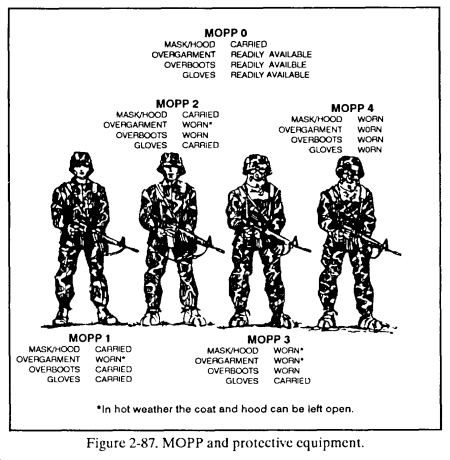
Section XII. OBSERVATION POSTS
Observation posts are positions where soldiers watch and listen for enemy activity in an assigned area OPs provide security and intelligence for the platoon. Platoons establish and maintain OPs as the company commander directs (normally one per platoon).
2-54. CONSIDERATIONS
When planning an OP the platoon leader must consider the following.
a. Siting. Normally the platoon leader identifies the general location and the squad leader selects the actual site for the OP.
(1) OPs must be sited to allow observation of the designated area.
(2) OPs should also be sited to take advantage of natural cover and concealment to provide protection for the soldiers manning it.
(3) OPs should be located within small-arms range of the platoon positions.
b. Observation. When he identifies the general location for the OP. the platoon leader must also indicate the area to be observed and any specific instructions covering what soldiers are to look for or be especially alert to. The area observed may be a sector, one or more avenues of approach (normally one per OP), a named area of interest (NAI), or a target reference point (TRP). OPs should also require minimal repositioning for limited visibility.
c. Cover and Concealment. Sometimes the requirement for fields of observation may make it difficult to achieve cover and concealment. Some techniques include–
-
Avoid obvious terrain such as hilltops.
-
Avoid easily identifiable terrain features such as water towers, church steeples, tallest buildings, lone buildings or trees, or isolated groves.
-
Avoid routes or positions that skyline soldiers.
-
Select a covered and concealed route to and from the OP.
d. Communications. Soldiers must be able to report what they see and hear. Wire is the primary means of communications between the OP and the platoon. If possible, the OP should have radio communications as a backup. An additional soldier may be added as a messenger if no other means of communication is available. The SOP should specify how often OPs make routine communications checks. When the platoon loses wire communications with the OP, the leader always details at least two soldiers to check and repair the line–one for security, one for repair. Soldiers checking for breaks in wire should always approach the OP with caution in case the enemy has captured and occupied it.
e. Manning. At least two soldiers must man each OP. A fire team may man the OP if it will remain in place or not be relieved for long periods. All soldiers prepare fighting positions at the OP for protection and concealment. Additionally, each soldier must have a prepared position to return to in the platoon position.
f. Additional Instructions. In addition to the intelligence and security reporting requirements, the squad leader also briefs the soldiers manning the OP on the challenge and password, the running password, when to engage and when not to engage the enemy, conditions when the OP can withdraw, when to expect relief, and contingency plans for loss of communications.
g. Equipment. Special equipment for the OP includes binoculars, maps, a compass, night vision devices (goggles or an antiarmor thermal sight), trip flares and other alert devices, a field phone, paper and pencil, and a watch.
2-55. ACTIONS AT THE OBSERVATION POST
Once the squad leader has positioned and briefed the soldiers at the OP site, one soldier always observes and records while the remainder perform(s) the actions listed below:
-
Establish security. Install trip flares and noise-making devices.
-
Prepare positions to include range cards. Record data for use in requesting and adjusting fire; for example, azimuths and ranges to TRPs.
-
Make communications checks or report as required.
-
Rotate duty as the observer every 20 to 30 minutes. An observer’s efficiency quickly decreases after that time.
-
Brief relieving soldiers on any information or special instructions before departing the OP. The frequency of reliefs for OPs depends on the physical condition of the soldiers, weather conditions, morale, the number of soldiers available for relief, and the requirements of the next operation. As a guide, OPs should be relieved every two to four hours.
-
Withdraw as directed or to avoid capture. Soldiers manning the OP advise the platoon leader that they are returning and request support (direct or indirect) if needed. Leaders must alert all soldiers in the platoon when reliefs move to or from the OP, and when it withdraws.
2-56. SQUAD-SIZED OBSERVATION POST
A squad may occupy one OP to add security and combat power when the platoon has a mission to screen the flank of a larger force or to secure a large area. The squad-sized OP allows the platoon to observe from OPs and to conduct patrols between them. Leaders use the same considerations listed above in planning and siting squad-sized OPs. The squad leader spreads his soldiers out in two-or three-soldier positions. Each position acts as an OP to observe an assigned sector.
2-57. VISUAL TERRAIN SEARCH
A visual terrain search involves the two steps discussed below. (See Section XIV for a detailed discussion of night vision.) Observation posts report all information quickly, accurately, and completely. They make sure that the report answers the questions WHO, WHAT, WHERE, and WHEN. It is best to use the SALUTE format when reporting information.
a. Step 1. The observer makes an overall search of the entire area for obvious targets, unnatural colors, outlines, or movement. To do this quickly, he raises his eyes from just in front of his position to the greatest range he wants to observe. If the sector is wide, he observes it in sections. (Figure 2-88.)
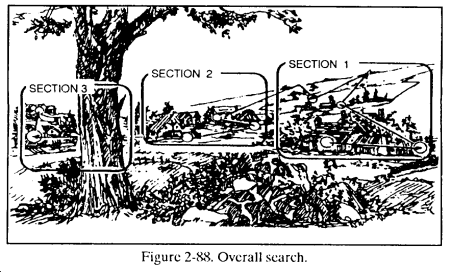
b. Step 2. He observes overlapping 50-meter wide strips, alternating. from left to right and right to left until he has observed the entire area. (Figure 2-89.) When he sees a suspicious spot, he searches it well.
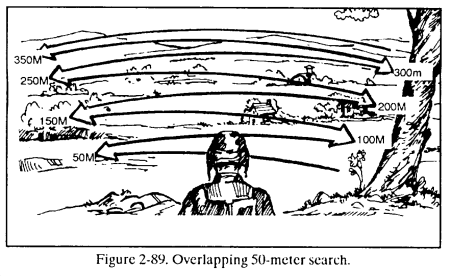
Section XIII. TECHNIQUES OF FIRE
Leaders must know fire distribution, fire control, and methods of engaging targets with antiarmor weapons.
2-58. FIRE DISTRIBUTION
Leaders must distribute the fires of their organic weapons to destroy or suppress enemy positions. There are two ways to distribute fire on a target–point fire and area fire.
a. Point Fire. This is fire directed at one point; for example, an entire team or squad fires at one bunker. (Figure 2-90.)
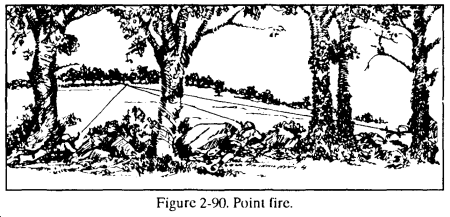
b. Area Fire. This type of fire covers an area laterally and in depth. (Figure 2-91.) If a squad leader wants fire on a wood line, he can shoot tracers to mark the center of the target. Soldiers on his left fire to the left of the tracers; soldiers on his right fire to the right.
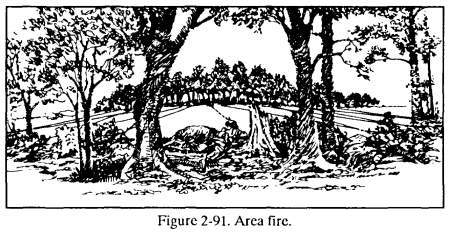
2-59. FIRE CONTROL
Leaders must decide which fire control method or combination of methods will work in each tactical situation. They must ensure the fires of their units are effective.
a. Methods of Fire Control.
(1) Sound signals. This includes both voice and devices such as whistles and horns. Sound signals are good only for short distances. Their range and reliability are reduced by battle noise, weather, terrain, and vegetation.
(2) Trigger points/lines. The leader can prearrange for soldiers to start firing once the enemy reaches a certain point or terrain feature. When this method of fire control is used, the soldiers do not have to wait for an order to start firing. Prearranged fire can also be cued to friendly actions.
(3) Visual signals. The leader can give a visual signal when he wants the soldiers to begin, cease, or shift fire as soon as they see or hear the signal. Platoons can also use visual signals triggered by the enemy.
(4) Time. The platoon may be directed to begin, shift, and cease firing at a set time.
(5) Techniques of fire.
(a) Search-fire-check.
-
Step 1. Soldiers search their sectors for enemy targets.
-
Step 2. Soldiers fire at any targets (appropriate for their weapon) that appear in their sectors.
-
Step 3. While searching their sectors, soldiers look to their leaders for specific orders.
(b) Return-fire. This technique tells each soldier in the platoon what to do in use the platoon makes unexpected contact with the enemy.
(c) Rate-of-fire. This technique tells each soldier how fast to fire at the enemy. The rate of fire varies among weapons, but the principle is to fire at a maximum rate when first engaging a target and then slow the rate to a point that suppresses the target and conserves ammunition.
NOTE: Buddy teams fire their weapons at varied rates so that they do not run out of ammunition at the same time.
b. Fire Commands. Leaders use fire commands to direct the fires. A fire command has the following six parts:
(1) Alert. In this part of the command, the leader alerts the soldiers to receive further instruction. He can alert the soldiers by name or unit designation, by some type of visual or sound signal, by personal contact, or by any other practical way.
(2) Direction. In this part of the fire command, the leader tells the soldiers the general direction to the target. In some cases, it pinpoints a target. There are three ways to give the direction to the target.
(a) The leader points with his armor rifle.
(b) The leader fires tracer ammunition at a target.
(c) The leader uses either TRPs or easily recognized man-made objects or terrain features. He gives the general direction just before he gives the references point.
(3) Description. In this part of the fire command, the leader describes the target briefly but accurately. The formation of enemy soldiers is always given.
(4) Range. In this part of the fire command, the leader tells the soldiers the range to the target in meters.
(5) Method of fire. In this part of the fire command, the leader tells the soldiers which weapons to fire. He can also tell the type and amount of ammunition to fire, and the rate of fire.
(6) Command to fire. In this part of the fire command, the leader tells soldiers when to fire. He can use an oral command, a sound, or a visual signal. When he wants to control the exact moment of fire, he says, AT MY COMMAND (then pauses until ready to commence firing). When he wants to start firing upon completion of the fire command, he just says FIRE.
c. Subsequent Fire Commands. These commands adjust or change information given in the initial fire command. Only the elements that change are given.
d. Termination of Fire. Fire is terminated by the command or signal for CEASE FIRE, END OF MISSION.
2-60. METHODS OF ENGAGEMENT WITH LAW AND AT4
The four methods of engaging targets with both the LAW and the AT4 are single, sequence, pair, and volley firing.
a. Single Firing. In single firing, one soldier engages a target with one LAW or AT4–there are no follow-on shots. This method is mostly for use at short ranges (50 meters or less with the LAW, 200 meters or less with the AT4). The single-firing method can be effective at greater ranges tout to 200 meters with the LAW, out to 300 meters with the AT4) when the exact range to the target is known.
b. Sequence Firing. In sequence firing, one firer armed with two or more LAWs or AT4s engage a single target. The firer–
-
Inspects and prepares the weapons for firing and lays them side by side.
-
Fires and observes the impact of the round.
-
If he hits the target, continues to fire follow-on rounds until the target is destroyed or until ordered to cease fire.
-
If he misses, applies burst-on-target corrections with follow-on rounds until the target is hit. He then fires until he destroys the target or until ordered to cease fire.
c. Pair Firing. In pair firing, two or more firers each armed with two or more LAWs or AT4s engage the same target. They exchange in formation throughout the target engagement.
(1) The first firer who sees the target identifies it, announces the estimated range and the lead he will use, and fires.
(2) The second firer observes the firing, announces a revised estimate of range and lead (if appropriate), and fires.
(3) The firers continue exchanging range and lead information until the target is hit.
(4) Once the range and lead have been determined, both firers, on command, engage the target until it is destroyed or until ordered to cease fire.
d. Volley Firing. In volley firing, more than one firer engages the same target using one or more LAWs and AT4s. Volley firing should be used when the range to the target has been determined. This method is desirable because more rounds are fired at a given time, thus increasing the probability of hitting/killing the target. (FM 23-33 and FM 23-25.)
Section XIV. LIMITED VISIBILITY TECHNIQUES
The infantry fights at night to take advantage of limited visibility. The use of NVDs and scanning techniques aids the infantryman in operating during all limited visibility conditions. This section provides techniques for improving and maintaining night vision, and techniques for attacks during limited visibility.
2-61. NIGHT VISION
Darkness affects the senses of sight, hearing, and smell. Sharpening these senses requires training. Soldiers must know how their eyes function at night to best use them.
a. Night Vision Scanning. Dark adaptation is only the first step toward making the greatest use of night vision. Scanning enables soldiers to overcome many of the physiological limitations of their eyes. It can also reduce confusing visual illusions. This technique involves looking from right to left or left to right using a slow, regular scanning movement (Figure 2-92). At night, it is essential to avoid looking directly at a faintly visible object when trying to confirm its presence.

b. Use of Off-Center Vision. The technique of viewing an object using central vision is ineffective at night. This is due to the night blind spot that exists during low illumination. Soldiers must learn to use off-center vision. This technique requires viewing an object by looking 10 degrees above, below, or to either side of it rather than directly at it (Figure 2-93).

c. Countering of the Bleach-Out Effect. Even when soldiers practice off-center viewing, the image of an object bleaches out and becomes a solid tone when viewed longer than two to three seconds. By shifting his eyes from one off-center point to another, the soldier can continue to pick up the object in his peripheral field of vision.
d. Shape or Silhouette. Visual sharpness is greatly reduced at night; therefore, objects must be recognized by their shape or outline. Knowing the design of structures common to the area of operations enhances success with this technique.
2-62. DARK ADAPTATION
Dark adaptation is the process by which the human body increases the eyes’ sensitivity to low levels of light.
a. Soldiers adapt to darkness at varying degrees and rates. During the first 30 minutes in the dark, eye sensitivity increases about 10,000 times, but not much alter that.
b. Dark adaptation is affected by exposure to bright light such as matches, flashlights, flares, or vehicle headlights. Full recovery from these exposures can take up to 45 minutes.
c. Using night vision goggles impedes adaptation. However, if a soldier adapts to the dark before donning the goggles, he gains full dark adaptation within 2 minutes when they are removed.
d. Soldiers must know that color perception decreases at night. They may be able to distinguish light and dark colors depending on the intensity of reflected light.
e. Visual acuity is also reduced. Since visual sharpness at night is one-seventh of what it is during the day, soldiers can see only large, bulky objects. This means that object identification at night is based on generalized contours and outlines. Depth perception is also affected.
CAUTION _____________________________________________________________
Although night vision devices can help the soldier see at night, they degrade the other senses. Ability to hear, smell, and feel decreases because of the concentration required to use NVDs effectively. Leaders should prepare for night operations by using all the senses. On certain operations, this may require that some soldiers not use NVDs.
2-63. PLANNING THE USE OF NIGHT VISION/SENSOR ASSETS
Leaders must develop a night vision plan that interlocks sectors of NVD employment much like that planned for interlocking weapon fire sectors. Often, using NVDs requires repositioning to ensure full coverage of an area. Thermal sights should be kept on a wide field of view until engagement or sector coverage will have gaps. To best use weapons with image intensification nightsights, some NVDs should be used forward of the firing positions to aid in target identification. Night OPs using NVDs can provide target identification for direct-fire weapons and then, with the use of tracers, quickly direct fire onto targets. Use of a three-soldier element at squad level during movement can enhance enemy detection and destruction.
-
One soldier uses unsupported night-adapted vision.
-
One soldier uses the AN/PVS-7.
-
One soldier uses the AN/PVS-4 mounted on the M16 rifle.
2-64. NIGHT OPERATION TIPS AND TECHNIQUES
To the infantryman, the dark of night is a helper. It offers advantages to the soldier familiar with operating during darkness, but to those not familiar with darkness, the known appears to become the unknown.
a. Land Navigation.
(1) Routes may be marked with chemical lights, flashlights, or cans filled with diesel-soaked dirt and set alight. Special precautions must be taken to ensure that markers are shielded from enemy observation.
(2) Luminous panels can be used to identify vehicles, road guards, and turning points. Panels are arranged in various patterns for different unit identification.
b. Equipment.
(1) The first rule of night operations: do not ignore the night capability of devices not usually considered night operations equipment; for example:
-
Binoculars, direct-fire scope, or any image-magnifying optical equipment will also enhance night vision because they focus more light in the eye than the unaided eye can gather.
-
The lensatic compass has luminous markings and detents that allow it to be set for night navigation without using a light.
(2) Ground surveillance radars are effective when oriented along the direction of attack to report and correct deviations for the attacking force. GSRs are also effective when employed in combination with thermal sight equipment to overwatch movement of attacking forces.
(3) At ranges of less than 800 meters, operators tend to underestimate range by as much as 25 percent. Range estimation errors can be reduced by teaching operators to relate targets to terrain features at ranges determined by daylight reconnaissance and map study.
(4) Rough triangulation from two or more night observation posts is useful in reducing range estimation errors.
(5) For moving targets, a ground surveillance radar can provide effective target location information.
(6) Seismic, magnetic, and electromagnetic sensors can detect the presence of personnel or vehicles; however, these systems cannot discriminate between types of vehicles or between civilians and enemy. For this reason, night observation devices must be used in combination with sensors.
(7) Long-range systems and devices are employed at the maximum range that terrain and operator expertise will allow to permit early identification of advancing targets.
(8) Proper use of infrared aiming devices, such as the AN/PAQ-4(A), can greatly enhance a platoon’s night fighting capability. Care must be taken to ensure that the devices are properly mounted and zeroed to the weapon. Indiscriminate or unsupervised use can result in compromising a platoon’s position, whether in offense or defense. Proper use of scatter shields can significantly reduce this risk of early detection. These devices may be particularly effective in a MOUT environment.
c. Illumination.
(1) Flares should be dropped at irregular intervals beyond and on line with the objective to provide orientation. This technique compromises surprise, however, and should be used only in emergency situations or when a subunit becomes so disoriented it hampers mission success.
(2) Areas other than the attack areas may be illuminated to mislead the enemy.
d. Smoke Obscurants.
(1) White phosphorus smoke can be fired on the objective as a heading reference.
(2) Smoke is as effective at night as in the day in reducing visibility. Except for thermal imagery devices, electro-optical night observation devices cannot penetrate heavy smoke.
e. Security.
(1) Noise signatures are reduced as much as possible.
(2) Rock-filled cans suspended on barrier wire or across approach routes into defensive positions can provide intrusion warning.
(3) Blue light is much more difficult to see at night than red light. Unlike red light, however it dots not hamper night vision.
(4) Command posts and trains have problems with security at night because of their high noise signature from generators. The noise may be masked by placing generators in pits and surrounding them with bales of hay or vehicles. Placing generators in wooded or built-up areas not only helps dampen the noise, but scatters it as well, making it harder to pinpoint the noise source.
f. Engineer. Engineer missions do not change during darkness, but employment may. For a night attack, the engineers move forward with infantry to begin breaching operations under cover of darkness; they must mark their breaches, however, so the main body can find them with a minimum of trouble. Chemical lights or fluorescent tape on stakes is a good technique. The first unit to move through the breach sends back guides to meet other units and guide them through the enemy obstacle system.
g. Maneuver.
(1) All night maneuvers are kept simple. Complex operations at night may not work.
(2) Animals of all types–cows, monkeys, wild boars, horses, dogs, buffalo–have been used successfully by other armies throughout history to probe enemy defenses and cause the defender to reveal gun positions, minefields, barriers, and wire.
(3) Commanders should consider occupying alternate or supplementary positions after dark so that the attacker’s artillery fires and assault will be directed against an unoccupied area.
(4) Consideration should be given to relocating reserves after dark, since the enemy may prefer to use artillery rather than maneuver to breakup counterattacks.
(5) Reserve units whose position has been detected in the daytime should be moved, if at all possible.
h. Personnel.
(1) Apprehension rises significantly during darkness, and it becomes more difficult to get soldiers to eat, especially if combat is anticipated. They must then contend with the natural “low” that occurs between 0300 and 0600 hours.
(2) Sleep deprivation has numerous effects on the body, and commanders should be aware of this during planning.
(3) When planning night operations, consideration must be given to the method that will be used to mark locations where casualties are to be collected so they can be found by medical personnel and evacuated. Collecting casualties at the assault position or objective rally point is a technique that can speed evacuation.
(4) The commander of a unit that is to conduct a night attack must give thought to his litter teams, especially how he will man them.
(5) Aidmen must reconnoiter the routes from casualty collection points to the battalion aid station during daylight and again during darkness. This is especially critical during a night defense.
i. Combat Service Support.
(1) Leaders should plan for a significant increase in consumption of batteries, flashlights, and illumination rounds (including tracers) when planning for night operations.
(2) If aerial resupply is to be used, a method to guide the aircraft into position is required. A directional light source, such as a strobe light or a chemical light on a helmet, may be used.
(3) Ammunition prestock efforts require careful planning if they are to be effective. Prestock locations must be clearly identified and marked so they can be found during darkness, even by a unit other than the one that installed the prestock.